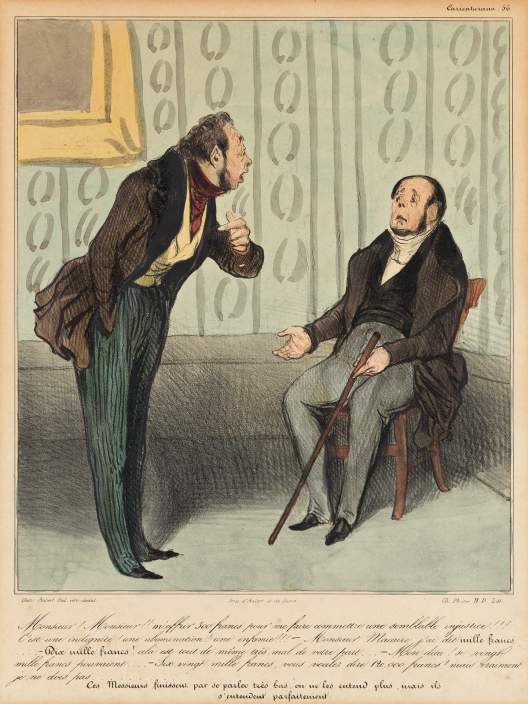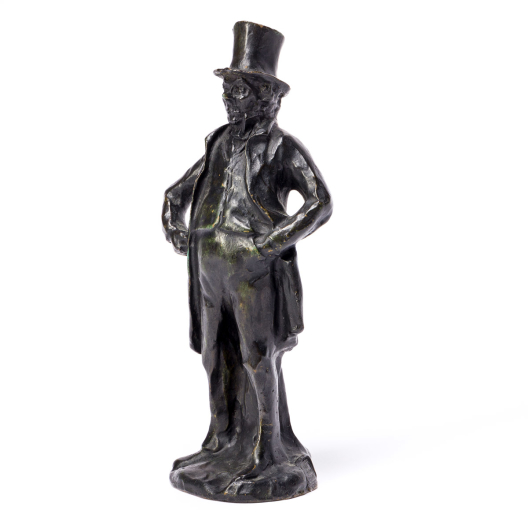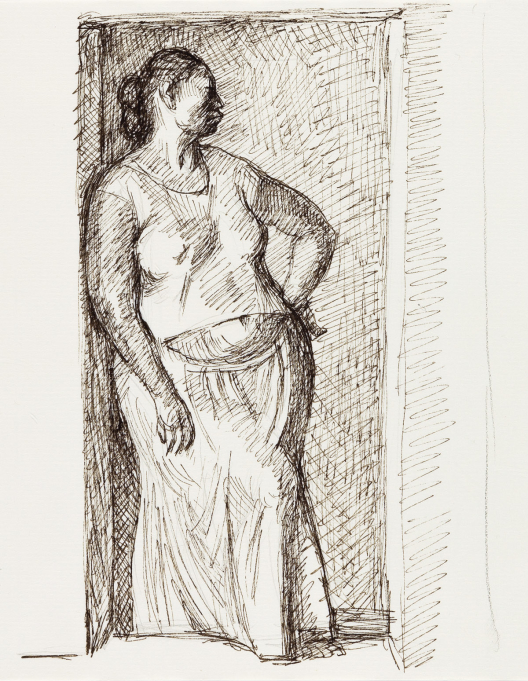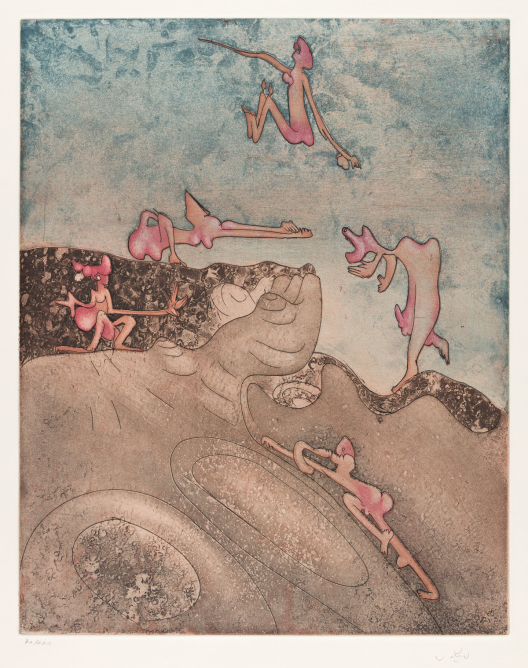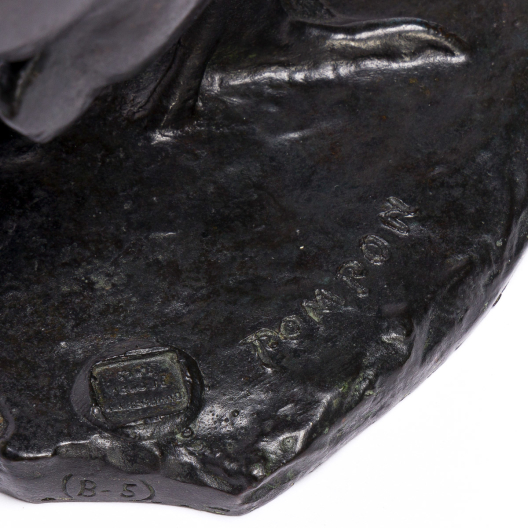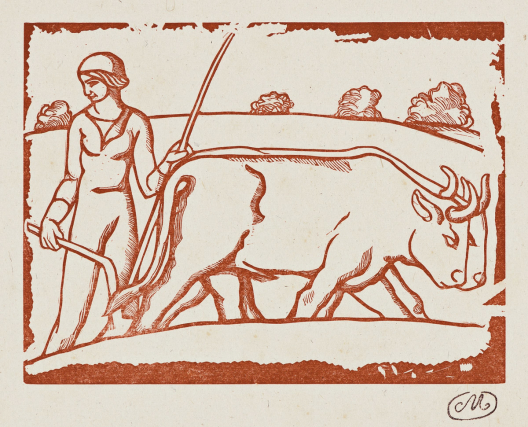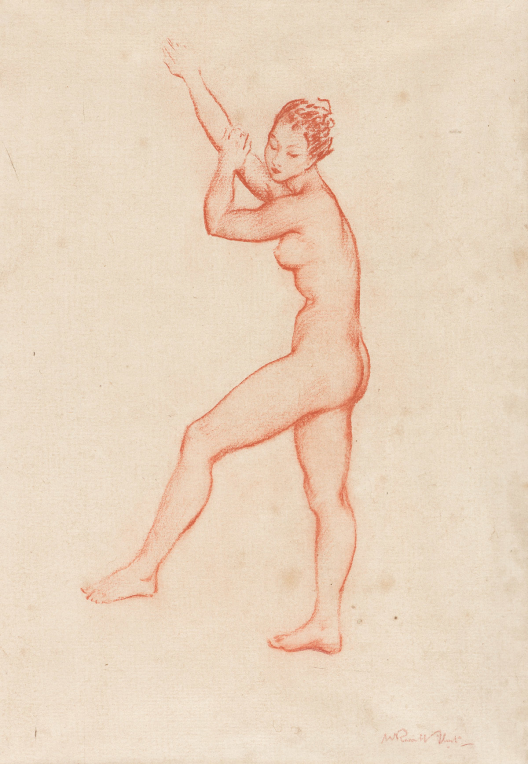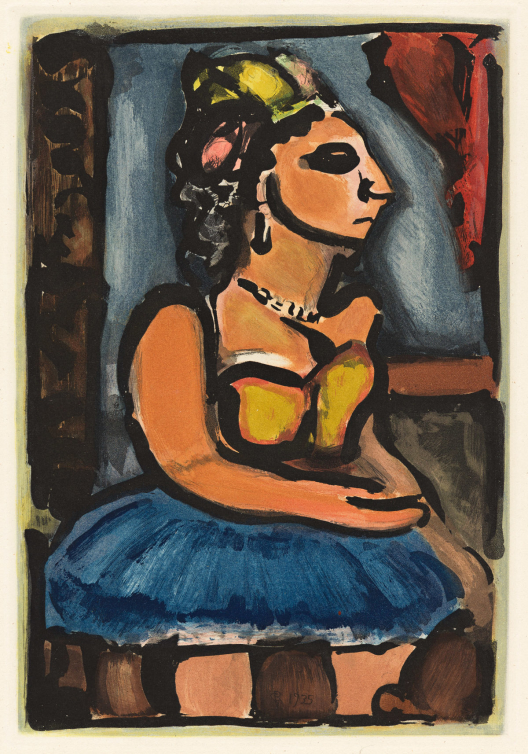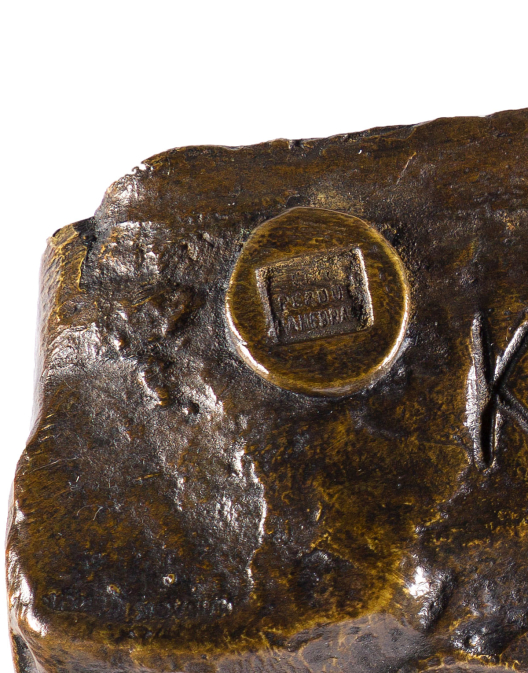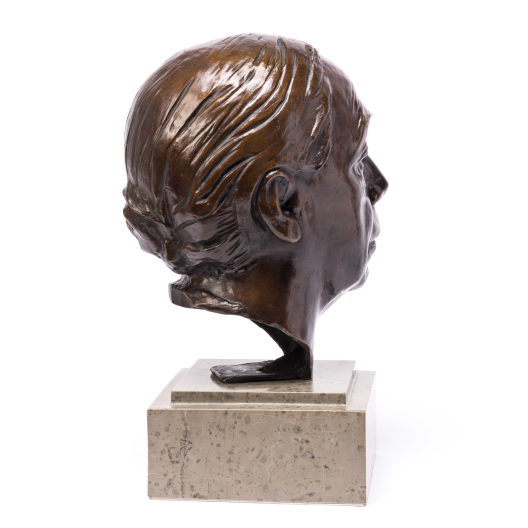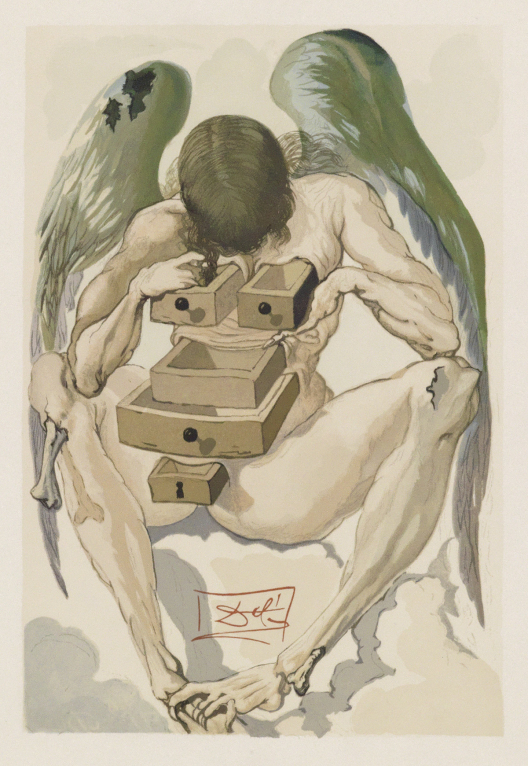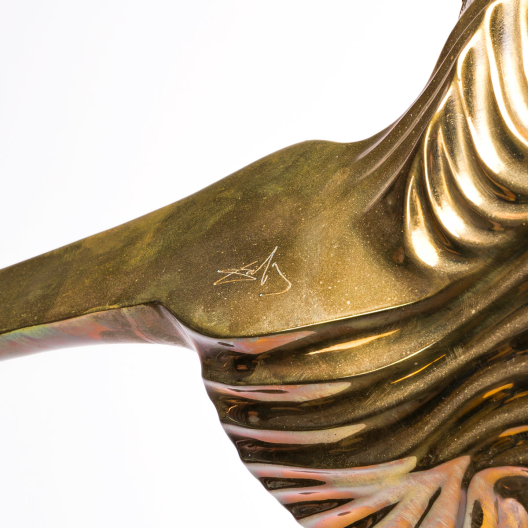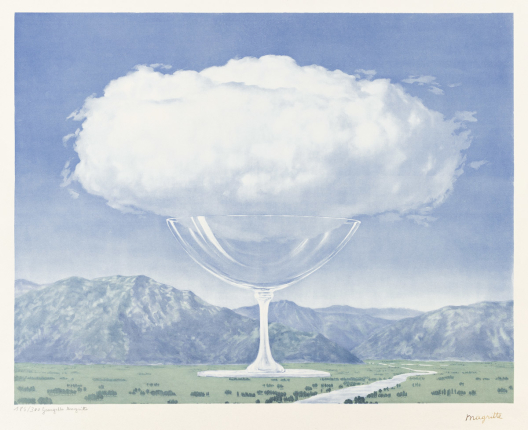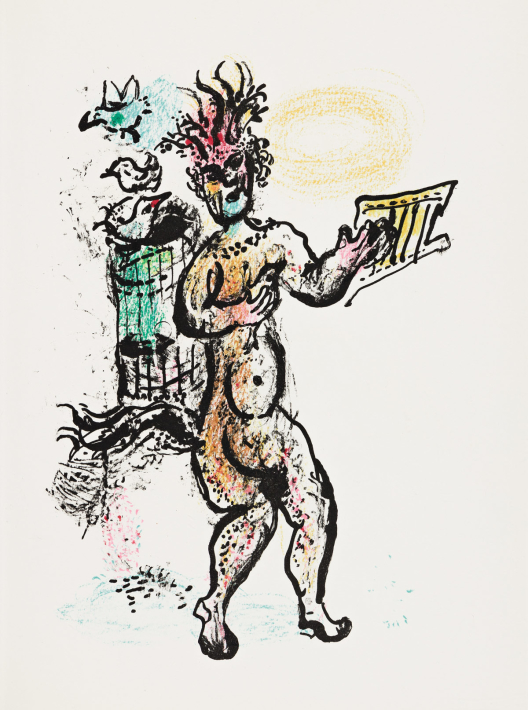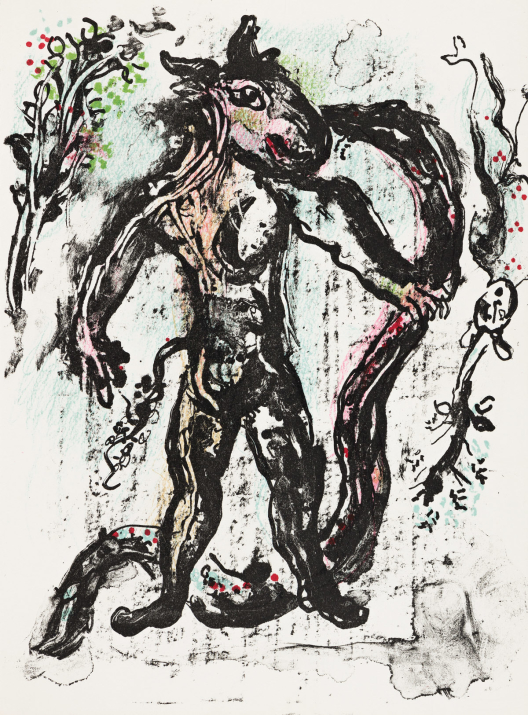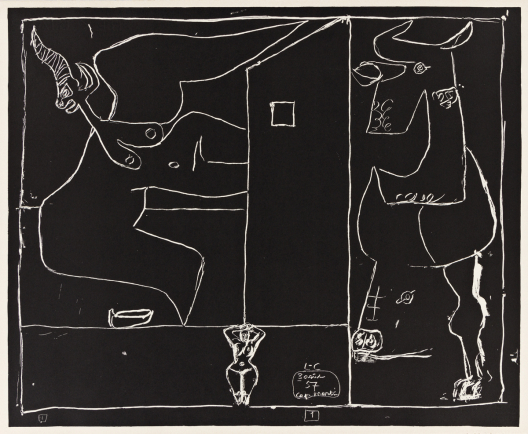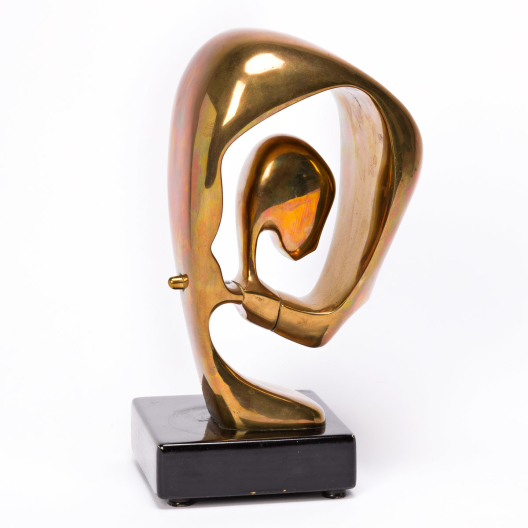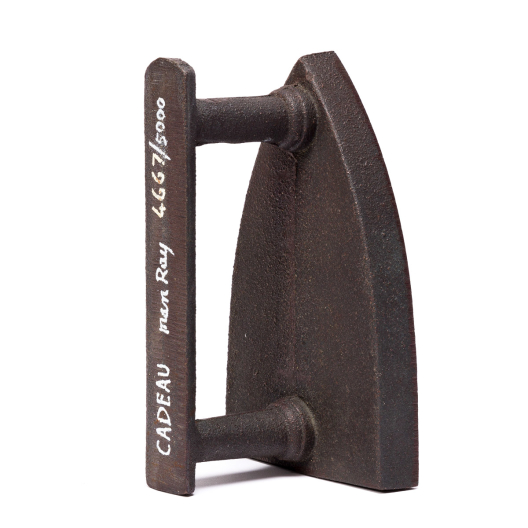
19th & 20th Century Art
Officers

Todd Weyman
Vice President & Director, Prints & Drawings
tweyman@swanngalleries.com
(212) 254-4710 ext. 33

Lisa Crecenzo
Dept. Manager & Client Relations
lcrecenzo@swanngalleries.com
(212) 254-4710 ext. 51

Meagan Gandolfo
Cataloguer
mgandolfo@swanngalleries.com
(212) 254-4710 ext. 58

Sarah McMillan
Cataloguer
smcmillan@swanngalleries.com
(212) 254-4710 ext. 28
George S. Lowry
Chairman
Nicholas D. Lowry
President, Principal Auctioneer
924899
Andrew M. Ansorge
Vice President & Controller
Alexandra Mann-Nelson
Chief Marketing Officer
2030704
Todd Weyman
Vice President & Director, Prints & Drawings
1214107
Nigel Freeman
Vice President & Director, African American Art
Rick Stattler
Vice President & Director, Books & Manuscripts
Administration
Andrew M. Ansorge
Vice President & Controller
aansorge@swanngalleries.com
Ariel Kim
Client Accounting
akim@swanngalleries.com
Diana Gibaldi
Operations Manager
diana@swanngalleries.com
Kelsie Jankowski
Communications Manager
kjankowski@swanngalleries.com
Shannon Licitra
Shipping Manager
slicitra@swanngalleries.com
19th Century European



Anton raphael mengs
Selbstbildnis.

Black chalk on tan wove paper, circa 1750. 200x190 mm; 7⅞x7½ inches. Signed in chalk, lower left recto.
Provenance: Elizabeth Hamilton-Jeffrey Wortman, Inc., New York; sold to private collection, New York, October 1989.
Mengs (1728-1779) was born in Bohemia, present-day Czech Republic, to a family of artists. His father, who trained him, was a court painter in Dresden. In 1740, Mengs moved with his father to Rome, where the young artist learned to emulate Raphael and Correggio and established himself as a precocious talent. Mengs moved back to Dresden in 1744 to build his career before settling in Rome in 1752, where he stayed for the rest of his life. With art historian and Hellenist Johann Joachim Winckelmann, Mengs helped to revive interest in classical antiquity. Mengs heralded Neoclassicism, the style championed by artists into the early 19th century and beyond. This pared down, simplistic style rooted in symmetry, was also practiced by Jacques-Louis David (1748-1825) and Jean-Auguste-Dominique Ingres (1780-1867).
Estimate
$5,000 – $8,000



François marius granet
Santa Maria dell’Immacolata Concezione, Roma.

Oil on canvas, circa 1814. 476x376 mm; 18¾x14¾ inches.
Provenance: Private collection, New York.
Granet (1775-1849) was a French painter and curator known for his paintings of church and convent interiors. He was born in Aix-en-Provence, studied art in France, and relocated to Italy where he lived for 21 years as a member of a French artist community, including Neoclassical painters Jean-Auguste-Dominique Ingres (1780-1867) and François-Xavier Fabre (1766-1837). Granet created this composition during Napoleon’s occupation of Rome, when the Capuchin order had been banished from the seventeenth-century church in the city center. Granet mourned the peaceful cloister before it was dissolved and sought to capture its serenity. Among his most favored subjects, he claimed that he painted different iterations of Santa Maria dell’Immacolata Concezione at least fifteen times.
Estimate
$5,000 – $8,000



Joseph m. w. turner
Jason.

Etching and engraving printed in dark brown, 1807. 184x260 mm; 7¼x10¼ inches, full margins. Second state (of 5). From Liber Studiorum. A superb, richly-inked, early impression.
Jason is part of a series of 81 prints created by Turner (1775-1851) and other printmakers, after his oils, that have come to be known as the Liber Studiorum (Book of Studies, in Latin). This series is based on original watercolors by Turner derived from his paintings, essentially a visual catalogue raisonné of all his works.
History, literature and myth were profound sources of inspiration for Turner. This particular composition derives from Apollonius Rhodius’s epic Greek poem, Argonautica, written in the 3rd century BCE. The tale chronicles mythical Greek hero Jason and his voyage to retrieve the legendary Golden Fleece. In Turner’s depiction, Jason scales a fallen tree to approach the dragon guarding the Fleece. Argonautica profoundly influenced Latin poets like Catullus and Ovid, and it served as a framework for Virgil’s Roman national epic, the Aeneid. Finberg 6.
Estimate
$1,500 – $2,500



Joseph m. w. turner
Calm.

Etching, aquatint and mezzotint printed in dark brown, 1812. 178x267 mm; 7x10½ inches, full margins. First state (of 7). From Liber Studiorum. A superb, richly-inked and early impression.
Calm is part of a series of 81 mezzotints created by Turner (1775-1851) and other printmakers, after his oils, that have come to be known as the Liber Studiorum (Book of Studies, in Latin). The “M” in the top margin of this print indicates Turner’s category of Marine landscape. The Liber Studiorum mezzotints are based on original watercolors by Turner derived from his paintings, essentially a visual catalogue raisonné of all his works. It’s assumed that Turner approved of the mezzotint process as it simulated the appearance of watercolor on moist paper and, in recognition of their commercial viability. The 1820 introduction of steel mezzotint plates (as opposed to copper, which produced very limited quality impressions before the plate wore down and required reworking) may have prompted him to issue these prints. Finberg 44.
Estimate
$2,000 – $3,000



William blake
And When They Lifted Up Their Eyes Afar Off.

Engraving on Chine collé, 1825. 217x170 mm; 8¾x6¾ inches, full margins. Edition of 215, an early impression with the word “Proof” engraved lower right. Published by the artist and J. Linnell, London. From Illustrations of the Book of Job. A superb, richly-inked impression with strong contrasts. Bindman 631.
Estimate
$2,500 – $3,500



William blake
There Were not Found Women Fair as the Daughters of Job.

Engraving on Chine collé, 1825. 220x172 mm; 8⅝x6¾ inches, full margins. Edition of 215, an early impression with the word “Proof” engraved in the plate lower right. Published by the artist and J. Linnell, London. From Illustrations of the Book of Job. A very good, richly-inked impression with strong contrasts. Bindman 644.
Estimate
$2,500 – $3,500



Jean-auguste-dominique ingres
Gabriel Cortois de Pressingny.

Etching 1816. 285x193 mm; 11¼x7⅝ inches, wide margins three sides, the upper margin trimmed just inside the border line. A superb impression of this extremely scarce etching, with strong contrasts and no sign of wear. Delteil 1.
Estimate
$2,000 – $3,000



Eugène delacroix
Feuille d’études, avec Héliodore vaincu du Temple, pour St. Sulpice.

Pencil on paper, circa 1849-50. 450x276 mm; 17¾x10⅞ inches. With the artist’s red ink stamp (Lugt 838a, lower right recto).
Provenance: Jacques Fischer, Paris; Eric Carlson, New York; private collection, New York, 2006.
Exhibited: “Eugène Delacroix, Paintings and Drawings; Peter Paul Rubens, Three Oil Sketches,” Salander-O’Reilly Galleries, New York, November 15-December 30, 1989, with the label.
Estimate
$3,000 – $5,000



Théodore géricault
Jument noire à l’Écurie.

Oil on paper laid down on canvas, circa 1815. 230x315 mm; 9x12½ inches.
Provenance: Georges Renand, Paris; Marlborough Fine Art, London; Marlborough Gallery, New York.
Exhibited: “Géricault Peintre et Dessinateur,” Galerie Bernheim-Jeune & Cie., Paris, May 1937, with the label.
Published: Grunchec, Tout l’oeuvre peint de Géricault Milan and Paris, 1978, catalogue number A5 (illustrated); Bazin, Théodore Géricault: Étude critique, documents et catalogue raisonné, Paris, 1987-97, volume 3, page 140, catalogue number 697 (illustrated; alternatively titled Cheval à l’écurie).
Estimate
$10,000 – $15,000

Honoré daumier
Un Français peint par lui-même.

Lithograph, 1849. 340x263 mm; 13⅜x10⅜ inches (sheet), wide margins. From the deluxe edition sur blanc, before the large published edition with text verso. Printed and published by Aubert et Cie, Paris. From Scènes d’Ateliers. A very good impression. Delteil 2526.
With—Mission pénible et délicate du professeur de dessin…, lithograph, 1853. 180x241 mm; 7⅛x9½ inches, wide margins. From the deluxe edition sur blanc, before the large published edition with text verso. Printed and published by Aubert et Cie, Paris. From Profésseurs et Moutards. Delteil 1468.
Estimate
$1,500 – $2,500



Honoré daumier
En Chemin de Fer . . . Un Voisin agréable.

Lithograph, 1862. 195x242 mm; 7¾x9½ inches, full margins. The deluxe edition sur blanc, before the large published edition with text verso. Printed by Bertauts, Paris. From Souvenirs d’Artistes. A very good impression. Delteil 3252.
Estimate
$1,500 – $2,500

Honoré daumier
Collection of 12 lithographs.

Including three with hand coloring in watercolor. Each from the deluxe edition sur blanc, before the large published editions with text verso. Various sizes and conditions. Very good impressions. Delteil 66, 109, 591, 656, 1220, 1504, 1546, 1670, 2582, 3231, 3417 and 3437.
Estimate
$2,000 – $3,000

Honoré daumier
Group of 6 lithographs with hand coloring in watercolor.

Monsieur! Monsieur!! M’offrir 500 francs . . ., 1837 * Mon cher! Vous vous êtes admirablement . . ., 1838 * Des preuves! . . ., 1838 * (Le Président, impatienté) Au fait, maitre Barbotteau . . . , 1838 * Mr. l’avocat a rendu pleine justice. . . ., 1846 * Au Café D’aguesseau, 1846. Various sizes and conditions. Very good impressions with strong colors. Delteil 411, 486, 490, 493, 1352 and 1359.
Daumier (1808-1879), a prolific caricaturist, printmaker, painter and sculptor, demonstrated an artistic inclination at a young age. He quickly became a protégé of the classicist painter Alexandre Lenoir (1761-1839), and further advanced his artistic training by enrolling in the Acadèmie Suisse, Paris. Daumier mastered the technique of lithography early on in his career, and published his first (of several hundred) lithographs in the satirical periodical La Silhouette in 1829.
Estimate
$1,500 – $2,500

Honoré daumier
Le Monsieur qui ricane.

Bronze, modeled circa 1860 (cast later). 185 mm; 7¼ inches (height). Incised with the artist’s initials and numbered 22/30, lower verso. With the foundry mark Cire perdue Valsuani, lower verso.
Provenance: Private collection, Paris; private collection, New York.
Published: Gobin, Daumier Sculpteur, 1808-1879: Avec un Catalogue Raisonné et illustré de l’oeuvre sculpté, Geneva, 1952, page 261, number 47 (the terracotta illustrated); Wasserman, Daumier Sculpture. A Critical and Comparative Study, Cambridge, MA, 1969, page 230, number 55 (the terracotta and another bronze cast illustrated).
In addition to his work as a lithographer, draughtsman and painter, Daumier (1808-1879) produced more than 100 sculptures during his long and highly prolific career. He produced many of these sculptures in unbaked clay, some of which were subsequently reproduced in plaster casts for preservation. Bronze editions were all produced posthumously, the artist conceived no bronze editions during his lifetime, by various foundries including Barbedienne, Rudier, Siot-Decauville and Valsuani, from models in the collections of the Galerie Sagot-Le Garrec, Paris, and Gobin, Paris, including the renowned series of thirty-six bust portraits of French members of Parliament. The majority of the terracotta figures are now in the collection of the Musée d’Orsay, Paris.
Estimate
$7,000 – $10,000

Honoré daumier
Le Bourgeois qui flâne.

Bronze, modeled circa 1860 (cast later). 180 mm; 7 inches (height). Incised with the artist’s initials and numbered 13/30, lower verso. With the foundry mark Cire perdue Valsuani, lower verso.
Provenance: Private collection, Paris; private collection, New York.
Published: Gobin, Daumier Sculpteur, 1808-1879: Avec un Catalogue Raisonné et illustré de l’oeuvre sculpté, Geneva, 1952, page 271 (another cast illustrated).
In addition to his work as a lithographer, draughtsman and painter, Daumier (1808-1879) produced more than 100 sculptures during his long and highly prolific career. He produced many of these sculptures in unbaked clay, some of which were subsequently reproduced in plaster casts for preservation. Bronze editions were all produced posthumously, the artist conceived no bronze editions during his lifetime, by various foundries including Barbedienne, Rudier, Siot-Decauville and Valsuani, from models in the collections of the Galerie Sagot-Le Garrec, Paris, and Gobin, Paris, including the renowned series of thirty-six bust portraits of French members of Parliament. The majority of the terracotta figures are now in the collection of the Musée d’Orsay, Paris.
Estimate
$7,000 – $10,000



Jean-françois millet
La Veillée.

Etching, 1855-56. 151x110 mm; 6¼x4½ inches, full margins. Second state (of 2), with rounded plate corners. A superb impression of this extremely scarce, early etching.
We have found only 3 other impressions of this etching at auction in the past 30 years.
This is one of two etchings Millet (1814-1875) created, among eight different subjects, during his first productive burst with the printmaking technique which were the only ones not published. According to the art critic Philippe Burty, who wrote in the Gazette des Neaux-Arts, “Either because the varnish was badly prepared or because the acid was too violent, the metal was attacked so deeply that in printing it gave only a heavy image and was canceled after a few trial proofs.” Melot cites five impressions in public collections, including the Art Institute of Chicago (two impressions), the New York Public Library, and the Bibliothèque Nationale, Paris (two impressions). Delteil 14; Melot 14.
Estimate
$2,000 – $3,000



Jean-françois millet
Le Semeur.

Lithograph printed in brownish black on antique, cream laid paper, 1851. 192x156 mm; 7⅝x6⅛ inches, full margins. Third state (of 3). A superb, dark impression with strong contrasts and with all the subtle tonal variations distinct. Delteil 22; Melot 22.
Estimate
$7,000 – $10,000



Jean-baptiste-camille corot
Environs de Rome.

Etching and drypoint, 1866. 284x210 mm; 11¼x8¼ inches, full margins. Third state (of 3). A very good, dark, richly-inked impression. Delteil 6; Melot 6.
Estimate
$1,500 – $2,500



Jean-baptiste-camille corot
Souvenir d’Italie.

Etching and drypoint, 1863. 294x220 mm; 11½x8¾ inches, full margins. Second state (of 4). Printed by Delâtre, Paris. Published by Cadart and Chevalier, Paris, with the blind stamp (Lugt 3270, lower center). A brilliant, richly-inked and early impression with strong contrasts and no sign of wear. Delteil 5; Melot 5.
Estimate
$1,500 – $2,500



Jean-baptiste-camille corot
La Rêverie.

Cliché-verre, 1854. 148x193 mm; 5¾x7½ inches, small margins. Numbered 127/150 in pencil, verso. Published by Le Garrec, with the ink stamp (Lugt 1766a, verso). A very good impression of this scarce print. Delteil 43; Melot 43.
Estimate
$1,500 – $2,500



Jean-baptiste-camille corot
Paysage.

Oil on canvas. 255x340 mm; 10⅛x13⅜ inches. Signed in oil, lower left recto.
Provenance: Private collection, California; private collection, Skokie, Illinois.
Estimate
$25,000 – $35,000



Henri-joseph harpignies
Bords d’un Etang.

Oil on canvas, 1849. 180x260 mm; 7x10¼ inches. Signed and dated in oil, lower left recto.
Provenance: Marlborough International Fine Art, London; Marlborough Gallery, New York.
Exhibited: “Harpignies: Paintings-Watercolors-Drawings,” Marlborough Fine Art, London, February-March, 1957.
Estimate
$2,500 – $3,500



Henri-joseph harpignies
Environs de Roisin.

Oil on canvas, 1847. 455x610 mm; 18x24 inches. Signed and dated in oil, lower left recto.
Provenance: Marlborough International Fine Art, London; Marlborough Gallery, New York, with the label on the frame back.
Exhibited: “Harpignies: Paintings-Watercolors-Drawings,” Marlborough Fine Art, London, February-March, 1957, number 1.
Estimate
$7,000 – $10,000



Henri-joseph harpignies
Un Bien Aller dans la Foret du Troncais.

Oil on canvas. 810x1015 mm; 31⅞x40 inches. Signed in oil, lower left recto.
Provenance: Sold Christie's, New York, November 1, 1999, sale 9248, lot 56; Marlborough Gallery, New York, with the label on the frame back.
Exhibited: "Harpignies: Paintings-Watercolors-Drawings," Marlborough Fine Art, London, February-March, 1957, number 30.
Estimate
$10,000 – $15,000

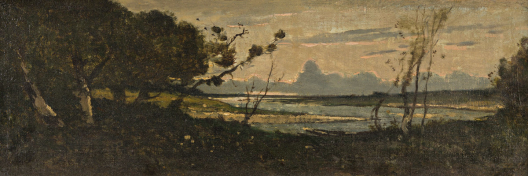

Henri-joseph harpignies
La Loire à Briare.

Oil on canvas, 1896. 190x550 mm; 7¾x21¾ inches.
Provenance: Marlborough International Fine Art, London; Marlborough Gallery, New York.
Exhibited: "Harpignies: Paintings-Watercolors-Drawings," Marlborough Fine Art, London, February-March, 1957, number 11, with the label on the frame back.
Estimate
$3,000 – $5,000

Charles meryon
Two etchings.

Le Pavillon de Mademoiselle et une partie du Louvre, 1849. 122x247 mm; 4⅞x9¾ inches, full margins. Fourth state (of 4) * La Pompe Notre-Dame, 1852. 166x255 mm; 6½x10 inches, wide margins. Tenth state (of 10). Both very good impressions. Schneiderman 12 and 26.
Estimate
$1,200 – $1,800



James a. m. whistler
Street at Saverne.

Etching and open-bite printed in dark brownish black on light tan Chine collé on Japan paper, 1858. 208x158 mm; 8¼x6¼ inches, full margins. MacDonald’s fourth state (of 4). Printed by Delâtre, Paris. From Douze Eaux-fortes d’après Nature. A brilliant, luminous, richly-inked and early impression. Kennedy 19; Glasgow 14.
Estimate
$1,000 – $1,500



James a. m. whistler
The Dog on the Kennel.

Etching on cream wove ledger paper, 1858. 71x89 mm; 2¾x3½ inches, full margins. MacDonald’s second state (of 2), with the shading lines above the dog reduced. A superb, richly-inked impression of this very scarce, early etching, with crisp plate edges.
MacDonald cites 20 known impressions; we have found only 10 impressions at auction in the past 30 years. Kennedy 18; Glasgow 19.
Estimate
$1,500 – $2,500



James a. m. whistler
Soupe à trois sous.

Etching and drypoint on cream laid Japan paper, 1859. 154x230 mm; 6⅛x9⅛ inches, full margins. A superb, richly-inked impression with crisp, inky plate edges. Kennedy 49; Glasgow 64.
Estimate
$1,500 – $2,500



James a. m. whistler
The Pool.

Etching and drypoint on antique cream laid paper, 1859. 138x212 mm; 5½x8⅜ inches, full margins. MacDonald’s sixth state (of 6). Proprietary watermark. A very good, richly-inked impression with strong contrasts. Kennedy 43; Glasgow 49.
Estimate
$1,500 – $2,500



James a. m. whistler
Billingsgate.

Etching and drypoint printed in dark brownish black, 1859. 148x224 mm; 5¾x8⅝ inches, full margins. MacDonald’s ninth state (of 9), before cancellation. A very good impression with strong contrasts. Kennedy 47; Glasgow 51.
Estimate
$1,200 – $1,800



James a. m. whistler
Hurlingham.

Etching and drypoint on antique cream laid paper, 1879. 138x201 mm; 5½x7¾ inches, wide margins. MacDonald’s fourth state (of 4). A very good impression with strong contrasts and all the details distinct. Kennedy 181; Glasgow 184.
Estimate
$1,500 – $2,500



James a. m. whistler
The Little Putney, No. 2.

Etching and drypoint printed in dark brownish black on antique cream laid paper, 1879. 124x200 mm; 4⅞x7⅞ inches, full margins. MacDonald’s third state (of 3), with the addition of text in drypoint lower left. According to MacDonald, one of approximately only 23 known impressions. A superb, richly-inked impression of this extremely scarce etching. Kennedy 23; Glasgow 187.
Estimate
$1,500 – $2,500



James a. m. whistler
St. James’s Street.

Etching and drypoint printed in dark brownish black on antique cream laid paper, 1878. 275x152 mm; 10⅞x6 inches, full margins. MacDonald’s fourth state (of 4), before cancellation. Edition of approximately only 30. A superb, early, richly-inked impression of this scarce etching, with very strong contrasts and with the delicate drypoint clouds in the sky and the butterfly signature lower left distinct.
Whistler (1834-1903) drew this scene directly on an etching plate, from a balcony at the Albemarle Hotel looking down St. James’s Street. The etching was commissioned by Vanity Fair, where it was ultimately reproduced by lithographic transfer; Whistler used the commission to help offset financial troubles stemming from the libel suit against the art critic John Ruskin. Kennedy 169; Glasgow 178.
Estimate
$1,500 – $2,500



James a. m. whistler
The Venetian Mast.

Etching and drypoint on antique cream laid paper, 1879-80. 340x165 mm; 13½x6½ inches, wide margins. MacDonald’s sixth state (of 12). Signed with the large shaded butterfly and inscribed “imp” in pencil, lower left. Partial Strasburg Lily watermark. From Twelve Etchings. A superb, richly-inked and early proof impression with selective wiping around the rightmost figure.
Provenance: Henry Harper Benedict, New York, with the black ink stamp (Lugt 2936, verso); Charles C. Cunningham, Jr., New England, with the brown ink stamp (Lugt 4684, verso).
According to MacDonald, “The etching went through many states before Whistler was satisfied. In 1880 and 1881, he printed on paper with wide margins. As late as the sixth and seventh states, impressions are signed with the large, veined butterfly of 1881.” Kennedy 95; Glasgow 219.
Estimate
$5,000 – $8,000



James a. m. whistler
The Little Lagoon.

Etching and drypoint printed in dark brownish black on antique cream laid paper, 1880. 230x153 mm; 9¼x6 inches. MacDonald’s third state (of 4). Signed with the butterfly and inscribed “imp” in pencil on the tab, lower left. From Twelve Etchings. A brilliant, early and richly-inked impression with warm plate tone and selective wiping. Kennedy 186; Glasgow 216.
Estimate
$7,000 – $10,000

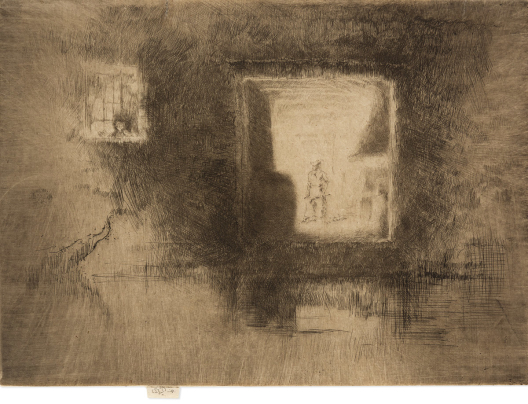

James a. m. whistler
Nocturne: Furnace.

Etching and drypoint printed in dark brownish black on antique laid paper, 1879-80. 166x231 mm; 6⅝x9⅛ inches. MacDonald’s eleventh state (of 12). Edition of approximately 46. Signed with the butterfly and inscribed “imp” in pencil on the tab, lower left. From Twenty-Six Etchings. A superb, well-inked impression with selective wiping inked in the manner of a monotype and all the fine lines distinct.
Provenance: Tracy Dows, New York, with the ink stamp (Lugt 2427, verso). Kennedy 213; Glasgow 208.
Estimate
$7,000 – $10,000



James a. m. whistler
The Village Sweet Shop.

Etching printed in dark brownish black on antique cream laid paper, 1886. 82x124 mm; 3¼x4⅞ inches. Edition of approximately only 14. Signed with the butterfly and inscribed “imp” in pencil on the tab, lower left. A superb impression of this extremely scarce etching.
We have found only 5 other impressions at auction in the past 30 years.
It is speculated that Whistler etched this scene in the small town of Sandwich, Kent, in the south of England. Whistler made several etchings there including Salvation Army, Sandwich, Double Doorway, Sandwich and Doorway, Sandwich (Glasgow 319, 322-23). Whistler etched many street scenes of local businesses and storefronts. He painted a similar subject, An Orange Note: Sweet Shop a few years prior to this etching. Lochnan comments, “Whistler’s developing interest in transparency and translucency was explored in the etching of sweets barely visible through the glass of the shop windows” (Lochnan 250). Kennedy 251; Glasgow 266.
Estimate
$4,000 – $6,000



James a. m. whistler
Melon-Shop, Houndsditch.

Etching and drypoint printed in dark brownish black on cream laid paper, 1887. 125x173 mm; 4⅞x6⅞ inches, full margins. MacDonald’s second state (of 5). Signed with the butterfly and inscribed “imp.” in pencil on the tab, lower left. A superb impression of this very scarce, early proof.
MacDonald notes only 10 known impressions in all five states combined.
Provenance: John H. Wrenn, Chicago, with the ink stamp (Lugt 1475, verso). Kennedy 293; Glasgow 355.
Estimate
$4,000 – $6,000

James a. m. whistler
Maunder’s Fish Shop, Chelsea.

Lithograph, 1890. 280x225 mm; 11x8¾ inches, full margins. Second state (of 2). Edition of approximately only 33 printed by Goulding in 1903, aside from the edition of approximately 30-40 impressions printed by Way, London. A very good impression. Way 28; Levy 42; Spink 37.
With—Mother and Daughter (La Mère Malade), lithograph on Chine volant, 1897. 187x158 mm; 7x6¼ inches, full margins. Edition of approximately 200. Printed by Auguste Clot, Paris. Levy 77; Spink 174.
This lithograph depicts Whistler’s (1834-1903) mother-in-law, Frances Birnie Philip, and one of his sisters-in-law, probably Ethel Whibley, in the drawing room at Whistler’s house on the rue de Bac in Paris.
Estimate
$2,000 – $3,000



James a. m. whistler
The Dancing Girl.

Lithograph, 1889. 182x148 mm; 7¼x5¾ inches, full margins. Edition of approximately only 32. Signed with the butterfly and inscribed “No. 16” in pencil, lower margin. Printed by Way, London.
According to Spink, et als, apparently Whistler’s (1834-1903) “first representation in lithography of the female figure in motion.” They cite one other impression similarly signed and annotated with a number in Whistler’s hand, now in the Hunterian Museum, University of Glasgow. A superb, early impression of this very scarce lithograph, with the dark inking along the edge of the robe near the right arm and with all the subtle tonal variations distinct. Way 30; Levy 45; Spink 29.
Estimate
$4,000 – $6,000



James a. m. whistler
Nude Model, Reclining.

Lithograph on antique cream laid paper, 1893. 115x214 mm; 4½x8½ inches, full margins. Third state (of 3), with the crescent-shaped spot in the highlighted area on the model’s left shoulder removed. Edition of approximately only 41 posthumous impressions printed by Goulding in 1904 (aside from the lifetime edition of approximately 25) for Rosalind Bernie Philip, the artist’s sister-in-law. Strasburg Lily watermark. A superb, richly-inked impression of this scarce lithograph, with all the tonal variations distinct and with strong contrasts. Way 47; Levy 75; Spink 73.
Estimate
$2,000 – $3,000



James a. m. whistler
Firelight: Joseph Pennell, No. 1.

Lithograph on cream laid paper, 1896. 167x140 mm; 6½x5½ inches, wide margins. Fortune Figure watermark. Printed by Way, London. Published by T. Fisher Unwin, London and The Century Co., New York. From Lithography and Lithographers. A very good impression. Way 104; Levy 152; Spink 144.
Estimate
$1,000 – $1,500



James a. m. whistler
Reading.

Lithograph on cream laid appliqué on heavy wove paper, 1879-87. 213x162 mm; 8⅝x6½ inches, full margins. Fourth state (of 4). Edition of approximately 100 for Notes. Signed with the butterfly in pencil, lower right. Printed by Way, London. Published by Boussod, Valadon, et Cie., Paris. A superb impression with the strong black lines on the hat and the contours of the drapery distinct. Way 13; Levy 25; Spink 17.
Estimate
$2,000 – $3,000

James a. m. whistler
Waterloo Bridge.

Lithograph on ivory laid paper, 1896. 172x127 mm; 6¾x5 inches, full margins. Edition of approximately 28. A very good impression of this scarce lithograph with all the details distinct.
Waterloo Bridge is one of 8 lithographs drawn by Whistler (1834-1903) while he and his wife Beatrix resided at the Savoy Hotel in London in February and March 1896. Beatrix had been diagnosed with cancer in 1894 and was ill through 1895, with her condition worsening during the early months of 1896. She died on May 10th, 1896. Whistler’s years of marriage with Beatrix, whom he nicknamed “Trixie,” were among the happiest of his life. He was devasted with her passing.
Their rooms at the Savoy Hotel were on the top floor, which afforded Whistler views of the Embankment and the Thames. He spent much of his time during these painful months at his wife’s bedside and drawing from the balconies of their suite.
With—Old Battersea Bridge, lithograph, 1879. 144x332 mm; 5¾x13 inches, full margins. Second state (of 2). Edition of 100. Published by Boussod, Valadon, et Cie., Paris. From Notes. Way 12 and 123; Levy 24 and 177; Spink 18 and 156.
Estimate
$2,500 – $3,500



James a. m. whistler
The Thames.

Lithotint with scraping, 1896. 267x196 mm; 10½x7¾ inches, full margins. Third state (of 3). Edition of only 12 in this state, from a total edition of approximately 30 (in all 3 states). Printed by Henry Bray at T. R. Way, London. A brilliant, luminous impression, with all the subtle tonal variations distinct.
This is among Whistler’s (1834-1903) most technically complicated lithographs, created over several months in early 1896 during which Whistler and his dying wife, Beatrix, occupied upper floor rooms at the Savoy Hotel overlooking the Thames River, London. Whistler’s extraordinary dedication to this image, was recognized by his printer, T. R. Way, who noted that, “He knew what he wanted to get, and nothing short of it would satisfy him, even if the work had to be done over and over again; no trouble was too great for him to take” (Spink, p. 454). Way 125; Levy 180; Spink 161.
Estimate
$8,000 – $12,000



Félix buhot
Une Matinée d’Hiver au Quai de l’Hotel Dieu.

Etching and drypoint on Chine collé, 1876. 237x320 mm; 9½x12⅝ inches, full margins. Fifth state (of 15). Signed in pencil, lower left. A very good impression in the first published state of this popular subject. Bourcard/Goodfriend 123.
Estimate
$1,200 – $1,800



Félix buhot
Une Matinée d’Automne.

Etching and drypoint, 1882. 107x167 mm; 4¼x6⅝ inches, full margins. Third state (of 4). Edition of approximately 35. A superb, atmospheric impression of this very scarce etching.
With— Group of 4 etchings with drypoint. L’Hiver à Paris * La Fête Nationale au Boulevard Clichy * Les Bergeries, Soleil Couchant * Frontispiece pour Les Graveurs du XIXe siècle, de Henri Béraldi. Various sizes and conditions. Bourcard/Goodfriend 71, 123, 127, 151 and 164.
Estimate
$1,500 – $2,500



Edward lear
Black Mountain, Cephalonia.

Watercolor on wove paper, circa 1863. 260x360 mm; 10¼x14¼ inches. Initialed and titled in pencil, lower right recto, and annotated “4” in pencil, upper left recto.
Provenance: Private collection, Massachusetts.
Estimate
$3,000 – $5,000

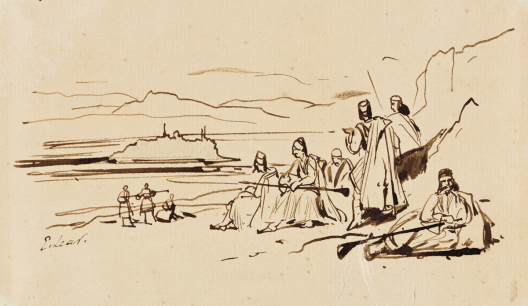

Edward lear
Bedouin Soldiers Resting on a Hillside.

Pen and brown ink on wove paper. 117x188 mm; 4¾x7½ inches. Signed in ink, lower left recto.
Provenance: Private collection, Chicago.
Estimate
$1,500 – $2,500



Rodolphe bresdin
Un Groupe de Baigneueuses dans un Paysage rocheux.

Pen and ink on off-white tracing paper mounted on cream wove paper, circa 1860. 128x153 mm; 5¼x6¼ inches. Initialed in ink, lower right recto.
Provenance: Private collection, New York; with Michael Altman Fine Art, New York.
There is a similar pen and ink drawing of bathers in a landscape by Bresdin (1825-1885) now in the Art Institute of Chicago (inventory number 1949.48).
Estimate
$10,000 – $15,000



Carl spitzweg
Sheet of Studies.

Charcoal on paper. 320x241 mm; 12⅝x9½ inches. Signed in pencil, upper left verso.
Provenance: Private collection, New York.
Several of the sketches on this lively sheet of studies might relate to Spitzweg’s oil painting Türken in einem Kaffeehaus, circa 1855, now in the Sammlung Schack, Munich.
Spitzweg (1808-1885) was a German romanticist painter of the Biedermeier era. He was originally trained as a pharmacist, studying at the University of Munich, but dedicated himself fully to painting upon receiving an inheritance and recovering from an illness. Spitzweg was a self-taught painter and traveled widely through Europe studying art independently. The Biedermeier style flourished in Central Europe from 1815 to 1848, a time where the middle class grew and art reflected an air of leisure and comfort of the time. Spitzweg’s work, and Biedermeier art in general, commonly depicted warm, idyllic and sentimental genre scenes of middle class life.
Estimate
$1,000 – $1,500

Gustave doré
Dante Faints at the Story of Paolo and Francesco.

Pencil on cream laid paper, circa 1855-60. 321x198 mm; 12¾x8 inches. With studies of seated women in pencil, possibly for the figure of Beatrice, verso. J. Whatman Turkey Mill and the date 1832 watermark.
Provenance: Private collection, Chicago.
Planned by Doré (1832-1883) as early as 1855, the Dante illustrations were the first in an intended series that he referred to as the chefs-d’oeuvre de la littérature. In addition to Dante, Doré’s list of illustrated great works included Homer, Ossian, Byron, Goethe, Racine and Corneille. The placement of Dante’s Commedia at the top of this list reflects the poet’s popularity within mainstream French culture by the 1850s, and in particular the Romantic infatuation with the love story of Paolo and Francesca.
In the Second Circle of Hell in Dante’s Inferno, Dante and Virgil pass into a dark place in which torrential rains fall ceaselessly and gales of wind tear through the air. The souls of the damned in this circle swirl about in the wind, swept helplessly through the stormy air. These are the lustful—those who committed sins of the flesh. Dante asks Virgil to identify some of the individual souls to him; they include many of great renown, including Helen, for whose sake the Trojan War was fought, and Cleopatra. Dante immediately feels sympathy for these souls, for essentially, they are damned by love. With Virgil’s permission, he calls out to the souls to see if they will speak to him and tell him their story. One woman, Francesca, recognizes Dante as a living soul and answers him. She relates to him how love was her undoing: bound in marriage to an old and deformed man, she eventually fell in love with Paolo da Rimini, her husband’s younger brother. One day, as she and Paolo sat reading an Arthurian legend about the love of Lancelot and Guinevere, each began to feel that the story spoke to their own secret love. When they came to a particularly romantic moment in the story, they could not resist kissing. Francesca’s husband quickly discovered their transgression and had the young lovers killed. Now Paolo and Francesca are doomed to spend eternity in the Second Circle of Hell. Overcome with pity, Dante faints.
Estimate
$1,500 – $2,500



Félicien rops
Femme debout, avec un chien.

Pencil on ivory laid paper, 1861. 295x197 mm; 11⅝x7¾ inches. Initialed and dated “Septembre 1861” in pencil, center recto.
Provenance: Private collection, Lyon, France.
Estimate
$1,200 – $1,800



Édouard manet (after)
Le Déjeuner sur l’herbe.

Color aquatint and etching, 1929. 500x630 mm; 19 ⅝x24⅞ inches, full margins. Signed and numbered 59/200 by Jacques Villon in pencil, lower margin. Etched by Jacques Villon. Published by Galerie Bernheim-Jeune, Paris. A superb, richly-inked impression with vibrant colors.
During the 1920s, Villon (1875-1963) created masterful color prints after paintings by artists as varied as Picasso, Renoir, Rousseau, Bonnard, Signac, Matisse, Dufy, Modigliani and others, along with this work after Manet's seminal painting from 1862-63, now in the Musée d'Orsay, Paris. Ginestet/Pouillon 668 (Villon).
Estimate
$2,000 – $3,000



Édouard manet
Les Gitanos.

Etching, 1862. 320x236 mm; 12½x9¼ inches, full margins. Second state (of 2). The first printing in this state, with the address of the publishers Cadart and Chevalier, Paris, and their blind stamp (Lugt 3270, lower center recto). A superb, richly-inked impression with very strong contrasts and all the fine details distinct.
This is Manet’s (1832-1883) first published etching. It was based on an oil painting of the same subject by Manet, exhibited in 1863 at the Galerie Martinet, Paris, and in 1867 at the temporary pavilion he erected on the avenue de l’Alma near the Exposition Universelle. He subsequently cut the canvas into several fragments, evidently in response to the negative criticism it received. The etching is the only record of the full composition of this now destroyed painting. Guérin 21; Harris 18.
Estimate
$1,500 – $2,500



Édouard manet (after)
Olympia.

Color aquatint and etching, 1926. 407x585 mm; 16⅛x23⅛ inches, full margins. Signed by Jacques Villon and numbered 47/100 in pencil, lower margin. Etched by Jacques Villon. Published by Bernheim-Jeune, Paris. A superb richly-inked impression with strong colors. Ginestet/Pouillon 647.
Estimate
$3,000 – $5,000



Edgar degas
Danseuse sur scène, saluant.

Soft-ground etching and aquatint printed in dark brownish black on cream laid paper, 1891-92. 6⅝x5⅛ inches, full margins. Third state (of 3), with the shading on the left side of the dancer’s dress burnished. Edition of approximately only 25 (there is also an edition of approximately 25 on Japan paper). A superb, richly-inked impression of this extremely scarce etching.
This etching appeared in the deluxe edition of Georges Lecomte’s 1892 L’Art impressionniste d’après la collection privée de M. Durand-Ruel, with works reproduced from the collection of the famed Parisian dealer and champion of Impressionism Paul Durand-Ruel. The artist A. M. Lauzet made many of the etchings after the paintings in Durand-Ruel’s collection for the book. According to Reed and Shapiro, “Degas was dissatisfied with Lauzet’s prints and made two of his own. Apparently, he did not complete the project, for two other prints by Lauzet that reproduce Degas’s paintings, Avant la course and Ballet de Don Juan, were included in the book.” Lauzet’s renditions of the other two Degas subjects, Chevaux dans le pré and Danseuse sur scène, saluant, which are known in proof impressions, are conventional and in the same-direction as their prototypes, whereas Degas’s etchings of these two subjects are worked more loosely and in reverse of his own paintings (which indicates that he produced them on the etching plates freehanded with his paintings as a guide). Adhémar 58; Reed and Shapiro 57.
Estimate
$4,000 – $6,000



Edgar degas
Danseuse mettant son chausson.

Etching on imitation Japan paper, circa 1892. 176x116 mm; 7x4¾ inches, full margins. Second state (of 2), after cancellation. A very good impression. Delteil 36; Adhémar 60.
Estimate
$1,500 – $2,500



Edgar degas and george w. thornley
Entrée en Scène.

Lithograph printed in bluish green on Chine appliqué on greenish gray wove paper, 1888-89. 261x155 mm; 10¼x6 inches. full margins. The deluxe edition of 25 before text, aside from the regular edition of 100 with text in the lower margin. Signed by both Degas and Thornley in pencil, lower margin. Printed by Atelier Becquet, Paris. Published by Boussod-Valadon, Paris. From Quinze Lithographies. A very good impression of this scarce lithograph.
Degas (1834-1917) was likely influenced to collaborate with the lithographer Thornley by Theo Van Gogh (1857-1891), the influential director of the Boussod-Valadon Gallery in Paris, and as a result of Thornley’s masterful lithographic interpretations of drawings by Puvis de Chavannes (1824-1898). By 1888, Degas and Thornley were working together to produce a portfolio of 15 lithographs based on drawings by Degas. The portfolio was issued in 1889 in an edition of 100, plus an additional deluxe edition of 25 with each of the prints signed by both artists. Reed/Shapiro p. lvii.
Estimate
$7,000 – $10,000



Edgar degas and george w. thornley
Chez la modiste.

Lithograph printed in brown on Chine appliqué, on greenish gray wove paper, circa 1888-89. 235x370 mm; 9¼x10⅝ inches, wide margins. The deluxe edition of 25 before text, aside from the regular edition of 100 with text in the lower margin. Signed by both Degas and Thornley in pencil, lower margin. Printed by Atelier Becquet, Paris. Published by Boussod-Valadon, Paris. From Quinze Lithographies. A very good impression of this extremely scarce lithograph.
Degas (1834-1917) was likely influenced to collaborate with the lithographer Thornley by Theo Van Gogh (1857-1891), the influential director of the Boussod-Valadon Gallery in Paris, and as a result of Thornley’s masterful lithographic interpretations of drawings by Puvis de Chavannes (1824-1898). By 1888, Degas and Thornley were working together to produce a portfolio of 15 lithographs based on drawings by Degas. The portfolio was issued in 1889 in an edition of 100, plus an additional deluxe edition of 25 with each of the prints signed by both artists. Reed/Shapiro p. lvii.
Estimate
$5,000 – $8,000



Edgar degas and george w. thornley
Sur la Plage.

Lithograph printed in brown on cream Chine appliqué on a greenish blue wove paper, circa 1888-89. 192x340 mm; 7⅝x13½ inches, small margins. Edition of 25 proofs, aside from the edition of 100. Signed by both Degas and Thornley in pencil, lower margin. Printed by Atelier Becquet, Paris. Published by Boussod-Valadon, Paris. From Quinze Lithographies. A very good, strong impression of this scarce print.
This lithograph is based on Degas’s (1834-1917) oil on canvas of the same title, 1869-70, now in the collection of the National Gallery, London. The painting is one of only four beach scenes by Degas. It was first painted during one of Degas’s travels to northern France around 1869 and finished in his studio later. Reed/Shapiro p. lvii.
Estimate
$10,000 – $15,000



Edgar degas
Au Louvre, la peinture, Mary Cassatt.

Etching, aquatint and drypoint, circa 1879-80. 301x125 mm; 11¾x5 inches, wide margins. Twenty-first state (of 21), after cancellation. Edition of approximately 150. Published by Vollard, Paris. A superb, dark and richly-inked impression with very strong contrasts and the cancellation lines unobtrusive. Delteil 29; Adhémar 54.
Estimate
$3,000 – $5,000



Mary cassatt
Baby Held before an Oval Mirror.

Drypoint, circa 1900. 400x280 mm; 15¾x11¼ inches, wide margins. Second state (of 2). Signed in pencil, lower right, within the plate. A superb, dark impression of this extremely scarce print, with strong burr and inky plate edges.
We have found only two other impressions of this drypoint at auction in the past 30 years. Breeskin 218.
Estimate
$5,000 – $8,000



Mary cassatt
Nursing.

Drypoint printed in dark brownish black on antique cream laid paper, circa 1890. 236x175 mm; 9¼x6⅞ inches, full margins. Third state (of 3), with the table added lower left. Signed in pencil, lower left. Vanderley watermark. A superb impression of this very scarce print, with richly-inked burr. Breeskin 135.
Estimate
$5,000 – $8,000



Mary cassatt
Looking into the Hand Mirror (No. 1).

Drypoint, circa 1905. 186x126 mm; 7¼x5 inches, full margins. A very good, early impression of this extremely scarce print, with strong burr; before the restrike printing by Delâtre, Paris, in 1923.
Provenance: Roger Marx, Paris, with the ink stamp (Lugt 2229, lower right). Breeskin 201.
Estimate
$1,000 – $1,500



Mary cassatt
Hélène of Septeuil.

Drypoint, circa 1890. 240x160 mm; 9⅜x6¼ inches, full margins. Fifth state (of 5). Signed in pencil, lower right. A superb impression of this extremely scarce print.
Provenance: Robert Hartshorne, New York, with the ink stamp (Lugt 2215b, verso). Breeskin 134.
Estimate
$5,000 – $8,000



Mary cassatt
Quietude.

Drypoint printed in dark brownish black on cream laid paper, circa 1891. 255x175 mm; 10¼x6¾ inches, full margins. Fifth state (of 5). Signed in pencil, lower right. A superb, richly inked impression of this scarce print.
We have found only 9 other impressions of this drypoint at auction in the past 30 years.
Provenance: Charles Jacquin, Paris, with the ink stamp (Lugt 1397a, lower right). Breeskin 139.
Estimate
$7,000 – $10,000



Mary cassatt
Sara Wearing her Bonnet and Coat.

Lithograph, circa 1904. 51x420 mm; 20x16¾ inches, full margins. A very good impression.
This is one of only two known lithographs by Cassatt (1844-1926). The sitter was a model Cassatt used frequently after 1900. According to Breeskin, Sara was a granddaughter of one of the former presidents of France, Emile Loubet. Breeskin 198.
Estimate
$2,500 – $3,500



Pierre-auguste renoir
L’enfant au biscuit (Jean Renoir).

Lithograph, 1899. 320x270 mm; 12¾x10⅝ inches, full margins. Edition of 100. Printed by Auguste Clot, Paris. For the unpublished L’Album d’estampes originales de la Galerie Vollard. A very good impression. Delteil 31.
Estimate
$3,000 – $5,000



Pierre-auguste renoir
Une Mère et Deux Enfants.

Lithograph on cream laid paper, circa 1912. 350x445 mm; 13¾x17½ inches, full margins. Edition of approximately 50. A very good, dark and evenly-printed impression of this scarce lithograph. Delteil 54.
Estimate
$1,500 – $2,500



Pierre-auguste renoir
Ambroise Vollard.

Lithograph, 1904. 238x170 mm; 9⅜x6¾ inches, full margins. Edition of 950. Published by Vollard, Paris. From L’Album des Douze Lithographies Originales. A very good impression. Delteil 37.
Estimate
$1,000 – $1,500



Claude monet and george w. thornley
Portrait de Poly.

Lithograph printed in reddish brown on Chine appliqué, circa 1890. 223x162 mm; 8¾x6½ inches, full margins. The deluxe edition of 25. Signed by both Monet and Thornley in pencil, lower margin. With Thornley’s red ink stamp, lower center. Printed by Belfond, Paris, with the blind stamp (Lugt 225d, lower right). Published by Goupil, Paris. From L’Album de 20 lithographies d’après les tableaux de Claude Monet. A very good, dark impression of this scarce lithograph.
At the end of the 19th century, Monet (1840-1926), Edgar Degas (1834-1917) and Camille Pissarro (1830-1903) rediscovered lithography as a medium both to recreate their artistic conceptions on paper and, simultaneously achieve widespread distribution of and acclamation for their work. These artists, who had invented new ways of transmitting impressions of light and color, engaged George William Thornley (1857-1935), an accomplished English lithographer and admirer of the Impressionists, to translate their designs into lithographs. The prints that emerged from these collaborative efforts are the only lithographs in color, save one by Pissarro, by these great Impressionist artists.
Until he met Thornley, Monet had evidenced no interest in making prints. Unlike Degas and Pissarro, who etched on copper and drew on stone or transfer paper, or Cézanne, Sisley and Renoir, who collaborated with Auguste Clot, the talented Parisian master printer, to create color lithographs, Monet either found printmaking too daunting or did not seek the public acclaim for his work that printmaking could provide. However, he was able to find a hospitable partner in Thornley. The resulting collaborative lithographs of landscapes, seascapes and portraits are informed with the elusive and shimmering light of his iconic Impressionist oil paintings.
This lithograph is based on Monet’s 1886 oil painting of Guillaume Poly. The sitter is a local fisherman who frequently visited the inn where Monet was staying while he was working at Belle-Île-en-Mer in 1886.
Estimate
$3,000 – $5,000



Claude monet and george w. thornley
La Côte sauvage.

Lithograph printed in dark brown on Chine appliqué, circa 1908. 210x263 mm; 8¼x10½ inches, full margins. The deluxe edition of 25. Signed by both Monet and Thornley in pencil, lower margin. With Thornley’s red ink stamp, lower right. Printed by Belfond, Paris, with the blind stamp (Lugt 225d, lower left). Published by Goupil, Paris. From L’Album de 20 lithographies d’après les tableaux de Claude Monet. A superb, richly-inked impression of this scarce lithograph.
Estimate
$10,000 – $15,000



Claude monet and george w. thornley
La Côte sauvage.

Lithograph printed in black on blue Chine appliqué, circa 1892. 210x263 mm; 8¼x10½ inches, full margins. The deluxe edition of 25. Signed by both Monet and Thornley in pencil, lower margin. With Thornley's red ink stamp, lower right. Printed by Belfond, Paris, with the blind stamp (Lugt 225d, lower right). Published by Goupil, Paris. From L'Album de 20 lithographies d'après les tableaux de Claude Monet. A superb, richly-inked impression of this extremely scarce lithograph.
Estimate
$10,000 – $15,000



Claude monet and george w. thornley
La Gare Saint-Lazare, Arrivée du Train de Normandie.

Lithograph printed in grayish green on Chine appliqué, 1894. 203x261 mm; 8x10¼ inches, full margins. The deluxe edition of 25. Signed by both Monet and Thornley in pencil, lower margin. With Thornley's red ink stamp, lower margin. Printed by Belfond, Paris, with the blind stamp (Lugt 225d, lower left recto). A very good impression of this scarce, important lithograph.
At the end of the 19th century, Monet (1840-1926), Edgar Degas (1834-1917) and Camille Pissarro (1830-1903) rediscovered lithography as a medium both to recreate their artistic conceptions on paper and, simultaneously achieve widespread distribution of and acclamation for their work. These artists, who had invented new ways of transmitting impressions of light and color, engaged George William Thornley (1857-1935), an accomplished English lithographer and admirer of the Impressionists, to translate their designs into lithographs. The prints that emerged from these collaborative efforts are the only lithographs in color, save one by Pissarro, by these great Impressionist artists.
Until he met Thornley, Monet had evidenced no interest in making prints. Unlike Degas and Pissarro, who etched on copper and drew on stone or transfer paper, or Cézanne, Sisley and Renoir, who collaborated with Auguste Clot, the talented Parisian master printer, to create color lithographs, Monet either found printmaking too daunting or did not seek the public acclaim for his work that printmaking could provide. However, he was able to find a hospitable partner in Thornley. The resulting collaborative lithographs of landscapes, seascapes and portraits are informed with the elusive and shimmering light of his iconic Impressionist oil paintings.
This print is based on Monet's 1877 painting of the same title, capturing a street scene during a time when he lived near the Gare Saint-Lazare station.
Estimate
$15,000 – $20,000



Claude monet and george w. thornley
Meules.

Lithograph printed in reddish orange on cream Chine appliqué, circa 1892. 217x270 mm; 8½x10½ inches, full margins. The deluxe edition of 25. Signed by both Monet and Thornley in pencil, lower margin. With Thornley’s red ink stamp, lower margin. Printed by Belfond, Paris, with the blind stamp (Lugt 225d, lower right). From L’Album de 20 lithographies d’après les tableaux de Claude Monet. A superb, well-inked impression of this very scarce lithograph.
At the end of the 19th century, Monet (1840-1926), Edgar Degas (1834-1917) and Camille Pissarro (1830-1903) rediscovered lithography as a medium both to recreate their artistic conceptions on paper and, simultaneously achieve widespread distribution of and acclamation for their work. These artists, who had invented new ways of transmitting impressions of light and color, engaged George William Thornley (1857-1935), an accomplished English lithographer and admirer of the Impressionists, to translate their designs into lithographs. The prints that emerged from these collaborative efforts are the only lithographs in color, save one by Pissarro, by these great Impressionist artists.
Until he met Thornley, Monet had evidenced no interest in making prints. Unlike Degas and Pissarro, who etched on copper and drew on stone or transfer paper, or Cézanne, Sisley and Renoir, who collaborated with Auguste Clot, the talented Parisian master printer, to create color lithographs, Monet either found printmaking too daunting or did not seek the public acclaim for his work that printmaking could provide. However, he was able to find a hospitable partner in Thornley. The resulting collaborative lithographs of landscapes, seascapes and portraits are informed with the elusive and shimmering light of his iconic Impressionist oil paintings.
This print is based on Monet’s 1891 painting of the same title, from his series Les Meules à Giverny, in which he created 25 paintings of haystacks at different times of day and year, to explore the way changing light and atmosphere impacts visual perception of the same subject.
Estimate
$10,000 – $15,000

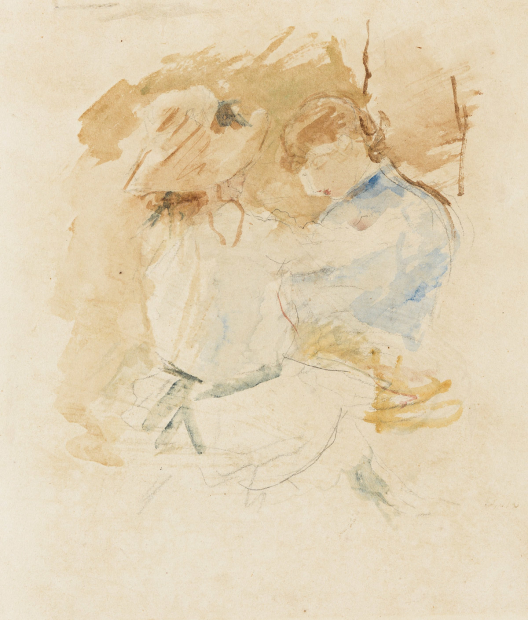

Berthe morisot
La Couture au Jardin.

Watercolor on paper, 1883. 245x265 mm; 9¾x10½ inches. With the artist’s initials in ink, lower right recto (possibly the artist’s ink stamp initials, see Lugt 388a).
Provenance: Private collection, France; sold Tajan, Paris, November 24, 2020, lot 25; private collection, Chicago.
Published: Bataille and Wildenstein, Berthe Morisot, Catalogue des Peintures, Pastels et Aquarelles, Paris, 1961, number 638, figure 660 (illustrated).
Estimate
$10,000 – $15,000



Claude émile schuffenecker
Tête de jeune fille (Jeanne Schuffenecker, fille de l’artiste).

Color pastels on paper, circa 1895. 300x300 mm; 12x12 inches. With the artist’s monogram ink stamp, lower right recto and verso.
Provenance: Private collection, Chicago.
Schuffenecker (1851-1934) was a French Post-Impressionist artist, painter, art teacher and art collector. A friend of Paul Gauguin (1848-1903) and Odilon Redon (1840-1916), and one of the first collectors of works by Vincent van Gogh (1853-1890), Schuffenecker was instrumental in establishing, with Gauguin, the seminal Volpini exhibition, in 1889. Schuffenecker and Gauguin were colleagues at the brokerage Bertin during the mid-1870s, where they became close friends. In their spare time, both studied the Old Masters at the Louvre, Paris, and worked at the Académie Colarossi. In 1880, Schuffenecker married a cousin, Louise Lançon; their daughter Jeanne, the subject of the current work, was born in 1882, their son Paul in 1884. As the economic situation decreased in the early 1880s, Schuffenecker and Gauguin had nevertheless gained enough money to leave Bertin and both opted for a career in the arts. After the Paris Bourse crashed in January 1882, Gauguin chose to remain independent, Schuffenecker decided to apply for the diploma to teach. Two years later, he was appointed to teach drawing at the Lycée Michelet in Vanves, along with his friend the painter Louis Roy (1862-1907). In 1884, Schuffenecker exhibited with the Société des Artistes Indépendants and, in 1886, the Impressionists in their eighth and final exhibition.
Estimate
$1,500 – $2,500



Camille pissarro
Effet de Pluie.

Etching and aquatint, 1879. 159x210 mm; 6¼x8½ inches, wide margins. Sixth state (of 6). Numbered 14/14 in pencil, lower right. A superb, richly-inked, luminous impression of this extremely scarce, chef d’oeuvre of Impressionist printmaking, with warm plate tone and inky plate edges. Delteil 24.
Estimate
$3,000 – $5,000



Camille pissarro
Sente des pouilleux à Pontoise, petite planche.

Etching, aquatint and drypoint on cream laid paper, 1882. 150x111 mm; 5⅞x4⅜ inches, full margins. Fourth state (of 4). With the artist’s initials ink stamp (Lugt 613e, lower left recto) and numbered 6/24 in pencil, lower right. A superb impression of this very scarce etching. Delteil 33.
Estimate
$1,500 – $2,500



Camille pissarro
Paysage à Rouen (Côte Sainte Catherine).

Etching, 1885. 128x176 mm; 5⅛x6⅞ inches, full margins. Second state (of 4). According to Delteil, the only impression in this state, from a total of only 7 lifetime impressions in all four states combined. Titled and annotated “nº 1, 2e état à revoir” in pencil, lower margin. A superb, richly-inked and dark impression of this unique proof of this extremely scarce etching.
The etching is in reverse of one of Pissarro’s iconic Impressionist oils of Rouen, La Côte Sainte-Catherine à Rouen, 1883, now in a private collection (Pissarro/Snollaerts 735). Delteil 55.
Estimate
$3,000 – $5,000



Camille pissarro
Port de Rouen (Saint Sever).

Etching and drypoint, 1884. 149x194 mm; 5⅞x7<5/8> inches, full margins. Artist’s proof, aside from the edition of 9. Titled and inscribed “1er état -nº1, épreuve unique” in pencil, lower margin. A richly-inked impression of this unique print.
This plate may have been a trial for Cours Boieldieu, À Rouen (Planche en Largeur), which has an almost identical composition with a figure added on the left and the sky burnished (see Delteil 47). Delteil 46.
Estimate
$7,000 – $10,000



Camille pissarro
Rue Molière, à Rouen.

Lithograph printed in dark olive green on Chine appliqué, 1896. 186x140 mm; 7½x5½ inches, full margins. Second state (of 2), with the further shading on the building at the far right. One of approximately only 20 lifetime impressions in both states combined. Signed, titled, inscribed “Ep. def. no.–” and annotated in pencil, lower margin (edition number effaced). A superb impression of this extremely scarce lithograph. Delteil 174.
Estimate
$1,500 – $2,500



Camille pissarro and george w. thornley
La Mi-Carême à Paris.

Lithograph printed in dark violet on off-white Chine appliqué, circa 1900. 200x250 mm; 8x10 inches, full margins. The deluxe edition of 25. Signed by both Pissarro and Thornley in pencil, lower margin. Printed by Atelier Belfond, Paris. Published by Hesséle, Paris. From 25 Lithographies. A very good impression.
In his late career Pissarro (1830-1903) turned from painting countrysides to Parisian boulevards. This lithograph is based on his 1897 oil on canvas, La Mi-Carême à Paris, now in the collection of the Fogg Museum, Harvard University, Cambridge.
Estimate
$4,000 – $6,000



Camille pissarro and george w. thornley
Portrait de Félix Pissarro.

Lithograph printed in violet on Chine appliqué, circa 1900. 250x210 mm; 9⅞x8¼ inches, full margins. The deluxe edition of 25. Signed by both Pissarro and Thornley in pencil, lower margin. Printed by Atelier Belfond, Paris. Published by Hesséle, Paris. From 25 Lithographies. A very good impression of this scarce lithograph.
This lithograph is based on Pissarro’s (1830-1903) oil portrait of his son from 1881 now in the National Gallery, London.
Estimate
$2,500 – $3,500



Paul cézanne
Autoportrait.

Lithograph printed in gray on cream laid paper, 1896-97. 325x250 mm; 12¾x9¾ inches, full margins. Printed by Clot, Paris. Published by Vollard, Paris. A very good, well-inked impression.
According to Johnson, approximately 300 impressions were printed in black and approximately 200 impressions were printed in gray. Cherpin 12.
Estimate
$1,000 – $1,500



Paul cézanne
Vue d’Auvers (Les Vessenots).

Pencil on off-white laid paper, circa 1873. 190x260 mm; 7½x10¼ inches.
Provenance: Dr. Paul Gachet, Auvers-sur-Oise; Wildenstein & Co., New York, 1958; J. B. Neumann, New York; sold Sotheby’s, New York, February 20, 1986, lot 18; private collection, Michigan.
Published: Catalogue of the Gachet collection (unpublished manuscript in the Bibliothèque Nationale, Paris); Distel, Cézanne to Van Gogh: the Collection of Doctor Gachet, Metropolitan Museum of Art, New York, 1999, page 209, number P.G. II-36 (as Les Vessenots, illustrated).
This work was drawn from Gachet’s house in Auvers. According the Gachet records, the present drawing hung in the guest room on the third floor that “Dr. Gachet ‘modestly’ called ‘Le Petit Louvre,’ because that was where he enjoyed hanging his favorite paintings and the prints he was partial to.”
Estimate
$30,000 – $50,000



Paul cézanne
Tête de Jeune Fille.

Etching printed in dark brown on cream wove paper, 1873. 122x97 mm; 4¾x3¾ inches, full margins. Third state (of 3). A superb, richly-inked impression. Cherpin 4.
Estimate
$1,000 – $1,500

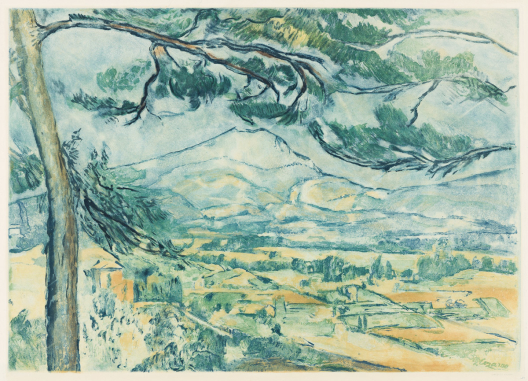

Paul cézanne (after)
La Montagne Sainte-Victoire

Color aquatint, 1923-24. 435x605 mm; 17⅛x23¾ inches, full margins. Artist's proof, with color variations, aside from the edition of 200. Etched by Jacques Villon. Published by Galerie Bernheim-Jeune, Paris. A very good impression with strong colors. Ginestet/Pouillon 639 (Villon).
Estimate
$1,500 – $2,500



Vincent van gogh (after)
Les Roses.

Color aquatint, 1927-28. 380x495 mm; 15x19½ inches, full margins. Signed by Jacques Villon and numbered 123/200 in pencil, lower margin. Etched by Jacques Villon. Published by Galerie Bernheim-Jeune, Paris, with the blind stamp lower left. A brilliant impression with strong colors.
This is based on Van Gogh’s (1853-1890) oil painting from 1890 now in the National Gallery of Art, Washington, D.C. According to the National Gallery of Art, “Roses was painted shortly before Van Gogh’s release from the asylum at Saint–Rémy. He felt he was coming to terms with his illness—and himself. In this healing process, painting was all–important. During those final three weeks of his recovery, he wrote his brother Theo, he had ‘worked as in a frenzy. Great bunches of flowers, violet irises, big bouquets of roses . . .’ This is one of two rose paintings Van Gogh made at that time. It is among his largest and most beautiful still lifes, with an exuberant bouquet in the glory of full bloom. Although he sometimes assigned certain meanings to flowers, Van Gogh did not make a specific association for roses. It is clear, though, that he saw all blossoming plants as celebrations of birth and renewal–as full of life. That sense is underscored here by the fresh spring green of the background.” Ginestet/Pouillon 651 (Villon).
Estimate
$2,000 – $3,000



Gustave loiseau
Inondation (Pontoise).

Oil on canvas, circa 1893. 530x650 mm, 21x25¾ inches. Signed in oil, lower right recto.
Provenance: Galerie Durand-Ruel, Paris, with label and their stock number 4178 in ink, on frame back; with David B. Findlay, Inc., New York, 1960; private collection, New York.
Didier Imbert, Paris, has confirmed this work is listed in the Durand-Ruel archives, in a letter dated February 8, 2022. A certificate of authenticity is available through Didier Imbert Fine Art, Paris.
Born in Paris, Loiseau (1865-1935) was a Post-Impressionist artist. Working initially in Paris as a decorator, he moved to Pont-Aven in Brittany and joined the artists’ colony there, becoming friends with Paul Gauguin and Émile Bernard. After experimenting with Pointillism, he adopted his own approach to Post-Impressionism, painting landscapes directly from nature. He is known for his unique technique, en treillis, or cross-hatching, that distinguishes his work from his near contemporaries, like Claude Monet, Paul Cézanne, Vincent van Gogh and Georges Seurat. He excelled at landscape scenes featuring the banks of the Seine and the Oise, the Norman cliffs, as well as views of Paris and the area of the Île-de-France.
Estimate
$40,000 – $60,000



Paul signac
À Flessingue.

Color lithograph on Chine volant, 1895. 237x402 mm; 9⅜x15⅞ inches, full margins. Second state (of 3), with the remarqué lower right. Edition of 20 in this state, from a total published edition of 60. Printed by Auguste Clot, Paris. Published by Gustave Pellet, Paris. A very good impression.
Signac (1863-1935) painted an oil of the same subject, Le Bassin de Flessingue, 1896, private collection, Munich. Kornfeld 11.
Estimate
$7,000 – $10,000



Paul signac
Paysage avec étang.

Watercolor, 1904. 126x171 mm; 5x6¾ inches. Signed and dated in pencil, lower right recto.
Provenance: Otto Brill, Vienna and London, with his black ink stamp (Lugt 2005a, verso).
Estimate
$5,000 – $8,000



Henri-edmond cross
Portrait de Camille Pissarro, en profil, lisant.

Charcoal on paper. 152x238 mm; 6x9⅜ inches. With the artist’s red ink stamp (Lugt 1305a, lower right recto).
Provenance: Private collection, New York.
Estimate
$2,000 – $3,000



Henri-edmond cross
Les Champs Élysées.

Color lithograph on Chine volant, 1897. 203x262 mm; 8x10¼ inches, full margins. Edition of 1100. From Pan. A very good impression with strong colors.
Cross (1856-1910), along with Georges Seurat and Paul Signac, was one of the best known practitioners of Pointillism, an artistic style prevalent in France during the last two decades of the 19th century.
Estimate
$1,500 – $2,500



Henri-edmond cross
Étude pour “Paysannes de l’Ombrie”.

Color pencils on paper, circa 1908-09. 170x189 mm; 6¾x7½ inches.
Provenance: Roland, Browse and Delbanco, London, with the label on the frame back; Elliot Bloom, New York; private collection, Maryland.
This work is accompanied by a letter, dated March 26, 1930, from the art critic Félix Fénéon (1861-1944), also Cross’s gallerist, that confirms the authenticity of this work and states this it is a study for the oil Paysannes de l’Ombrie, 1909, painted during Cross’ (1856-1910) second tour of Italy and formerly in the collection of Harry Kessler, Berlin.
Estimate
$3,000 – $5,000



Anders zorn
Frederick Keppel, Art Dealer.

Pencil on cream laid paper, circa 1898. 187x145 mm; 7⅜x5¾ inches, upper edge irregular. Signed in pencil, lower right recto.
Provenance: The artist, Mora; the sitter, Frederick Keppel, New York, with the black ink stamp (Lugt 1023, lower left verso); private collection, Florida.
A preparatory drawing for Zorn’s (1860-1920) etching, Frederick Keppel I (see Asplund 141; Hjert/Hjert 92). Keppel (1845-1912) was an important gallerist in New York at the forefront of the Etching Revival in the late 19th and early 20th centuries. He was born in Tullow, Ireland and studied at Wesley College, Dublin. He and his family moved to Canada and then to the United States in 1862. Early on Keppel resolved to be a farmer, but he sustained an injury that prevented him from most physical labor. He remembered, “Next after farming I think I liked books best, and so I made my way to New York and engaged in that most interesting business, a bookseller’s.” Keppel arrived in New York and opened Frederick Keppel & Company in 1868. Though at first having no knowledge of fine art prints, Keppel found his way into initially selling portfolios. Through his relationships abroad and his ability to lecture and write about the subject, Keppel nurtured the public’s interest in prints, launching numerous publications of artist’s works and the Print-Collector’s Quarterly in 1911. He was known to have forged friendships with the artists he represented, notably Zorn, James A. M. Whistler, Jean-François Millet, Fèlix Buhot and Joseph Pennell. Like many of those who knew Whistler, Keppel had a frought relationship with the artist, Keppel’s pamphlet, </i>The Gentle Art of Resenting Injuries</i> was a direct, albeit entertaining, response to Whistler’s The Gentle Art of Making Enemies.
Estimate
$4,000 – $6,000



Anders zorn
The Bride’s Maid.

Etching, 1905. 150x197 mm; 6x7¾ inches, full margins. Signed in pencil, lower right. A very good, dark impression. Delteil 191; Asplund 192; Hjert/Hjert 204.
Estimate
$1,000 – $1,500



Paul gauguin
La Femme aux Figues.

Etching on cream laid paper, 1894. 267x420 mm; 10½x16½ inches, full margins. Third state (of 3). A very good, well-inked impression.
According to Boyle-Turner, “This controversial print has been assigned to Seguin, to Gauguin, and even to a collaboration of both artists.” The artist Armand Seguin (1869-1903) was a close friend of Gauguin (1848-1903) during the late 1880s and early 1890s. Based on the etched inscription upper left, “Chez Seguin à St. Julien,” the scene takes place at Seguin’s Breton home in Pouldu. Current scholarship regarding authorship for the print leans toward Gauguin, in its similarities to other of his Breton female portrait compositions. Kornfeld 25.
Estimate
$1,500 – $2,500



Paul gauguin
Manao Tupapau.

Woodcut on Chine volant, 1893-94. 205x355 mm; 8⅛x14 inches, full margins. Fourth state (of 4). Edition of 100. Signed by the artist’s son, Pola Gauguin, inscribed “imp.” and “Paul Gauguin fait” in pencil, lower margin, and inscribed “no. 79” in pencil, upper left. A very good, evenly-printed impression. Kornfeld 20.
Estimate
$5,000 – $8,000



Henri toulouse-lautrec
Un Monsieur et une Dame, Programme pour “l’Argent.”

Color lithograph on cream wove paper, 1895. 319x238 mm; 12½x9⅜ inches (sheet), full margins. Second state (of 2). Printed by Eugene Verneau, Paris. A very good impression with strong colors. Delteil 15; Adhémar 148; Adriani 133.
Estimate
$4,000 – $6,000



Henri toulouse-lautrec
Divan Japonais.

Color lithograph on cream wove paper mounted on linen, 1892-93. 795x611 mm; 31¼x24 inches. Printed by Ancourt, Paris. A very good impression of this important lithograph, with the registration marks preserved upper and lower center and with the printed address of Ancourt, lower right.
The Divan Japonais was a small café-concert at 75 rue des Martyrs, Paris, where Yvette Guilbert began her career. This is Toulouse-Lautrec’s only poster to show both Jane Avril and Yvette Guilbert, the two Montmartre demimondes who were both his friends and major inspirations. Jane Avril, the star dancer at the Moulin Rouge, is in profile seated next to the literary critic, Édouard Dujardin. On stage in the background, Guilbert is depicted from the neck down, recognizable by her trademark long black gloves. The composition is arranged along the diagonal of the stage and the orchestra pit in the style of Japanese Ukiyo-e woodcuts that were so fashionable in Paris at the end of the 19th century and from which artists from the Impressionists to Gauguin and Van Gogh drew influence. Delteil 341; Adhémar 11; Adriani 8.
Estimate
$15,000 – $20,000



Henri toulouse-lautrec
Aux Variétés, Mademoiselle Lender et Brasseur.

Lithograph printed in dark blue, 1893. 283x258 mm; 11¼x10¼ inches, full margins. Second state (of 3). Edition of 100. Signed and inscribed “No. 94” in pencil, lower left. A very good impression of this scarce lithograph. Delteil 41; Adhémar 44; Adriani 46.
Estimate
$2,500 – $3,500



Henri toulouse-lautrec
Feuille d’études avec le Champion Cycliste Zimmerman.

Pen and ink, color pencil and pencil on wove paper, circa 1893-94. 359x229 mm; 14⅛x9 inches.
Provenance: Madame Thadée Natanson, Paris; thence to her sale, Hôtel Drouot, Paris, November 27, 1953, lot 95, with the ink stamp (Lugt 2449a, recto; Lugt notes that the stamp was used on the occasion of Natanson’s auction, and only on the works of Lautrec; private collection, New York.
Published: Natanson, Un Henri de Toulouse-Lautrec, P. Cailler, Geneva, 1952, page 181, plate V (detail, illustrated); Dortu, Toulouse-Lautrec et son oeuvre, Paris, 1971, number 3.934.
The American athlete Arthur Augustus Zimmerman (1869-1936) was one of the world’s greatest cycling sprint riders and winner of the first world championship in Paris in 1893. He lived and raced in France from May 1893 to July 1895. He was a favorite subject of Toulouse-Lautrec’s and was featured in the artist’s numerous sketches and the lithograph Zimmerman et sa Machine (see Wittrock 111), aside from numerous bicycle advertisements of the time.
Estimate
$5,000 – $8,000

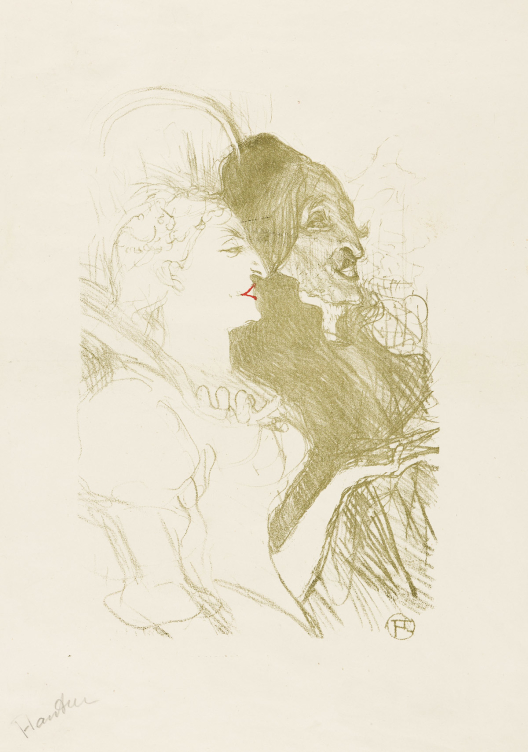

Henri toulouse-lautrec
Carnaval.

Color lithograph, 1894. 255x166 mm; 10¼x6½ inches, full margins. Third state (of 4), before the reduction of the image. The deluxe edition of 100, before the fourth state and publication in La Revue Blanche. Signed in pencil, lower left. A very good impression of this scarce lithograph. Delteil 64; Adhémar 42; Adriani 62.
Estimate
$2,500 – $3,500



Henri toulouse-lautrec
Au Lit.

Lithograph, 1898. 312x250 mm; 12¼x9¾ inches, full margins. Edition of only 25. A superb impression of this extremely scarce lithograph. Delteil 226, Adhémar 291; Adriani 302.
Estimate
$10,000 – $15,000



Henri toulouse-lautrec
Yvette Guilbert, “Linger Longer Loo”.

Lithograph printed in black with light beige background tint, 1898. 297x234 mm; 11¾x9¼ inches, full margins. Second state (of 2). Edition of 350. Published by Bliss, Sands and Co., London. From Album Yvette Guilbert. A very good impression. Delteil 259; Adhémar 315; Adriani 257.
Estimate
$2,000 – $3,000



Henri toulouse-lautrec
Anna Held.

Lithograph on smooth, cream wove paper, 1898. 292x243 mm; 11½x9¾ inches, full margins. Edition of approximately 300-400. From Portraits d’Acteurs et d’Actrices. A very good impression. Delteil 156; Adhémar 173; Adriani 266.
Estimate
$1,500 – $2,500

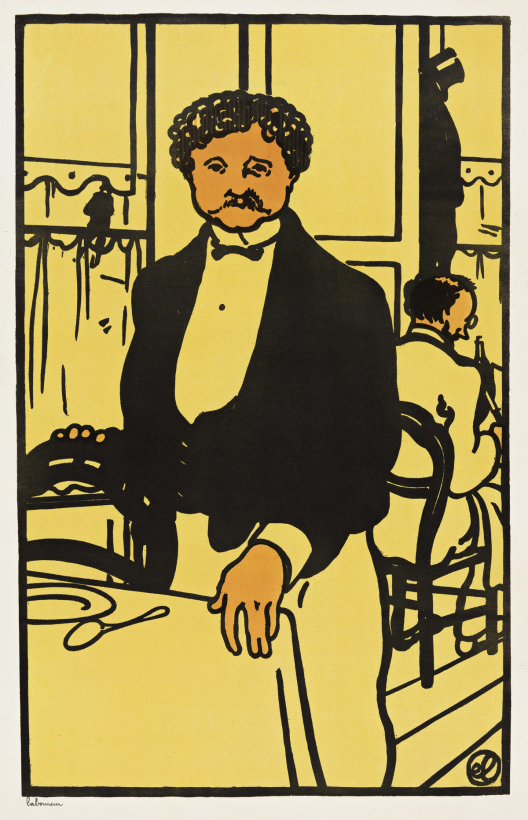

Jean-émile laboureur
Ernest, Garçon de Restaurant.

Color woodcut, 1902-11. 441x276 mm; 17⅜x10⅞ inches, full margins. Second state (of 2). Signed and numbered 12/20 in ink, lower left. A superb impression of this very scarce woodcut, with strong colors. Laboureur 617.
Estimate
$4,000 – $6,000

Jean-émile laboureur
Two woodcuts.

Le bal bullier, 1898. 223x290 mm; 8⅞x11⅜ inches, full margins. Artist’s proof, aside from the edition of 61. Signed and inscribed “ep. d’artiste” in pencil, lower margin * Le Régiment qui passe, 1900. 230x300 mm; 9x11¾ inches, full margins. Signed and numbered 32/60 in pencil, lower margin. Both very good impressions. Laboureur 579 and 605.
Estimate
$1,500 – $2,500



Charles maurin
Magasins de Louvre.

Color pastels and conté crayon on cream wove paper, 1890-95. 482x609 mm; 19x24 inches. Signed and titled in pencil, lower right recto.
Provenance: Lucien Goldschmidt, Inc., New York; private collection, New York.
Maurin (1856-1914) was born in Le Puy-en-Velay, France. He studied painting and engraving at the renowned École des Beaux-Arts in Paris. Maurin was close friends with the preeminent French art dealer and collector, Ambroise Vollard (1866-1939), as well as artist Henri Toulouse-Lautrec (1864-1901). This drawing depicts a late 19th century Parisian street scene, with people crowding the entrance of the Louvre department store on the corner of Rue St. Honoré.
Estimate
$1,500 – $2,500



Henri evenepoel
Au Square.

Color lithograph, 1897. 330x229 mm; 13x9 inches, full margins. Edition of 2000. Published by L’Estampe Moderne, Paris, with the blind stamp (Lugt 2790, lower right). A very good impression with strong colors.
Evenepoel (1872-1899) was a Belgian artist whose productive though short career spanned Post-Impressionism, Art Nouveau and Fauvism. He first studied art in Brussels at the Académie Royale des Beaux-Arts between 1889 and 1890, and entered Paris’s Ecole des Beaux-Arts in 1892. Evenepoel entered the Paris atelier of Gustave Moreau in 1893, which put him in contact with Henri Matisse, Georges Rouault and Albert Marquet among others. His Parisian scenes were influenced by Henri Toulouse-Lautrec and Jean-Louis Forain. Evenepoel died of typhus in Paris at the age of 27.
Estimate
$1,500 – $2,500



Georges privat-livemont
Les tulipes.

Watercolor and pencil on paper. 444x292 mm; 17½x11½ inches. Initialed in pencil, lower center recto.
Provenance: Private collection, New York.
Estimate
$2,500 – $3,500



Georges bottini
Danseuse.

Color woodcut on imitation Japan paper, 1896. 195x150 mm; 7⅝x5⅞ inches, full margins. Edition of 25. Signed and dated in pencil, lower right, and with the artist’s red ink stamp (Lugt 374, lower right recto). Printed by Harry van der Zee, Paris, with the printer’s red ink stamp (Lugt 1382, lower right recto). A very good impression with strong colors.
With—Danseuse, two trial proofs * Au Bar, two proof impressions * Esthetic Bar, two progressive proofs and 3 proofs of the line block. Various sizes and conditions.
Estimate
$2,500 – $3,500

Georges bottini
Femme au bar.

Watercolor and gouache on cream wove paper, double-sided, circa 1905. 420x310 mm; 16½x12¼ inches. Signed and dated indistinctly “19–” in watercolor, lower right recto. With a preliminary study in pencil, verso.
Provenance: Private collection, Mystic, Connecticut.
Estimate
$1,500 – $2,500



Paul césar helleu
Femme au grand chapeau.

Color drypoint. 570x352 mm; 22½x13¾ inches, full margins. Signed and inscribed “44” in pencil, lower right and with the Cercle de la Librairie, Paris blind stamp (Lugt 438, lower left recto). A very good impression.
Estimate
$2,000 – $3,000



Paul césar helleu
Madame Helleu au Chapeau.

Color drypoint, circa 1900. 542x335 mm; 21⅜x13¼ inches, full margins. Signed in pencil, lower right. A very good impression.
Estimate
$1,500 – $2,500



Armand rassenfosse
Femme assise.

Color etching, drypoint and aquatint, 1903. 298x229 mm; 11¾x9 inches, full margins. Numbered 47/50 in pencil, lower margin. Published by L’Estampe Nouvelle, Paris with the ink stamp (Lugt 886 lower right recto). A very good impression of this scarce etching.
Estimate
$1,000 – $1,500

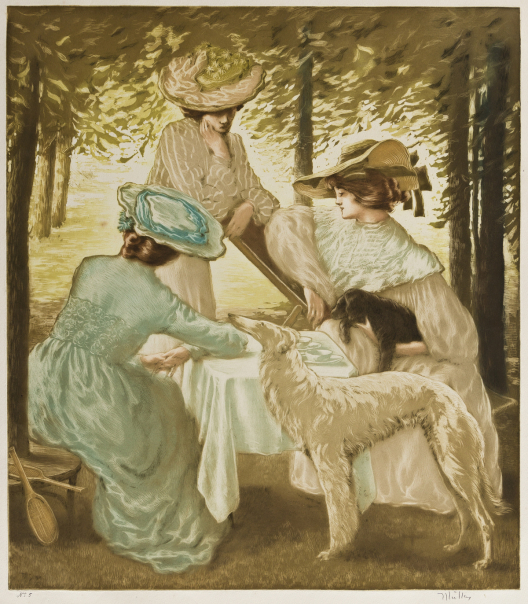

Alfredo müller
Le Thé dans un Jardin.

Color etching and aquatint. 515x453 mm; 20¼x17¾ inches, full margins. Signed and inscribed “No. 5” in black crayon, lower margin. A very good impression.
Müller (1969-1939) was born in Livorno to a wealthy Swiss merchant family. He studied art in Florence and by the 1890s had moved to Paris and settled in Montmartre where he became friends with Pierre-Auguste Renoir, Camille Pissarro and Paul Cézanne. Müller honed his skill as a master color etcher in Paris, then a hub for intaglio printmaking centered around the studios of Auguste Delâtre and Jean-François Raffaëlli.
Estimate
$1,000 – $1,500



James jacques tissot
Le banc de jardin.

Mezzotint, 1883. 417x562 mm; 16⅜x22⅛ inches. First state (of 3), before the title lower center and with the uncleaned lower margin. One of two known bon à tirer proof impressions, aside from the edition of approximately 100. Signed and inscribed “Bon à Tirer” in pencil, lower left. A brilliant, richly-inked, early impression. Wentworth 75.
Estimate
$2,000 – $3,000



James jacques tissot
Sa Première Culotte.

Drypoint, 1880. 177x75 mm; 7x3 inches, full margins. Second state (of 2). Edition of approximately 100. Signed and dedicated in pencil, lower left. With the artist’s red ink stamp (Lugt 1545, lower left recto). A superb, richly-inked impression. Wentworth 51.
Estimate
$1,000 – $1,500

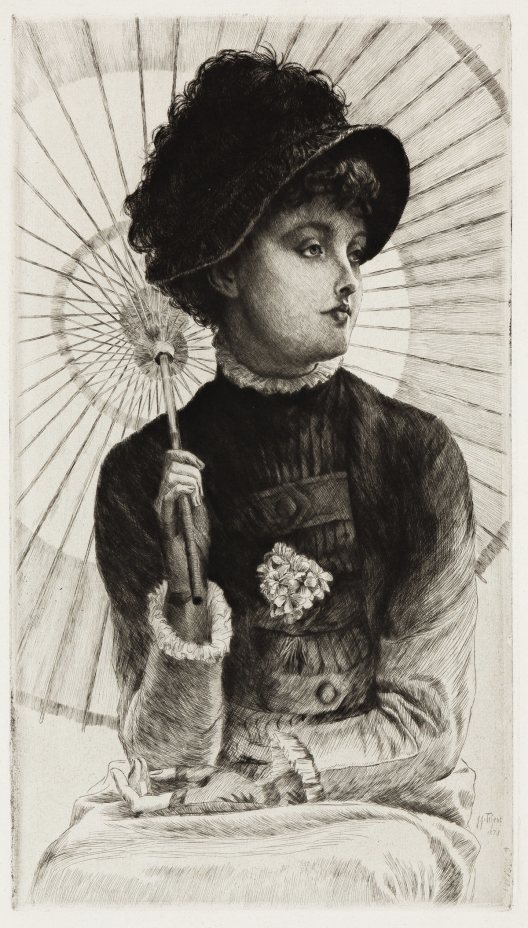

James jacques tissot
L’Été.

Etching and drypoint, 1878. 376x208 mm; 14¾x8½ inches, full margins. Edition of approximately 100. A superb, dark and early impression with strong contrasts.
The sitter is Kathleen “Kate” Newton (1854-1882), Tissot’s Irish muse and mistress from 1871-82. Tissot (1836-1902) portrayed her as a personification of summer in this etching. Tragically, Newton contracted tuberculosis and, unable to fight the disease and bear witness of Tissot’s mounting grief, overdosed on laudanum in November 1882. Tissot reportedly sat by her coffin for four days before giving her up for burial. Wentworth 43.
Estimate
$1,200 – $1,800



James jacques tissot
Octobre.

Etching and drypoint on cream laid paper, 1878. 548x278 mm; 21½x11 inches, wide margins. Edition of approximately 100. Signed in pencil, lower left. With the artist’s monogram red ink stamp (Lugt 1545, lower right recto). A brilliant, richly-inked impression with strong contrasts and deep black, velvety burr throughout.
Tissot (1836-1902) was a successful French society artist; his artworks portray fashionable women and 19th century life that embody Victorian and Belle Époque aesthetics. The child of Catholic textile merchants, he moved from his native Nantes to Paris in 1856 to study art with Louise Lamothe and Hippolyte Faldrin, who were protégés of Ingres. He also met Édouard Manet (1832-1883), Edgar Degas (1834-1917) and James A. M. Whistler (1834-1903), with whom he maintained ties throughout his life. Tissot was exiled to London in 1871 after his involvement with the Paris Commune in the Franco-Prussian War. In London, Tissot’s portraits of women and 19th century life quickly gained popularity and he became among the most successful, renowned artists of his day. Tissot was inspired by many of Whistler’s etchings and paintings, borrowing similar subjects, such as views of the Thames, and influences, such as from Japanese prints.
Tissot made his first etchings while studying in Paris—epicenter of the later 19th century etching revival—in the 1860s and revisited the medium again in 1875-85. As a printmaker, Tissot primarily used the medium to skillfully reproduce his own paintings (rather than sell the reproductive rights to his work to other publishers and printers). The market for reproductive prints in England was exceedingly strong during this time (prompted by the concurrent etching revival in England, supported by the English Etching Club) and Tissot found the sale of his etchings a highly lucrative segment of his artistic output. Unlike many of his contemporaries, Tissot did not experiment with etching to make original works but instead only used it as a way of replicating (or revisiting) his painted subjects. Throughout the production of his prints he maintained a consistent approach to etching that employed meticulous detail and rich tonality, which resulted in a cohesive, focused oeuvre.
The etching Octobre is based on the same-titled painting from 1877, now in the Montreal Museum of Art, and follows many of the standard influences in Tissot’s work from the 1870s—including Japanese prints and photography. The composition with a single full figure is reminiscent of Japanese Ukiyo-e paintings of the Kaigetsudo School of the early 18th century. Tissot also frequently used photography to help provide compositional details that lent an immediacy to some of his compositions. The woman depicted is young Irish divorcée Mrs. Kathleen Newton, Tissot’s frequent model and companion. The two met in 1875 and from 1876 until her death in 1882 they lived together in Tissot’s home in St. John’s Wood—Tissot would describe these years as the happiest of his life. After Mrs. Newton’s death in 1882, Tissot moved back to Paris and began producing artwork focused on religious subject matter, spending the last two years of his life in an Abbey in Buillon, France. Wentworth 33.
Estimate
$12,000 – $18,000



James jacques tissot
L’Enlèvement.

Oil on board, 1871-72. 235x360 mm; 9¼x14¼ inches.
Provenance: The artist, London and Chateau de Buillon, Chenecey-Buillon; thence by descent to his niece, Mlle. Jeanne Tissot; thence sold through her estate, Chateau de Buillon, Chenecey-Buillon, November 1964; private collection, France; sold by the former to the current owner, private collection, Chicago, June 2006.
Estimate
$7,000 – $10,000

Émile-coriolan-hippolyte guillemin
Rebecca and Eliezer at the Well.

Patinated bronze, circa 1880. 820x520x201 mm; 32¼x20½x7⅞ inches. Incised with the artist’s signature at the edge of the base, lower right.
Guillemin (1841-1907) was an acclaimed Parisian bronze sculptor of the Belle Époque known for his Orientalist aesthetics. He exhibited his bronzes frequently at the Paris Salon throughout his career and achieved abundant crirtical praise and success in his lifetime. This Biblical scene of Rebecca and Eliezer illustrates Guillemin’s signature style with both figures dressed in an Orientalist fashion and rendered in lively form and intricate detail.
Estimate
$10,000 – $15,000

Eugène galien-laloue (louis dupuy)
Two oils on panel.

Paysage lacustre. 178x360 mm; 7x13⅛ inches. Signed in oil, lower right recto * Gîte au bord de l’étang. 330x235 mm; 13x9¼ inches. Signed in oil, lower right recto.
Provenance: Private collection Skokie, Illinois.
Estimate
$1,500 – $2,500



Jean-françois raffaëlli
Le Jardin de la veille fille.

Color drypoint and roulette on Japan paper, 1894. 310x220 mm; 12¼x8⅝ inches, full margins. Third state (of 3). Artist’s proof, aside from the edition of 100. Signed and inscribed “état” in pencil, lower right. A very good impression with strong colors. Delteil 18.
Estimate
$1,000 – $1,500



Jean-françois raffaëlli
La Fumée du Bateau.

Color drypoint and aquatint, 1911. 198x139 mm; 8x5½ inches, full margins. Third state (of 3). Edition of 150. Signed and inscribed “No. 25” in pencil, lower right. A very good impression with strong colors. Delteil 98.
Estimate
$1,000 – $1,500



Ker-xavier roussel
Le Fête Champêtre.

Sanguine chalk on paper. 235x320 mm; 9¼x12½ inches. Signed in pencil, lower right recto.
Provenance: Wolseley Fine Arts, London, with the label on the frame back; private collection, New York.
Estimate
$1,500 – $2,500

Henri fantin-latour
Étude pour Ève.

Lithograph on Japon impériale, 1898. 179x125 mm; 7x4⅞ inches, full margins. Second state (of 3). One of approximately only 7 artist’s proofs, aside from the edition of 150. Signed in pencil, lower right. A very good impression.
With—La prise de Troie: Acte III, Apparition d’Hector, lithograph, 1888. 233x156mm; 9¼x6¼ inches * La Lecture, lithograph, 1897. 160x127mm; 6⅜x5 inches, full margins. First state (of 2), with the lithographed text lower right. Edition of 60. Hédiard 147, 87 and 136.
Estimate
$1,500 – $2,500



Henri-eugène le sidaner
La Maison au clair de lune.

Lithograph on Chine volant, 1909. 227x160 mm; 9x6¼ inches, full margins. Artist’s proof, aside from the book edition published in La Gazette des Beaux-Arts. Signed and annotated in pencil, lower margin. A superb impression of this extremely scarce lithograph. Bibliothèque Nationale 7.
Estimate
$1,500 – $2,500



Lucien pissarro
Sunset on the Thames.

Watercolor and pencil on thin laid paper. 95x125 mm; 3¾x5 inches. With the artist’s blue monogram ink stamp (the larger version, see Lugt 1756b, lower right recto).
Provenance: Family of the artist, 1944; with Leicester Galleries, London, 1946; sold to Paul Poser, Esquire; private collection, Montreal.
Exhibited: “Memorial Exhibition of Paintings and Water-colours by Lucien Pissarro, 1863–1944,” Leicester Galleries, London, January 8-30, 1946, number 71, with the label.
Estimate
$1,500 – $2,500



Pierre bonnard (after)
Port de pêche.

Color lithograph, 1942-46. 320x500 mm; 12¾x19¾ inches, full margins. Initialed and numbered 22/80 in pencil, lower margin. Lithographed by Jacques Villon, Paris. Published by Louis Carré, Paris. A very good impression. Bouvet 117.
Estimate
$1,500 – $2,500



Pierre bonnard (after)
La Baignoire.

Color lithograph, 1942-46. 500x650 mm; 19¾x25¾ inches, full margins. Initialed and numbered 28/80 in pencil, lower margin. Lithographed by Jacques Villon, Paris. Published by Louis Carré, Paris. A very good impression of this scarce lithograph with vibrant colors. Bouvet 120.
Estimate
$2,000 – $3,000



Pierre bonnard
Jeune Femme au bas noirs.

Lithograph, 1893. 286x127 mm; 11¼x5 inches, full margins. Edition of 100. Signed and inscribed “No. 94” in pencil, lower left. A very good impression of this scarce lithograph. Bouvet 27.
Estimate
$1,500 – $2,500



Pierre bonnard
La Baraque.

Lithograph on Chine, 1893. 108x218 mm; 4¼x8⅝ inches, full margins. Edition of approximately 20. With the artist’s monogram in brush and blue ink, lower right. Printed by Crevel Frères, Paris. Published by F. Froment, Paris. From Petites Scènes familières. A very good impression. Bouvet 22.
Estimate
$1,000 – $1,500



Édouard vuillard
La Couturière.

Color lithograph, 1894. 250x166 mm; 9⅞x6½ inches, full margins. Third state (of 4). Edition of 100. Signed in blue crayon and numbered “No. 9” in pencil, lower right. A very good impression. Roger-Marx 13.
Estimate
$2,500 – $3,500



Édouard vuillard
L’Avenue.

Color lithograph on Japan paper, 1899. 312x413 mm; 12x16¼ inches, wide margins. Edition of 100. Published by Vollard, Paris. From Paysage et Interieurs. A very good impression. Roger-Marx 33.
Estimate
$3,000 – $5,000



Édouard vuillard
Place Vintimille.

Color pastels on tan wove paper. 325x250 mm; 12⅞x9⅞ inches. Signed in ink, lower right recto.
Provenance: Private collection, New York; thence by descent to current owner, private collection, New York.
This lot is accompanied by a letter and certificate of authenticity issued by Jean-Claude Bellier, Paris, June 14, 1984.
Estimate
$8,000 – $12,000



Édouard vuillard
La Porte Fenêtre sur le jardin (Paysage).

Color pastels on reddish brown wove paper. 300x230 mm; 11⅞x9⅛ inches.
Provenance: The artist, with the ink stamp (Lugt 909c, lower right recto); thence to the estate, Paris; private collection, New York; thence by descent to current owner, private collection, New York.
This lot is accompanied by a letter and certificate of authenticity issued by Jean-Claude Bellier, Paris, June 14, 1987.
Estimate
$12,000 – $18,000



Édouard vuillard
Le Jardin de Curé.

Color pastels on gray wove paper, 305x236 mm; 12x9¼ inches.
Provenance: The artist, with the ink stamp (Lugt 909c, lower right recto); thence to the estate, Paris; private collection, New York; thence by descent to current owner, private collection, New York.
This lot is accompanied by a letter and certificate of authenticity issued by Jean-Claude Bellier, Paris, June 14, 1984.
Estimate
$12,000 – $18,000



Édouard vuillard
Les Grands Arbres.

Oil on card. 200x130 mm; 7⅞x5¼ inches.
Provenance: The artist, with the ink stamp (Lugt 909c, lower right recto); thence to the estate, Paris; private collection, New York; thence by descent to current owner, private collection, New York.
This lot is accompanied by a letter and certificate of authenticity issued by Jean-Claude Bellier, Paris, June 14, 1984.
Estimate
$15,000 – $20,000



Édouard vuillard
Coucher de soleil sur le jardin.

Color pastels on blueish gray wove paper. 326x245 mm; 12⅞x9⅝ inches.
Provenance: The artist, with the ink stamp (Lugt 909c, lower right recto); thence to the estate, Paris; private collection, New York; thence by descent to current owner, private collection, New York.
This lot is accompanied by a letter and certificate of authenticity issued by Jean-Claude Bellier, Paris, June 14, 1984.
Estimate
$20,000 – $30,000



Henri rousseau (after)
La Chase du Tigre.

Color aquatint, 1924. 375x505 mm; 14¾x19⅞ inches, full margins. Signed by Jacques Villon and numbered 85/100 in pencil, lower left. Etched by Jacques Villon. Published by Galerie Bernheim-Jeune, Paris. A superb impression with strong colors.
Rousseau (1844-1910) was a French self-taught Post-impressionist painter. He is nicknamed Le Douanier (the customs officer) from his career as a toll and tax collector. Rousseau began painting after his retirement and is best known for his jungle scenes rendered in a Primitive style. He never traveled outside of France, but was deeply inspired by zoos and botanical gardens in France, as well as tableaux of taxidermied wild animals, claiming that he had "no teacher other than nature." Ridiculed by critics for most of his art career, Rousseau was unaffected by the negative feedback and continued to paint and show his work. Pablo Picasso happened upon a painting of Rousseau's in 1908 and immediately recognized his talent; he proceeded to meet with Rousseau and host a banquet in his studio in Rousseau's honor. Ginestet/Pouillon 641.
Estimate
$2,000 – $3,000

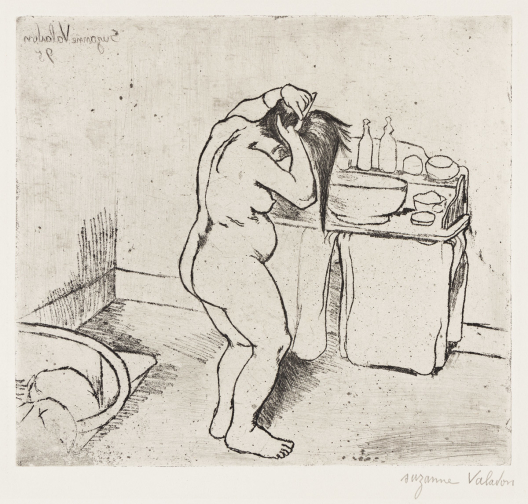

Suzanne valadon
Catherine nue se coiffant.

Etching, 1895. 218x239 mm; 8½x9½ inches, wide margins. Signed in pencil, lower right. A very good impression of this scarce etching.
Estimate
$1,200 – $1,800



Auguste rodin
Femme a sa toilette.

Gouache, pen and ink, and pencil on cream laid paper, 1890-1895. 177x115 mm; 7x4½ inches. Signed in ink, lower right recto (the signature faded).
Provenance: Émile Laporte, Paris; Hôtel Drouot, Paris, November 22, 1930, lot 44, as Étude de femme demi-nue debout et de face; Rheims and Laurin, Palais Galliéra, Paris, March 12, 1970, lot 81; private collection, Michigan.
Christina Buley-Uribe has confirmed the authenticity of this work.
Rodin’s (1840-1917) drawings and works on paper rarely served as preliminary sketches for his sculptures, in fact the majority were created by Rodin studying his own earlier sculptures or that by other artists, including Michelangelo. Rodin simplified these figures to near abstraction and often floated them against a wash of color on the sheet, creating dynamism by removing context.
Estimate
$10,000 – $15,000



Louis valtat
Étude d’une femme (Madame Valtat).

Red conté crayon on paper, circa 1905. 247x317 mm; 9¾x12½ inches.
Provenance: Estate of the artist, Paris, with the black ink stamp (Lugt 1771bis, lower left recto); Galerie J. Le Chapelin, Paris, with the label; private collection, New York.
The artist’s wife, née Suzanne Noel (1879-1967), married in Versailles in 1900, was Valtat’s favorite model and posed for an oil portrait by the artist’s friend, Pierre-Auguste Renoir from 1903, now in a private collection.
Estimate
$1,000 – $1,500



Louis valtat
La femme assise aux chats (Madame Valtat).

Woodcut with hand-coloring in watercolor on paper, circa 1905. 305x242 mm; 12x9½ inches, full margins. Edition of 50. With the artist’s initial ink stamp (Lugt 1771bis, lower right recto). A very good impression.
Estimate
$1,000 – $1,500

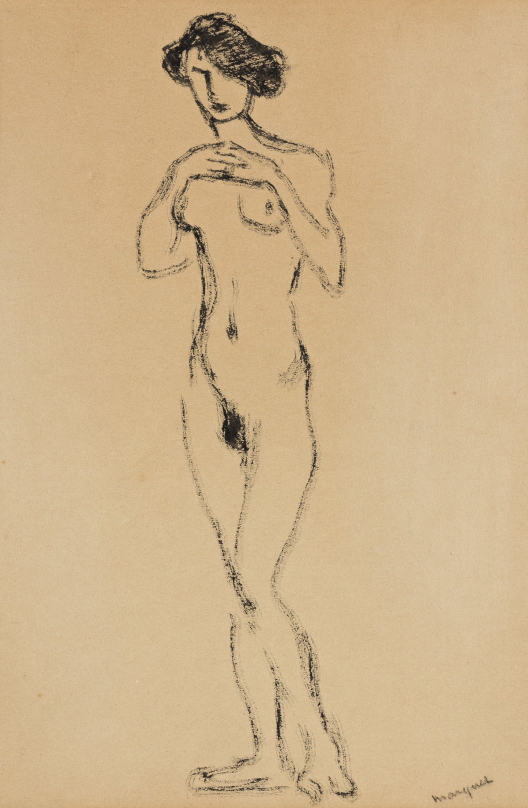

Albert marquet
Nu debout.

Brush and ink on paper mounted on card stock, circa 1900. 305x221 mm; 12x9 inches. Signed in crayon, lower right recto.
Provenance: Private collection, Chicago.
Estimate
$1,500 – $2,500



Jacques villon
Portrait de Léo Lelièvre.

Brush and black ink and wash and black crayon on paper, 1895. 180x119 mm; 7¼x4¾ inches. Signed and dated in ink, lower center recto, and titled in ink, upper right recto.
Provenance: Peter H. Deitsch Gallery, New York; sold Christie’s, New York, June 22, 2011, sale number 2455, lot 13; Estate of Matthew Rutenberg, New York.
Exhibited: “Arts of the Fin de Siècle,” William Hayes Ackland Memorial Art Center, Chapel Hill; the Fogg Art Museum, Harvard University, Cambridge, Massachusetts; and the Williams College Museum of Art, Williamstown, Massachusetts, with the labels.
Estimate
$1,500 – $2,500
American



Thomas moran (after)
The Gates of Venice.

Etching, drypoint and roulette on imitation Japan paper, 1888. 455x800 mm; 18x31½ inches, full margins. Signed by Moran in pencil, lower left, and with the portfolio remarqué lower left. Published by C. Klackner, New York. A superb, well-inked impression of this large etching with strong contrasts.
Moran (1837-1926) visited Venice for the first time in May 1886 and, like many other artists, was captivated by the color and light, previously only known to him through descriptive Romantic literary works, views by earlier artists like Joseph M. W. Turner and photographs. Moran made numerous sketches in watercolor and oil studies in Venice which he translated into large oil paintings once back in his New York studio. He compounded the popularity of these dramatic oils of Venice among American art patrons by also issuing deluxe editions of etchings, made in collaboration with professional printmakers, which he signed in pencil to give his stamp of approval. Klackner 61.
Estimate
$1,500 – $2,500



John marin
Ponte de Donna Onesta, Venice.

Etching, 1907. 180x129 mm; 7⅛x5⅛ inches, wide margins. Edition of approximately 30. Signed and titled in pencil, lower margin. A very good impression of this scarce, early etching. Zigrosser 56.
Estimate
$1,500 – $2,500



Childe hassam
The Chimneys, Portsmouth.

Etching, 1915. 125x203 mm; 4¾x8 inches, full margins. Signed with the artist’s cypher and inscribed “imp” in pencil, lower right. A very good, richly-inked impression with strong contrasts and with the artist’s tack holes for drying the at the extreme sheet edges. Cortissoz/Clayton 16.
Estimate
$1,500 – $2,500



Childe hassam
Cos Cob.

Etching and drypoint, 1915. 177x127 mm; 6⅞x5 inches, full margins. Edition of 400. Signed with the artist’s cypher in pencil, lower right. Printed by Peter J. Platt, New York. Published by The American Academy of Arts and Letters, New York, bound as issued in The Etchings and Drypoints of Childe Hassam, N.A. A very good impression. Cortissoz/Clayton 32.
Estimate
$1,000 – $1,500



Frank w. benson
Harbor.

Etching, 1918. 103x155 mm; 4x6 inches, full margins. Edition of 150. Signed and numbered “29” in pencil, lower margin. A very good impression. Paff 148.
Estimate
$1,000 – $1,500



Frank w. benson
The Punter.

Etching, 1927. 200x300 mm; 7⅞x11⅞ inches, full margins. Edition of 150. Signed in pencil, lower left. A superb, richly-inked and luminous impression. Paff 273.
Estimate
$1,200 – $1,800



Frank w. benson
Elisabeth.

Etching, 1918. 252x202 mm; 10x8 inches, full margins. Edition of 150. Signed in pencil, lower left. A very good, richly-inked impression of this extremely scarce etching.
A portrait of the artist’s daughter, Elisabeth, born in 1892; the third of Benson’s (1862-1951) four children. Paff 150.
Estimate
$4,000 – $6,000



George bellows
Murder of Edith Cavell.

Lithograph on thin wove paper, 1918. 476x629 mm; 18¾x24¾ inches, full margins. Edition of 103. Signed “Geo. Bellows”, initialed “E.S.B.” by the artist’s wife, Emma Bellows, and inscribed “No. 19” in pencil, lower margin. A very good, dark impression. Mason 53.
Estimate
$1,500 – $2,500



George bellows
The Crowd.

Lithograph, 1923. 375x302 mm; 14¾x11⅞ inches, wide margins. Second state (of 2). Edition of only 18. Signed and titled in pencil, and signed by the printer, Bolton Brown, in pencil, lower margin. A very good impression of this scarce lithograph. Mason 162.
Estimate
$2,500 – $3,500

Wanda gág
Two prints.

Houses on Hill, linoleum cut, 1923. 94x157 mm; 3¾x6¼ inches, full margins. Artist’s proof. Edition of 100 printed as exhibition announcement cards. Signed, dated, numbered “#13” and inscribed “Wanda, imp.” in pencil, lower margin * Cobbler’s Shop (The Cobbler’s Cat III), wood engraving, 1936. 122x151 mm; 4¾x6 inches, full margins. Second state (of 2). Edition of 25. Signed in pencil, lower right. Both very good impressions. Winnan 14 and 111.
Estimate
$1,200 – $1,800



Marsden hartley
Grapes in a Bowl.

Lithograph, 1923. 305x406 mm; 12x16 inches, full margins. Signed, dated, inscribed “Berlin” and inscribed “No. 1” in crayon, lower margin. A superb impression of this scarce lithograph with strong contrasts. University of Kansas 5.
Estimate
$2,000 – $3,000



Marsden hartley
Apples in a Basket.

Lithograph on light tan wove paper, 1923. 335x470 mm; 13¼x18½ inches, full margins. Edition of approximately 25. Signed and dated in pencil, lower right. A superb impression of this scarce lithograph with strong contrasts. University of Kansas 8.
Estimate
$2,000 – $3,000



Marsden hartley
Flowers in Goblet #4.

Lithograph on light tan wove paper, 1923. 650x495 mm; 25⅝x19½ inches (sheet), full margins. Signed and dated in pencil, lower right. A superb impression of this extremely scarce lithograph. University of Kansas 13.
Estimate
$3,000 – $5,000



Bertha lum
Rain.

Color woodcut on thin, cream Japan paper, 1908. 275x155 mm; 10¾x6¼ inches, full margins. Signed, dated and annotated in pencil, lower recto. A good impression of this scarce woodcut.
Estimate
$1,500 – $2,500



Wuanita smith
Kingfisher’s Breakfast.

Color woodcut, circa 1925. 305x243 mm; 12x9½ inches, full margins. Signed, titled and inscribed “imp” in pencil, lower margin.
Smith (1866-1959) born in Philadelphia, was a painter, printmaker and successful children’s book illustrator. She was a member of the pioneering woodblock print society–the first of its kind in America–known as the Provincetown Printers. This small group of printmakers came together in 1915 in the artistic community of Provincetown on Cape Cod in Massachusetts, which had become a destination for avante-garde American artists and European artists fleeing the turmoil of World War I. The group remains most noteworthy for having innovated the white-line woodcut print, known as “the Provincetown Print.” Smith exhibited her work regularly in Provincetown in the 1920s and 1930s, as well as at her summer art colony in Rehoboth Beach, Delaware, the Pennsylvania Academy of the Fine Arts, Philadelphia, and the Woodmere Art Museum, Philadelphia.
Estimate
$1,500 – $2,500



Tod lindenmuth
In the Weir.

Color linoleum cut on Japan paper, circa 1915-20. 230x180 mm; 9x7 inches, full margins. Signed and titled in pencil, lower margin. A very good impression.
Lindenmuth (1885-1976) was born in Allentown, Pennsylvania, and studied with Robert Henri at the New York School of Art. He later was a founder of the Provincetown Art Association and one of the original Provincetown Printers. Lindenmuth’s principal focus was with color woodcuts and color linoleum cuts and themes presented by his coastal homes in Provincetown and later Rockport, Massachusetts, and St. Augustine, Florida.
Estimate
$1,200 – $1,800



Gustave baumann
Silver Sky.

Color woodcut with aluminum leaf on paper, 1916. 320x345 mm; 12½x13½ inches, full margins. Second edition (of 2). Signed, titled and numbered “II 18/125” in pencil, lower margin (the combined intended editions were 245, though approximately only 150 impressions total were printed from both editions). A superb, richly-inked impression of this very scarce woodcut with vibrant colors.
According to Chamberlain, “Silver Sky is another fine example of Baumann’s (1881-1971) use of aluminum leaf as a backdrop to the Southwest landscape. The leaf creates the illusion of a luminous New Mexico sky during a later spring shower.” Acton 116; Chamberlain 147.
Estimate
$10,000 – $15,000



Gustave baumann
An Eagle Ceremony at Tesuque Pueblo.

Color woodcut, 1932. 164x164 mm; 6½x6½ inches, full margins. Edition of 3100. Printed by Pynson Printers, New York. Published by The Colophon, Ltd., New York. From The Colophon, volume III, part 12. A very good impression. Chamberlain 142.
Estimate
$1,000 – $1,500



George elbert burr
A Mirage, Arizona (No. 2).

Etching, circa 1925. 198x251 mm; 7¾x9⅞ inches, full margins. Signed and titled in pencil, lower margin. A very good impression. Seeber 287.
Estimate
$1,200 – $1,800



George elbert burr
Longs Peak-Estes Park, No. 4.

Etching and drypoint, circa 1915-20. 247x194 mm; 9¾x7⅝ inches, full margins. Signed in pencil, lower left. A superb, richly-inked impression of this scarce etching. Seeber 328.
Estimate
$1,200 – $1,800



Olaf wieghorst
Resting the Horses.

Etching, 1937. 150x173 mm; 6x7 inches, full margins. Signed and dated in pencil, lower right. A very good impression of this scarce etching.
Estimate
$1,500 – $2,500



Clare leighton
Cutting.

Wood engraving, 1931. 285x200 mm; 11¼x8 inches, full margins. Edition of 130. Signed, titled and numbered 37/100 in pencil, lower margin. From Lumber Camp. A very good impression with strong contrasts. Fletcher 193.
Estimate
$1,500 – $2,500



Clare leighton
Loading.

Wood engraving, 1931. 228x300 mm; 9x11¾ inches, full margins. Signed, titled and numbered 69/100 in pencil, lower margin. From Lumber Camp. A very good impression with strong contrasts. Fletcher 194.
Estimate
$2,000 – $3,000



Rockwell kent
Starry Night.

Wood engraving, 1933. 177x125 mm; 7x5 inches, full margins. Edition of 1750. Signed in pencil, lower right. Published by the Literary Guild of America. A very good, evenly-printed and dark impression. Burne-Jones 103.
Estimate
$1,500 – $2,500

John j. a. murphy
Group of 4 wood engravings.

The Eagle, 1923 * Memories, 1923 * Adam & Eve, 1924-34 * Figures Walking (Memories). Each signed in pencil, lower right. Various sizes and conditions. Cole 114, 116 and 143.
Estimate
$2,000 – $3,000



Leon dolice
Empire State Building.

Color woodcut, circa 1935. 283x205 mm; 11¼x8¼ inches, full margins. Signed and titled in pencil, lower margin. A very good impression of this scarce woodcut with strong colors.
Estimate
$1,000 – $1,500



Martin lewis
From Hoboken Heights.

Drypoint, 1937. 225x203 mm; 9x8 inches, full margins. Edition of approximately only 14. Signed in pencil, lower right. A very good impression of this extremely scarce print. McCarron 123.
Estimate
$3,000 – $5,000



Martin lewis
Building a Babylon, Tudor City, N.Y.C.

Drypoint on cream wove paper, 1929. 330x207 mm; 13x8¼ inches, wide margins. Edition of 84. Signed and inscribed “imp” in pencil, lower margin. A brilliant, dark impression with richly-inked burr. McCarron 76.
Estimate
$5,000 – $8,000



Martin lewis
Little Penthouse.

Drypoint, 1931. 250x173 mm; 9¾x6¾ inches, full margins. Edition of 75. Signed in pencil, lower right. A brilliant, richly-inked impression with luminous highlights and all the details distinct.
With the volume of American Etchers, Vol. XI: Martin Lewis in which the print was issued. Numbered “41” in blue ink on the colophon and on the 1931 notarized certification. McCarron 91.
Estimate
$10,000 – $15,000



Martin lewis
Shadows on the Ramp.

Drypoint and sandpaper ground, 1927. 225x265 mm; 8¾x10½ inches, full margins. Edition of 75. Signed in pencil, lower right. A brilliant, luminous impression with sharp contrasts and richly-inked burr.
Provenance: Artist’s estate, New York; thence by descent to Patricia Lewis, the artist’s daughter-in-law, New York, with the “Collection of Patricia Lewis” ink stamp and number “ML-67” in pencil, verso.
This drypoint was executed the same year as Lewis’ (1881-1962) first solo exhibition in New York, at the gallery Kennedy & Co.
According to McCarron, “The composition of Shadows on the Ramp is particularly well organized. The group of four figures, enlivened by the placement of heads and legs, is set against the strong angular shapes of the buildings and their shadows. Lights burning in carefully chosen windows provide additional interest.” McCarron 64.
Estimate
$8,000 – $12,000

Abbo ostrowsky
Group of 4 etchings.

Rooftops, New York, circa 1930. Signed in pencil, lower right * Fishkill Landing, circa 1936 * Nest Tree, 1925. Signed in pencil, lower right * East Broadway, circa 1930. Signed in pencil, lower right. Various sizes and conditions. Very good impressions.
Estimate
$2,000 – $3,000



John taylor arms
Venetian Filigree.

Etching, 1931. 274x278 mm; 10¾x11 inches, full margins. Second state (of 2). Edition of 139. Signed, dated and dedicated in pencil, lower margin. A brilliant, well-inked and luminous impression of this important etching with all the details distinct. Fletcher 235.
Estimate
$3,000 – $5,000



Gerald geerlings
Where the West Begins (Chicago).

Etching, 1932. 195x230 mm; 7¾x9 inches. Edition of only 28. Signed, titled and dated in pencil, lower margin. A very good impression. Czestochowski 26.
Estimate
$1,000 – $1,500



Thomas hart benton
Self Portrait.

Lithograph, 1973. 295x245 mm; 11⅝x9½ inches, full margins. Edition of 150. Signed and annotated in pencil, lower margin. Published by Harry N. Abrams, Inc., New York. A very good impression of this scarce lithograph. Fath 90.
Estimate
$1,500 – $2,500



Grant wood
Approaching Storm.

Lithograph. 297x225 mm; 11¾x8¾ inches, full margins. Edition of 250. Signed in pencil, lower right. Published by Associated American Artists, New York. 1940. A very good impression. Cole 19.
Estimate
$5,000 – $8,000



Grant wood
February.

Lithograph, 1941. 227x303 mm; 9x11¾ inches, full margins. Edition of 250. Signed in pencil, lower right. Published by Associated American Artists, New York. A superb impression.
This eerily enigmatic lithograph, made by Wood (1891-1942) during the winter he became seriously ill with pancreatic cancer, presages his death a year later. Cole 17.
Estimate
$5,000 – $8,000



Reginald marsh
Steeplechase.

Etching, 1932. 198x277 mm; 7⅞x10⅞ inches, full margins. Tenth state (of 10). Edition of approximately only 25. Signed, titled and numbered “2-“ (partially effaced) in pencil, lower margin. A very good impression of this scarce etching. Sasowsky 138.
Estimate
$1,500 – $2,500



Robert gwathmey
The Hitchhiker.

Color screenprint, 1937. 427x333 mm; 16¾x13⅛ inches, wide margins. Signed in ink, upper left. A superb impression of this extremely scarce, early print.
According to Williams, the edition is unknown but “probably quite small.” This color screenprint is based on Gwathmey’s earliest surviving painting, completed around 1936, which is now in the Brooklyn Museum of Art, New York. Williams 1.
Estimate
$3,000 – $5,000



Robert gwathmey
Singing and Mending.

Color screenprint, 1946. 307x363 mm; 12x14¼ inches, full margins. Edition of 200. Signed in pencil, upper left. Published by the National Serigraph Society, New York. A very good impression with strong colors. Williams 6.
Estimate
$1,000 – $1,500



Robert gwathmey
Migrant.

Color screenprint, 1978. 695x476 mm; 27⅜x18¾ inches, full margins. Signed and numbered 58/100 in pencil, lower margin. Printed by The Screenprint Workshop, New York. Published by Five Towns Music and Art Foundation, New York. A very good impression with strong colors. Williams 24.
Estimate
$1,000 – $1,500



Milton avery
Child Cutting.

Drypoint, 1936. 132x173 mm; 5¼x6¾ inches, full margins. Signed, dated and numbered 30/100 in pencil, lower margin. A superb, richly-inked impression.
A portrait of the artist’s daughter, March Avery. Lunn 9.
Estimate
$1,500 – $2,500



Milton avery
Flight.

Color woodcut printed in brown and black on Japan paper, 1953. 180x230 mm; 7x9 inches, full margins. Edition of 100. Signed and dated in pencil, lower left. Published by Collectors of American Art, New York. A very good, richly-inked impression. Lunn 51.
Estimate
$2,000 – $3,000



Will barnet
Strange Bird.

Lithograph on red wove paper (attenuated to orange), 1947. 252x338 mm; 10x13¼ inches, full margins. Edition of 300. Signed and titled in pencil, lower margin. Published by Laurel Gallery, New York. From Laurels Number One. A very good impression. Szoke 94.
Estimate
$1,200 – $1,800



Arshile gorky
Untitled.

Etching, circa 1930. 127x98 mm; 5x3⅞ inches. Signed and numbered 1/1 in pencil, lower margin. A superb impression of this exceedingly scarce, early etching.
Gorky (1904-1948) was a profound figure in American art, celebrated for his blending of European Surrealism into Abstract Expressionism. He is considered one of the first Abstract Expressionists, paving the way to the movement with his highly original, lyrical and rhythmic compositions. Gorky, born as Vostanik Manoog Adoyanm, emigrated to the U.S. in 1920 and changed his name to escape the Armenian genocide. He studied at the New School of Design in Boston, and the Grand Central School of Art in New York. His work evolved drastically throughout his career as he studied the works of artists he admired, such as Pablo Picasso, Paul Cézanne and Joan Miró. Gorky stressed the importance of studying from the masters and came to his distinct style through years of continuous experimentation and innovation.
Estimate
$10,000 – $15,000
Latin American

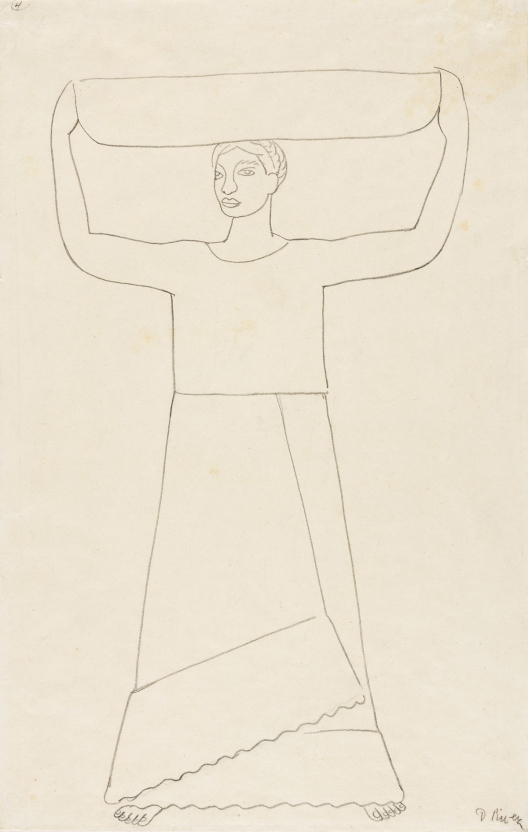

Diego rivera
Tehuana con batea.

Pencil on cream wove paper, 1922. 336x215 mm; 13¼x8½ inches. Signed in pencil, lower right recto, and inscribed “4” in pencil, upper left recto.
Provenance: Mary-Anne Martin Fine Art, New York, with the label; Patricia Whitman, New York; thence to her estate, 2017.
Patricia Dowd Whitman was an admired staff member at The Museum of Modern Art, New York from 1974 until she retired in 2007. She was responsible for building relationships with donors and artists such as Dorothea Rockburne, Tom Otterness, and Jeanne-Claude and Christo. From 1990 until her retirement, she was the Director of the Contemporary Arts Council at MoMA.
Estimate
$6,000 – $9,000



Diego rivera
Cabeza de Mujer.

Pencil on handmade paper, 1920. 245x205 mm; 9⅝x8⅛ inches. Signed in pencil, lower right recto.
Provenance: Patricia Whitman, New York; thence to her estate, 2017.
Published: Gutiérrez, Diego Rivera: catálogo de obra de caballete, Instituto Nacional de Bellas Artes, Mexico City, 1989, page 50, number 330 (illustrated).
Patricia Dowd Whitman was an admired staff member at The Museum of Modern Art, New York from 1974 until she retired in 2007. She was responsible for building relationships with donors and artists such as Dorothea Rockburne, Tom Otterness, and Jeanne-Claude and Christo. From 1990 until her retirement, she was the Director of the Contemporary Arts Council at MoMA.
Estimate
$6,000 – $9,000



Diego rivera
Dos figuras sentadas.

Brush and ink on Japan paper, 1939. 270x390 mm; 10¾x15¼ inches. Signed and dated in ink, lower left recto.
Provenance: Private collection, Michigan.
Estimate
$7,000 – $10,000



José clemente orozco
Desocupado.

Lithograph, 1932. 375x265 mm; 14¾x10½ inches, full margins. Numbered 50/100 in pencil, lower left. With the “Made in France” ink stamp, lower right. Printed by Desjobert, Paris. Published by Delphic Studios, New York. A superb, richly-inked impression of this scarce lithograph.
According to Hopkins, “In 1932 while in Paris, Orozco became acquainted with touche the ink could be applied to the [lithograph] stone with a brush for rich black tones. Experimenting with this in his only work produced outside of continental America, Desocupado (or Unemployed—Paris), 1932, Orozco diluted the liquid to achieve a watercolor affect and also put it on thickly, scratching away parts of it with a needle for greater characterization in detail.” Hopkins 22.
Estimate
$1,500 – $2,500



José clemente orozco
Mujeres I.

Lithograph, 1935. 310x440 mm; 12¼x17½ inches, full margins. Signed and numbered 45/140 in pencil, lower margin. A very good impression.
This lithograph is based on La Katharsis, 1935, a fresco panel at the Palacio de Bellas Artes, Mexico City. Hopkins 28.
Estimate
$1,500 – $2,500

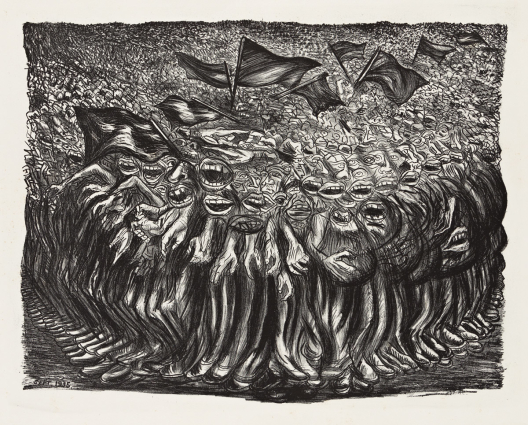

José clement orozco
Las Masas.

Lithograph, 1935. 330x425 mm; 13x16¾ inches, full margins. Edition of 120. A superb, dark impression of this scarce lithograph.
According to Hopkins, “In one specific instance Orozco used a theme from a lithograph as the basis for a fresco panel. The lithograph Las Masas (or The Masses), was later reproduced on the wall [as a fresco] of the Gabiño Ortíz library at Jiquilpan, Michoacán in 1940.” Hopkins 24.
Estimate
$1,000 – $1,500

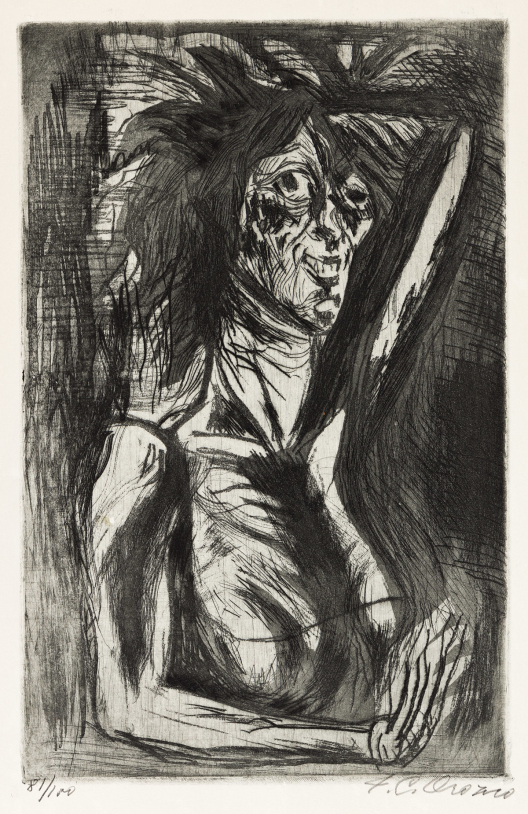

José clemente orozco
Loca.

Etching and aquatint, 1944. 265x172 mm; 10½x6¾ inches, full margins. Signed in and numbered 81/100 pencil, lower margin. A very good, dark impression of this scarce etching. Hopkins 38.
Estimate
$1,200 – $1,800



José clemente orozco
Los hombres colgados (The Hanged Men).

Lithograph, 1933-34. 325x227 mm; 12¾x8¾ inches, full margins. Edition of 100. Signed in pencil, lower margin. Printed by George C. Miller, New York. Published by Contemporary Print Group, New York. A very good impression.
Alternatively titled The American Scene, this lithograph was made for the American Civil Rights Congress, with all proceeds from sales going to fight segregation and racial discrimination. Hopkins 23.
Estimate
$2,000 – $3,000



Leopoldo méndez
Deportación a la Muerte.

Linoleum cut, 1942. 350x498 mm; 13¾x19⅝ inches, full margins. Signed in pencil, lower right. Printed and published by Taller de Gráfica Popular, Mexico City.
This linoleum cut by Méndez (1902-1969) calls to attention the deportation of the masses of the persecuted population of Europe to Nazi concentration camps during World War II. Founded by Méndez and other artists in Mexico City in 1937, the Taller de Gráfica Popular was committed to spreading anti-Fascist messages through linoleum cuts, a less expensive and more widely-accessible printmaking technique.
Assisting the Liga Pro Cultura Alemana, an anti-Nazi organization established in Mexico in 1938, the Taller de Gráfica Popular workshop targeted what it saw as the two pillars of nazism: systematic use of terror and antisemitism.
This image was used as an illustration in 1943 for, El Libro negro del terror nazi en Europa (or The Black Book of Nazi Terror in Europe).
Estimate
$1,000 – $1,500

Leopoldo méndez
La Carreta.

Linoleum cut. 305x415 mm; 12x16⅜ inches, full margins. Signed in crayon, lower right margin.
Mendez (1902-1969), a Mexican muralist and activist founded the workshop Taller de Gráfica Popular in 1937. The TGP championed anti-fascist ideology and social progress and worked to spread these ideals to the Mexican public.
With—EVERARDO RAMIREZ. Untitled, linoleum cut. 276x308mm; 10⅞x12⅛ inches, wide margins. Signed in pencil, lower margin.
Estimate
$1,200 – $1,800



Francisco dosamantes
Mujeres Mayas Tejiendo (Mayan Women Weaving).

Lithograph, 1946. 325x220 mm; 12¾x8¾ inches, full margins. Signed, dated and indistinctly numbered in pencil, lower right. A very good impression of this extremely scarce lithograph.
Estimate
$1,000 – $1,500



Miguel covarrubias
Guatemala.

Pen and ink on imitation vellum. 400x280 mm; 15¾x11 inches. Signed in ink, lower right recto.
Provenance: With Beaverbrook Art Gallery, New Brunswick, with the label; private collection, New York.
Estimate
$2,000 – $3,000



Miguel covarrubias
Rumba.

Lithograph, 1942. 235x340 mm; 9¼x13¼ inches, full margins. Edition of 250. Signed in pencil, lower right. Published by Associated American Artists, New York. A very good impression.
Estimate
$2,000 – $3,000



David a. siqueiros
Dos Niños.

Lithograph, 1956. 768x585 mm; 30¼x23 inches, full margins. Signed, dated and inscribed “E/E” in pencil, lower margin. Printed by Elizabeth Catlett, Mexico City. A very good, well-inked impression of this large, scarce lithograph.
Estimate
$1,500 – $2,500

David a. siqueiros
Group of 5 color lithographs.

Tierra Roja, 1968. Signed and numbered 239/300 in pencil, lower margin * Mountain Dancers, 1968. Signed and numbered 239/300 in pencil, lower margin * Indios, 1968. Signed and numbered 245/300 in pencil, lower margin. Each from Mexican Suite * Autorretrato, 1969. Signed and numbered 120/250 in pencil, lower margin * Mujer en la Cárcel, 1969. Signed and numbered 120/250 in pencil, lower margin. Each from Mountain Suite. Various sizes and conditions. Very good impressions with strong colors.
Estimate
$1,500 – $2,500

David a. siqueiros
Group of 7 color lithographs.

El Vuelo, 1968. Signed and numbered 30/300 in pencil, lower margin * Meditation, 1968. Signed and numbered 29/300 in pencil, lower margin * Tierra Roja, 1968. Artist’s proof, aside from the edition of 300. Signed and inscribed “E.A” in pencil, lower margin. Each from Mexican Suite * Cristo Amputado, 1969. Signed and numbered 83/250 in pencil, lower margin * Vista Aerea, 1969. Signed and numbered 121/250 in pencil, lower margin * Volcán Fosforescente, 1969. Signed and numbered 175/250 in pencil, lower margin * Paisaje Montañas, 1969. Signed and numbered 121/250 in pencil, lower margin. Each from Mountain Suite. Various sizes and conditions. Very good impressions with strong colors.
Estimate
$2,000 – $3,000



Fanny rabel
La Familia.

Acrylic on Masonite, 1956. 1220x910 mm; 48x35⅞ inches. Signed and dated in oil, lower right recto.
Provenance: With the Instituto Nacional de Bellas Artes, Museo Nactional, Mexico City, with the label; private collection, New York.
Rabel (1922-2008) is considered the first modern female muralist in Mexico, but also worked in painting, engraving, drawing and ceramic sculpture. Born in Poland, her family moved to Paris in 1929 before settling in Mexico in 1936. She studied drawing and engraving at the Escuela Nocturna para Trabajadores before continuing her training at the Escuela Nacional de Pintura, Escultura, y Grabado, Mexico City, in 1942.
She was one of four students, nicknamed “Los Fridos,” who studied under Frida Kahlo at her home in Mexico City, the Casa Azul. Rabel apprenticed with the important muralists Diego Rivera (1886-1957) and David A. Siqueiros (1896-1974), and completed numerous murals herself, including her most significant work La Ronda en el Tiempo, 1964 , located in the Museo Nacional de Antropología, Mexico City. She was a member of the Salón de la Plástica Mexicana and the Taller de Gráfica Popular. Her work focused on themes of injustice, Mexican culture and family, and later in her career she created work related to ecology.
Estimate
$5,000 – $8,000



Rodolfo morales
Hombre con Sandia.

Acrylic on Masonite, circa 1960. 612x422 mm; 24¼x16¾ inches. Signed, titled and annotated in ink, verso.
Provenance: Private collection, New York; private collection, Chicago.
A Zapotec Native American, born to working class parents in the small town of Ocotlán de Morelos, Morales (1925-2001) was a solitary child who gravitated to art. From 1948 to 1953 he studied art at the Academy of San Carlos in Mexico City. He graduated with a specialty in drawing and began a 32-year career as an art teacher at Escuela Nacional Preparatoria, a position he held from 1953 until 1985. Morales is best known for his brightly colored surrealistic dream-like canvases and collages, made at the height of his career, often featuring Mexican women in village settings. He was notable for his restoration of historic buildings in Ocotlán de Morelos and, together with Rufino Tamayo and Francisco Toledo, helped make Oaxaca in Southern Mexico a center for contemporary art and tourism.
A similar painting, and possibly a pendant to the current work, was sold at Bonhams, New York, November 7, 2011, lot 39.
Estimate
$3,000 – $5,000



Francisco zúñiga
Desnudo de espalda.

Brown and black chalks and pencil on cream wove paper, 1963. 640x495 mm; 25¼x19½ inches. Signed and dated in pencil, lower left recto.
Provenance: Megan E. Brown, Washington, D.C., until June 23, 1998; acquired June 23, 1998 and by descent to the Estate of Mirtha V. Perea, Ambassador in the Costa Rican Foreign Service, Potomac, Maryland; private collection, Chicago.
This drawing will be included in the forthcoming Francisco Zúñiga, Catalogue Raisonné, Volume V: Drawings in preparation by Ariel Zúñiga. A certificate of authenticity may be acquired from Ariel Zúñiga.
Estimate
$3,000 – $5,000



Francisco zúñiga
Mujer sentada.

Crayon and touches of white gouache on cream laid paper, 1977. 503x648 mm; 20x25½ inches. Signed and dated in charcoal, lower left recto.
Provenance: Private collection, New York; private collection, Chicago.
Published: Zúñiga, Francisco Zúñiga, Catalogue Raisonné, Volume IV: Drawings 1971-1989, 2006, number 2533.
Estimate
$3,000 – $5,000



Francisco zúñiga
Madre Juchiteca.

Color lithograph, 1973. 559x762 mm; 22x30 inches (sheet), full margins. Signed, dated and numbered 43/100 in pencil, lower margin. Published by Editions Press, San Francisco. A very good impression with fresh colors. Vlady 241.
Estimate
$1,200 – $1,800



Francisco zúñiga
Gruppo de Mujeres Sentadas, I.

Color lithograph, 1974. 535x672 mm; 21¼x26½ inches (sheet), full margins. Signed, dated and numbered 59/92 in pencil, lower margin. Printed by Kyron, Mexico City. Co-published by Kyron, and Tasende, Mexico City. A very good impression. Vlady 244.
Estimate
$1,200 – $1,800



Francisco zúñiga
Grupo de Mujeres Sentadas, II.

Color lithograph, 1976. 630x910 mm; 24¾x36 inches, full margins. Signed, dated and numbered 118/125 in pencil, lower left. Printed and published by Kyron, Mexico, with the blind stamp lower right. A superb impression of this large lithograph with strong colors. Vlady 27.
Estimate
$1,500 – $2,500



Francisco zúñiga
Muchacha en una Silla.

Color lithograph, 1982. 590x435 mm; 23¼x17⅛ inches (sheet). Signed, dated and numbered 126/135 in pencil, upper left. Printed by Kyron, Mexico City. Published by Brewster Editions, New York. A very good impression with strong colors. Vlady 85.
Estimate
$1,000 – $1,500



Francisco zúñiga
Cuatro figuras de píe.

Color lithograph on tan wove paper, 1979. 438x603 mm; 17¼x23¾ inches (sheet), full margins. Third state (of 5). Signed, dated, inscribed “E III” and numbered XXIII/XXV in pencil, lower left. Printed by Kyron, Mexico City. Published by Brewster Editions, New York. A very good impression. Vlady 49.
Estimate
$1,500 – $2,500



Francisco zúñiga
Tres mujeres de píe, II.

Color lithograph, 1983. 571x400 mm; 22½x15½ (sheet), full margins. Signed, dated and numbered 134/135 in pencil, lower left. Printed by Kyron, Mexico City. Published by Brewster Editions, New York. A very good impression with strong colors.
With— Impresiones de Egipto, plancha 10. Color lithograph, 1982. 350x498mm; 13¾x19<AF5/8> inches (sheet), full margins. Signed, dated and numbered 66/90 in pencil, lower left. Printed by Mourlot, Paris. Published by Brewster Editions, New York. Vlady 94 and 83.
Estimate
$1,000 – $1,500

Francisco zúñiga
Group of 5 drawings.

Each brush ink on paper, circa 1984. Each 301x225 mm; 11⅞x8⅞ inches.
Provenance: Gifted by the artist to current owner, Master Printer and artist Anthony Kirk, New York, 1984.
Kirk meet Zúñiga (1912-1998) while working as a printer in the workshop of Eldindean Press, New York, and collaborated on the artist's first and only editioned etching, Pilar en la Ventana, 1984 (Vlady 333).
These drawings will be included in the forthcoming Francisco Zúñiga, Catalogue Raisonné, Volume V: Drawings in preparation by Ariel Zúñiga. A certificate of authenticity may be acquired from Ariel Zúñiga.
Estimate
$5,000 – $8,000



Rufino tamayo
Torso de Mujer.

Color lithograph, 1969. 695x535 mm; 27⅜x21⅛ inches, full margins. Signed and numbered 2/150 in pencil, lower margin. Printed by Desjobert, Paris. Published by Touchstone Publishers, Ltd., New York. From Mujeres. A very good impression. Pereda 108.
Estimate
$2,000 – $3,000



Rufino tamayo
Venus Negra.

Color lithograph, 1969. 697x533 mm; 27½x21 inches, full margins. An hors commerce impression, aside from the edition of 150. Signed and inscribed “H.C.” in pencil, lower margin. Printed by Desjobert, Paris. Published by Touchstone Publishers, Ltd., New York. From Mujeres. A very good impression. Pereda 110.
Estimate
$2,000 – $3,000

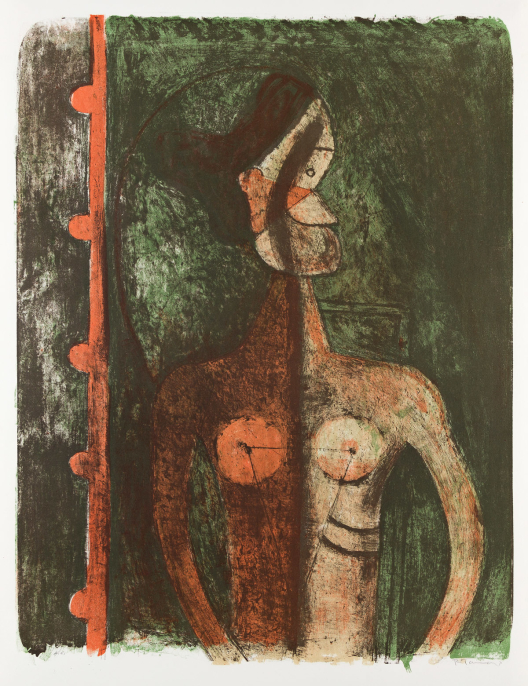

Rufino tamayo
Torso de Joven.

Color lithograph, 1969. 693x540 mm; 27¼x21¼ inches, full margins. An hors commerce impression, aside from the edition of 150. Signed and inscribed “H.C.” in pencil, lower margin. Printed by Desjobert, Paris. Published by Touchstone Publishers, Ltd., New York. From Mujeres. A very good impression. Pereda 112.
Estimate
$2,000 – $3,000



Rufino tamayo
Mujer en Lila.

Color lithograph, 1969. 693x540 mm; 27¼x21¼ inches, full margins. An hors commerce impression, aside from the edition of 150. Signed and inscribed “H.C.” in pencil, lower margin. Printed by Desjobert, Paris. Published by Touchstone Publishers, Ltd., New York. From Mujeres. A very good impression. Pereda 113.
Estimate
$2,000 – $3,000



Rufino tamayo
Mujer con Medias Malva.

Color lithograph, 1969. 690x540 mm; 27¼x21½ inches, full margins. Signed and numbered 55/150 in pencil, lower margin. Printed by Desjobert, Paris. Published by Touchstone Publishers, Ltd., New York. From Mujeres. A very good impression with strong colors. Pereda 115.
Estimate
$1,500 – $2,500



Rufino tamayo
Mujer con Mallas Rose.

Color lithograph, 1969. 685x525 mm; 27½x20¾ inches, full margins. Signed and numbered 124/150 in pencil, lower margin. Printed by Desjobert, Paris. Published by Touchstone Publishers, Ltd., New York. From Mujeres. A very good impression. Pereda 116.
Estimate
$2,000 – $3,000



Rufino tamayo
Mujer en Rojo.

Color lithograph, 1969. 693x540 mm; 27¼x21¼ inches, full margins. An hors commerce impression, aside from the edition of 150. Signed and inscribed “H.C.” in pencil, lower margin. Printed by Desjobert, Paris. Published by Touchstone Publishers, Ltd., New York. From Mujeres. A very good impression. Pereda 121.
Estimate
$2,000 – $3,000



Rufino tamayo
Afiche (Mujer).

Color lithograph, 1969. 845x615 mm; 33¼x24¼ inches (sheet), full margins. An hors commerce impression, aside from the edition of 150. Signed and inscribed “H.C.” in pencil, lower margin. Printed by Desjobert, Paris. Published by Touchstone Publishers, Ltd., New York. From Mujeres. A very good impression with vibrant colors. Pereda 122.
Estimate
$2,500 – $3,500



Rufino tamayo
Dos Caras.

Color lithograph, 1973. 560x760 mm; 22⅛x30 inches, full margins. Artist’s proof, aside from the edition of 100. Signed, inscribed and numbered “AP 2/10” in pencil, lower recto. Printed by American Atelier, New York. A good impression. Pereda 155.
Estimate
$2,500 – $3,500

Rufino tamayo
Group of 4 color lithographs from Los Signos Existen.

Each 1974. Each 700x495 mm; 27⅝x19½ inches (sheet), full margins. Each an artist’s proof, aside from the edition of 100. Each signed and inscribed “prova di stampa” in pencil, lower recto. Each printed by Franco Cioppi, Rome. Each published by Edizioni d’Arte AKA, Rome. Each from Los Signos Existen. Very good impressions with strong colors. Pereda 156 and 158-160.
Estimate
$4,000 – $6,000



Rufino tamayo
Cabeza Roja.

Lithograph, 1975. 760x560 mm; 30x22¼ inches (sheet), full margins. Signed and numbered 21/100 in pencil, lower margin. Printed at Kyron Ediciones Gráficas Limitadas, Mexico City, with the blind stamp lower right. Published by Ferdiand Roten Galleries, Baltimore. A superb impression of this large lithograph with vibrant colors. Pereda 187.
Estimate
$4,000 – $6,000



Rufino tamayo
Dos Figuras.

Color Mixografía, 1976. 568x765 mm; 22½x30 inches (sheet), full margins. Signed and numbered 50/140 in white crayon, lower margin. Printed by Taller de Gráfica Mexicana, Mexico City. Published by Transworld Art, New York. A superb, richly-inked impression with strong colors. Pereda 220.
Estimate
$3,000 – $5,000



Rufino tamayo
La Cirquera.

Color aquatint, 1984. 760x555 mm; 30x21¾ inches (sheet), full margins. One of 15 numbered hors commerce impressions. Signed and numbered “HC 5/15” in black crayon, lower margin. Printed and published by Ediciones Polígrafa, Barcelona. From Rufino Tamayo 8 aguafuertes 1984. A very good impression. Pereda 314.
Estimate
$3,000 – $5,000



Jose maria de servin
Sin título (Abstracción).

Oil on canvas, circa 1940. 995x995 mm; 39⅛x39⅛ inches. Signed in oil, lower right recto.
Provenance: Throckmorton Fine Art, New York, with the label on the frame back; private collection, New York.
Servin (1917-1983 ) was a Mexican muralist born in the state of Michoacán. He escaped with his family during the early 1920s Cristero War, which plagued central and western Mexico, to Guadalajara, Jalisco. He worked with José Clemente Orozco on several murals in and around Guadalajara and had his first solo exhibition there in 1940. He became a prominent member of the artist collectives Pintores Jovenes Jalisco and Grupo Evolucion both based in Guadalajara in the 1930s-50s. Servin also taught as a fine art professor at the University of Arizona, Tucson, and made murals in Phoenix, Arizona, and Tijuana and Monterrey, Mexico.
Estimate
$3,000 – $5,000

Roberto matta
Cosi fan Tutte.

Complete set of 10 color aquatints with etching and printed title page, 1970. 665x500 mm; 26¼x19¾ inches (sheets), full margins, loose as issued.
Each signed and numbered 70/100 in pencil, lower margin. Printed and published by Georges Visat, Paris. Superb impressions with strong colors. Sabatier 224-233.
Estimate
$2,500 – $3,500



Xavier esqueda
Bodegón con caramelos de limón y arándanos.

Oil on canvas, 1967. 300x250 mm; 11¾x9¾ inches. Signed in oil, lower right recto.
Provenance: The Contemporaries, New York, with the label on the frame back; private collection, New York.
Esqueda was born in Mexico City in 1943. His polished, highly-finished paintings and sculptures are influenced by Op and Pop art.
Estimate
$1,000 – $1,500



Ángel botello
Desnudo.

Color screenprint on fibrous wove paper, circa 1940-50. 368x432 mm; 14½x17 inches, full margins. Signed and numbered 27/50 in black ink, lower margin. A very good impression of this scarce, early work.
Estimate
$1,200 – $1,800



Ángel botello
Mujer con Flores.

Color linoleum cut with applied pigment on black wove paper. 605x505 mm; 23¾x20 inches, full margins. Signed and numbered 12/100 in ink, lower recto. A very good impression with vibrant colors.
Estimate
$1,200 – $1,800



Ángel botello
Niña Jugando con Estrella de Mar.

Color linoleum cut on black wove paper. 330x278 mm; 13x11 inches, full margins. Signed and numbered 50/100, lower recto. A very good impression with strong colors.
Estimate
$1,000 – $1,500



Ángel botello
Niño Sentado.

Color lithograph. 585x442mm; 23x17½ inches. An hors commerce impression. Signed, dedicated and inscribed "H/C" in pencil, lower margin. Printed by Claude Jobin Grapholith, Paris with the blind stamp lower right. A superb impression with fresh colors.
Estimate
$1,200 – $1,800



Fernando botero
To Amnesty International.

Color offset lithograph, 1976. 575x403 mm; 22¾x16 inches, full margins. Signed, dated and numbered 29/100 in pencil, lower margin.
Estimate
$2,000 – $3,000
Modern European



Giacomo balla
Il disperato; Autoritratto.

Oil on canvas, 1898-1900. 600x395 mm; 23¾x15¾ inches. Signed in oil, lower right recto.
Provenance: The artist, Paris, circa 1900; thence by descent to the artist's daughters, Luce and Elica Balla, Rome, 1958; Virginia Dortch Dorazio, New York, 1975; private collection, New Jersey, 1982.
Published: Lista, Balla, Edizioni Fonte d'Abisso, Modena, 1982, number 31 (illustrated page 109); Elica Balla, Con Balla, Multhipla Edizioni, Milan, 1984, volume I, page 37.
This lot is accompanied by a photo certificate of authenticity issued by Elena Gigli, Archivo Gigli, Rome, dated November 16, 2021, with the registration number 618/B.
Following in the vibrant tradition of self-portrayal by artists from Rembrandt van Rijn to Vincent van Gogh, Balla (1871-1958) painted more than 90 portraits of himself over the course of his productive career. These self-portraits bear witness to not only his physical aging with the elapse of time, but also his ever present spiritual spark and his strong experimental streak. By the time Balla painted this early self-portrait, he had settled in Rome after completing his studies at the Albertina Academy of Fine Arts in Turin. He had forged close relationships with fellow artists Umberto Boccioni and Gino Severini; the group would become the core of the Italian Futurist movement. During this time, Balla's work was concerned with capturing the effects of light, evident in the treatment of the brim of his hat, the tip of his nose, and his mustache and expressing his individuality (he wrote during this time, "mangia e veste a modo suo" or "one eats and dresses in his own way").
Balla's daughter, Elica, described this early self-portrait by her father in Con Balla as an image of a man in a single moment, desperately looking for opportunity, with his hat and upturned collar. It ranks among the most striking self portraits by an artist at the outset of a career, with a breathtaking self presence in character and a bravura handling of the medium. As this early work demonstrates, Balla's knack for depicting the dynamism and potential of movement in a single moment in time would become a hallmark of the Futurist movement of which he was a leading figure.
Estimate
$70,000 – $100,000



Jean-émile laboureur
La Marchande de Violettes.

Etching, 1914. 271x224 mm; 10¾x8¾ inches, full margins. Artist’s proof, aside from the edition of 35. Signed and inscribed “ép. d’artiste” in pencil, lower margin. A superb impression of this very scarce, early Cubist etching. Laboureur 132.
Estimate
$1,500 – $2,500



Jean-émile laboureur
La Fille au Litre (grande planche).

Engraving, 1921. 215x180 mm; 8½x7⅛ inches, full margins. Third state (of 3). Signed and numbered 63/65 in pencil, lower margin. A very good impression. Laboureur 217.
Estimate
$1,000 – $1,500

François pompon
Coq dormant.

Patinated bronze, 1927. 220x300x115 mm; 8⅝x12x4½ inches. From a total edition of 46. Signed with the foundry mark on top of the base and numbered "(B-5)" and inscribed "France" on the edge of the base. Cast by A. A. Hébrard, Paris.
According to Chevillot, example "B 5" was executed on November 19, 1927 and sold on December 5 of the same year at Tiffany & Co., New York.
Published: Chevillot, François Pompon, Paris, 1994, page 194, number 52.
Coq dormant was designed by Pompon (1855-1933) in 1914, before he found success as an independent sculptor (he had served as a studio assistant for Auguste Rodin from 1890-1897). Between 1918 and 1932, Fonderie Hébrard cast Coq Dormant in five editions, numbered 1 to 10, A1 to A10, B1 to B10, C1 to C10, and D1 to D6. Pompon's work, relying on streamlined, fluid forms, was finally publicly acclaimed at the 1922 Salon d'Automne with his exhibition of Ours blanc (Polar Bear).
Estimate
$15,000 – $20,000

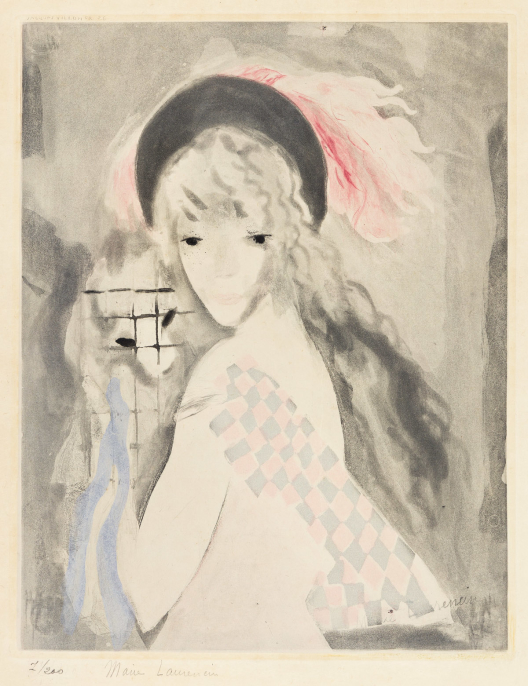

Marie laurencin (after)
La Femme au Singe.

Color aquatint, drypoint and roulette, circa 1926. 327x260 mm; 13x10 inches, full margins. Signed by Laurencin and numbered 7/200 in pencil, lower left. Etched by Jacques Villon. Published by Galerie Bernheim-Jeune, Paris. A very good impression. Ginestet/Pouillon 648 (Villon).
Estimate
$1,500 – $2,500



Marie laurencin (after)
La Femme au Hamac.

Color aquatint, 1924. 435x547 mm; 17⅛x21¼ inches, full margins. Signed by Laurencin and numbered 60/200 in pencil, lower left margin. Etched by Jacques Villon. Published by Galerie Bernheim-Jeune, Paris. A very good impression. Ginestet/Pouillon 642 (Villon).
Estimate
$1,500 – $2,500



Marie laurencin
L’Éventail rose.

Color etching and drypoint, 1927. 298x249 mm; 11¾x9¾ inches, full margins. Fourth state (of 4). Signed and numbered 54/100 in pencil, lower margin. A very good impression of this scarce etching. Marchesseau 126.
Estimate
$1,500 – $2,500



Marie laurencin
Les Deux Anges.

Color lithograph, 1949. 280x210 mm; 11¼x8½ inches, full margins. Second state (of 2). Signed and numbered 19/160 in pencil, lower left. A very good impression with strong colors. Marchesseau 254.
Estimate
$1,000 – $1,500

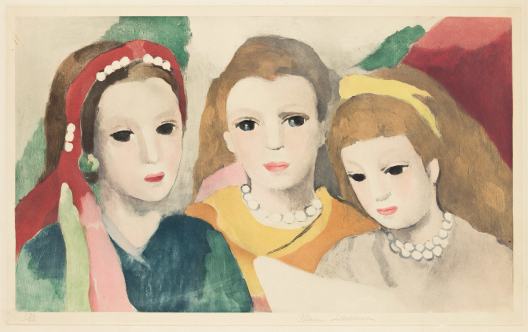

Marie laurencin (after)
Trois Femmes en Buste.

Color etching and heliogravure, circa 1925. 330x540 mm; 13x21¼ inches, wide margins. Signed and numbered 174/200 in pencil, lower margin. A very good impression with strong colors.
Estimate
$1,500 – $2,500



Pablo picasso (after)
Mère et enfant au fichu.

Color lithograph, 1966. 458x410 mm; 18x16¼ inches, full margins. The deluxe edition of 60, before the poster edition with letters. Signed in pencil, lower right. Published by the Museo Picasso, Barcelona. From the Barcelona Suite. A very good impression with fresh colors.
This is based on Picasso’s (1881-1973) color pastel drawing now in the Museu Picasso, Barcelona. It is among the masterworks of Picasso’s early career “Blue Period” between 1901 and 1904 when he painted essentially monochromatic paintings in shades of blue and blue-green. Czwiklitzer 231.
Estimate
$2,500 – $3,500



Pablo picasso
Buste d’Homme.

Drypoint, 1905. 120x87 mm; 4¾x3½ inches, wide margins. Edition of 250. Printed by Louis Fort, Paris. Published by Vollard, Paris. From La Suite des Saltimbanques. A very good, richly-inked impression of this scarce, early drypoint with strong contrasts and no sign of wear. Bloch 10; Geiser 12.
Estimate
$4,000 – $6,000



Pablo picasso
Les Saltimbanques.

Drypoint, 1905. 286x330 mm; 11¼x13 inches, full margins. Edition of 250. Printed by Louis Fort, Paris. Published by Vollard, Paris. From La Suite des Saltimbanques. A superb impression with strong contrasts, burr and partially inky plate edges. Bloch 7; Geiser 9.
Estimate
$5,000 – $8,000



Pablo picasso
Quatre femmes en fruite.

Etching on imitation Japan paper, 1931. 325x255 mm; 12¾x10⅛ (sheet), full margins. Artist’s proof, with the remarqué lower right, aside from the edition of 145. Signed in pencil, lower right. Published by Albert Skira, Lausanne. From Métamorphoses d’Ovide. A very good impression of this scarce, early proof. Bloch 117; Geiser 161.
Estimate
$3,000 – $5,000



Pablo picasso
Deux Sculpteurs devant une Statue.

Etching, 1931. 222x313 mm; 8¾x12⅜ inches, full margins. Edition of 260. Signed in pencil, lower right. Picasso watermark. Printed by Lacourière, Paris. Published by Vollard, Paris. A very good, dark and evenly-printed impression with strong contrasts. Bloch 140; Geiser 207.
Estimate
$7,000 – $10,000



Pablo picasso
Le Viol.

Etching, 1931. 223x310 mm; 8¾x12¼ inches, full margins. Edition of 260. Signed in pencil, lower right. Picasso watermark. Printed by Lacourière, Paris. Published by Vollard, Paris. A very good impression. Bloch 142; Geiser 209.
Estimate
$5,000 – $8,000



Pablo picasso
Marie Thérèse considérant son effigie surréaliste sculptée.

Etching, 1933. 268x190 mm; 10x7½ inches, full margins. Edition of 260. Signed in pencil, lower right. Picasso watermark. Printed by Lacourière, Paris. Published by Vollard, Paris. A very good impression.
Marie Thérèse considérant son effigie surréaliste sculptée is one of 100 different etchings from the Vollard Suite, a series Picasso (1881-1977) produced from 1930 to 1937 for Parisian publisher Ambroise Vollard. While over 300 sets were printed, complete suites are scarce, instead the prints from this series now are often found individually.
The suite spans the years of Picasso’s passionate, sometimes tumultuous affair with his teenage model and muse Marie-Thérèse Walter. Many of the earlier works in the series portray a sculptor in his studio among his work—alluding to the classical myth of Pygmalion. The later prints become increasingly dark as both his relationship with Marie-Thérèse waned and Europe entered World War II.
Marie-Thérèse became pregnant with Picasso’s child in 1934 (their daughter Maya Widmaier-Picasso, born September 5, 1935). Her pregnancy marked the end of Picasso’s then marriage to the Ballet Russe dancer Olga Koklova and also the beginning of the end of his relationship with his young model (just one year later he would meet Dora Maar— with whom Marie-Thérèse would become embattled over Picasso’s affection).
The onset of World War II and the sudden death of the publisher Vollard in a car crash in the south of France in 1939 delayed the distribution of this important suite, certainly one of the most groundbreaking print series ever created by an artist, it was not released until the 1950s. Bloch 187; Geiser 346.
Estimate
$15,000 – $20,000



Pablo picasso
Le Pigeonneau.

Linoleum cut printed in reddish brown in pale reddish orange wove paper, 1939. 158x200 mm; 6¼x7⅞ inches, full margins. Artist’s proof, aside from the deluxe edition of 226. Signed in red crayon, lower right. Printed by Robert Blanchet, Paris. Published by Jonquières and Berggruen, Paris. From 40 Dessins de Picasso en Marge du Buffon. A very good impression of this scarce, early linoleum cut. Bloch 326; Baer 1028.
Estimate
$5,000 – $8,000



Pablo picasso
Cheval.

Etching with aquatint, 1941-42. 270x215 mm; 10⅝x8½ inches, full margins. Edition of 226. Vollard watermark. Printed by Lacourière, Paris. Published by Fabiani, Paris. From Eaux-Fortes originales pour des textes de Buffon. A very good impression.
Eaux-Fortes originales pour des textes de Buffon was Picasso’s (1881-1973) take on the artistic tradition of bestiary series. He began the etchings in 1936 and promised them to his publisher Ambroise Vollard (1866-1939), who died before their completion, leaving Vollard’s associate, Martin Fabiani, to see it to completion. “The master printer Lacourière had introduced Picasso, as well as Rouault and other artists, to the lift-ground or sugar aquatint process, which allowed a variety of tones and textures within a limited range. The spontaneity of the plates is attested by the freehand margins, the rapidly drawn line, and the use of fingerprints for textural variety” (The Artist & Book 231). Bloch 328; Baer 575.
Estimate
$1,500 – $2,500

Pablo picasso
La Chèvre-Feuille.

Volume with 6 zincographs and complete text, 1943. 280x225 mm; 11x8¾ inches (sheets), full margins, bound as issued. Edition of 500. Numbered “343” on the justification page. Printed by Lacourière, Paris. Published by Robert-J. Godet, Paris. Original paper covers. Very good impressions. Bloch 361a-e; Baer 683-688; Cramer 38.
Estimate
$3,000 – $5,000



Pablo picasso
Troupe d’Acteurs.

Lithograph, 1954. 489x641 mm; 19¼x25½ inches, full margins. Signed in ink, lower left, and numbered 39/50 in pencil, lower right. A very good impression of this large, scarce lithograph. Bloch 754; Mourlot 250; Reuße 641.
Estimate
$6,000 – $9,000



Pablo picasso
Portrait de Famille IV (Quatre Personnages dont Trois assis).

Lithograph, 1962. 430x580mm; 17x22⅞ inches, full margins. Signed in red crayon and numbered 7/50 in pencil, lower margin. A very good impression of this large, scarce lithograph. Bloch 1033; Mourlot 386; Reuße 835.
Estimate
$4,000 – $6,000



Pablo picasso
Sable Mouvant.

Portfolio with complete text and 10 aquatints, 1966. 480x380 mm; 19x15 inches (sheets), full margins, loose as issued.
Edition of 255. Signed in pencil and numbered “177” on the justification page. Printed by Crommelynck, Paris. Published by Louis Broder, Paris.
Original paper and vellum wrappers and linen cover and slipcase. Superb impressions. Bloch 1183-92; Baer 1152-61.
Estimate
$12,000 – $18,000



Pablo picasso
Le Vieux Roi.

Lithograph, 1959. 655x503 mm; 25¾x19¾ inches, full margins. Edition of 1000. With the artist’s signature red ink stamp, lower right. A very good impression with strong contrasts. Bloch 869; Mourlot 317; Reuße 748.
Estimate
$1,500 – $2,500

Pablo picasso
Visage de face.

Glazed terre-de-faïence bowl painted in green, white and black, 1960. 180mm; 7⅛ inches (diameter). Numbered 11/100 in black and with the Madoura Empreinte Originale de Picasso stamp on the base. Ramié 454.
Estimate
$1,000 – $1,500

268
Pablo picasso
Sujet Poule

Glazed terre-de-faïence turned, shaped piece painted in blue and white, 1954. 137x170 mm; 5 1/4x6 3/4 inches. Edition of 500. Inscribed "Edition Picasso" in black and with the Madoura Plein Feu and Edition Picasso stamps on the base. Ramié 250.
Estimate
$5,000 – $8,000

Pablo picasso
Deux Danseurs.

Partially glazed terre-de-faïence plate painted in black and white, 1956. 250 mm; 9⅞ inches (diameter). Edition of 450. With the Madoura Plein Feu and Empreinte Originale de Picasso stamps on the base. Ramié 380.
Estimate
$4,000 – $6,000

Pablo picasso
Quatre Danseurs.

Partially glazed terre-de-faïence convex wall plaque painted in black and white, 1956. 250 mm; 9⅞ inches (diameter). Edition of 450. With the Madoura Plein Feu and Empreinte Originale de Picasso stamps, verso. Ramié 313.
Estimate
$5,000 – $8,000



Pablo picasso
Bacchanale avec une Femme assise tenant un Bébé (Mère, Danseur et Musicien).

Color linoleum cut, 1960. 640x530 mm; 25¼x21 inches, full margins. Signed and numbered 49/50 in pencil, lower margin. Printed by Arnéra, Vallauris. Published by Galerie Louise Leiris, Paris. A very good, well-inked impression with strong colors. Bloch 929; Baer 1254.
Estimate
$20,000 – $30,000



Pablo picasso
Hommage à Bacchus.

Lithograph, 1960. 499x635mm; 19⅝x25 inches, full margins. Signed and numbered 9/50 in pencil, lower margin. A very good impression of this scarce lithograph. Bloch 1006; Mourlot 336; Reuße 775.
Estimate
$15,000 – $20,000



Pablo picasso
Femme au Balcon, Affiche “Œuvre gravé” 1960.

Lithograph, 1960. 640x482 mm; 25¼x19 inches (sheet), full margins. Signed in red crayon, lower right, and numbered 3/145 in pencil, lower left. Printed by Mourlot, Paris, for the same-titled exhibition at the Galerie des Ponchettes, Nice, January-March 1960. A very good impression. Bloch 1289; Mourlot 335; Reuße 765.
Estimate
$2,500 – $3,500



Pablo picasso (after)
Art et Solidarité.

Color photolithograph, 1960-61. 656x512 mm; 25¾x20⅛ inches (sheet), full margins. From the total deluxe edition of 400 before letters, aside from the unsigned poster edition of 1000. Signed and numbered 30/200 in pencil, lower margin. Printed by Mourlot, Paris. A very good impression. Czwiklitzer 170.
Estimate
$4,000 – $6,000



Pablo picasso
Fleurs (for U.C.L.A.).

Color lithograph, 1961. 641x482mm; 25¼x19⅜ inches (sheet), wide margins. From the poster edition of 2500 on thin wove paper. Signed in red crayon, center left. A very good impression. Bloch 1297; Mourlot 351; Reuße 799.
Estimate
$4,000 – $6,000



Pablo picasso
Tête de chèvre * Colombe de paix.

Two pen and ink drawings, double-page, and extensive inscriptions in ink in the bound volume Matricule 2078 (L’affaire Henri Martin), 1954. 188x112mm; 7½x4½ inches (both sheets overall). Signed by Picasso in ink, center right page, additionally dedicated, dated and signed by Paulo Picasso, the artist’s son, Laurent Casanova, politician, and Hélène Parmelin, author, in ink on each sheet.
Provenance: Galerie François Miron, Paris, with the label; private collection, New York.
Picasso (1881-1973) joined the French Communist Party (PCF) in 1944 and remained a loyal member. Through his involvement with the PCF he met Hélène Parmelin and Laurent Casanova. Parmelin (1915-1998) was as an editor at L’humanité, the PCF newspaper, and Casanova (1906-1972) was a resistance fighter and Communist deputy. They both became life-long friends with Picasso through their shared political interests.
Estimate
$15,000 – $20,000



Pablo picasso
Femme vue de Dos.

Etching, 1956. 380x280 mm; 15x11 inches, full margins. Signed in red crayon and numbered 43/125 in pencil, lower margin. Published by Pierre Bertrand, Paris. From the deluxe edition of Témoignage. A very good impression of this scarce etching. Bloch 822; Baer 962.
Estimate
$3,000 – $5,000



Pablo picasso
Peintre et Modèle devant une Toile.

Aquatint and drypoint, 1965. 223x322mm; 8¾x12¾ inches, full margins. Signed and numbered 22/50 in pencil, lower margin. A superb, well-inked and evenly-printed impression. Bloch 1217; Baer 1199.
Estimate
$4,000 – $6,000



Pablo picasso
Séries 347:241 (Homme des bois devant une toile représentant une bacchante).

Etching, 1968. 175x260 mm; 6⅞x10¼ inches, full margins. Signed and numbered 35/50 in pencil, lower margin. Printed by Crommelynck, Mougins. Published by Galerie Louise Leiris, Paris. From 347 Gravures. A very good, well-inked impression with strong contrasts. Bloch 1721; Baer 1738.
Estimate
$5,000 – $8,000



Pablo picasso
Séries 156:56 (Peintre et femme cueillant des fleurs).

Etching, 1970. 270x345mm; 10⅝x13⅝ inches, full margins. With the artist’s signature ink stamp and numbered 8/50 in pencil, lower margin. Printed by Crommelynck, Mougins. Published by Galerie Louise Leiris, Paris. From 156 Gravures. A very good impression. Bloch 1911; Baer 1917.
Estimate
$3,000 – $5,000



Pablo picasso
Séries 156:122 (Barbu fantasmant, femmes, homme, et homme Grec au corps de femme).

Etching, 1971. 365x490 mm; 14⅜x19¼ inches, full margins. With the artist’s signature ink stamp and numbered 5/50 in pencil, lower margin. Printed by Crommelynck, Mougins. Published by Galerie Louise Leiris, Paris. From 156 Gravures. A very good impression. Bloch 1977; Baer 1986.
Estimate
$1,500 – $2,500



Pablo picasso
Portrait de Pierre Crommelynck.

Etching and aquatint, 1966. 560x395 mm; 22x15½ inches, full margins. Edition of 50. Signed in pencil, lower right. A very good impression.
Brothers Aldo, Piero, and Milan Crommelynck were responsible for printing an astonishing 45 percent of Pablo Picasso’s intaglio prints. Piero (or Pierre), the youngest brother, who bore a resemblance to Don Quixote, was the model for numerous Picasso portraits from the 1960s-70s and his likeness was used for Picasso’s bearded musketeer who appears frequently in the Celestine images of the 347 Gravures. The Crommelynck family were instrumental in Picasso’s late-career productivity and kept up with the aging artist’s relentless pace. Bloch 1378; Baer 1400.
Estimate
$4,000 – $6,000



Pablo picasso (after)
Les Portraits Imaginaires.

Color lithograph, 1969. 570x405 mm; 22½x16¼ inches, full margins. Numbered “F 75/250” in pencil, lower left. Printed by Marcel Salinas. Published by Harry N. Abrams, Inc., New York. From the same-titled portfolio. A very good impression with strong colors.
Estimate
$1,500 – $2,500



Pablo picasso (after)
Les Portraits Imaginaires.

Color lithograph, 1969. 652x500 mm; 25¾x19⅝ inches (sheet), full margins. Numbered “A 51/250” in pencil, lower left. Printed by Marcel Salinas. Published by Harry N. Abrams, Inc., New York. From the same-titled portfolio. A very good impression.
Estimate
$1,500 – $2,500



Julio gonzález
Femme nue debout.

Black and white chalks on tan wove paper, 1916. 495x247 mm; 19⅝x9⅞ inches. Signed, dated and dedicated “A mon cher ami Alexandre Mercereau” in black chalk, lower left recto.
Provenance: Alexandre Mercereau, Paris; Galerie Antoine Laurentin, Paris; private collection, New York.
The dedicatee Alexandre Mercereau (1884-1945) was a French Symbolist poet and critic who co-founded the utopian community Abbaye de Créteil during the fall of 1906. According to his friend and fellow Abbaye de Créteil founder, the artist Albert Gleizes (1881-1953), Mercereau was responsible for introducing him to Jean Metzinger (1883-1956), Robert Delaunay (1885-1941) and Henri Le Fauconnier (1881-1946) in 1910—the same year that Mercereau curated and included these artists in a Moscow exhibition, probably the first Knave of Diamonds Exhibition, a foundational moment in the Cubist art movement. By 1914, Mercereau had met the Spanish sculptor and pioneer of Cubism Julio González and became his lifelong supporter and friend.
Estimate
$5,000 – $8,000



Jacques villon
Une modèle assis.

Pencil and yellow and white chalk on light blue laid paper, 1910. 320x480mm; 12⅝x18⅞ inches. Signed and dated in pencil, lower right recto.
Provenance: Lucien Goldschmidt, New York; private collection, New York.
Estimate
$1,500 – $2,500



Jacques villon
Le Petit Équilibriste.

Drypoint, 1914. 220x164 mm; 8⅝x6½ inches, wide margins. Edition of 50. Signed and inscribed "42/60" in pencil, lower margin (the second part of the edition number miswritten). A superb, dark and richly-inked impression of this early etching. Ginestet/Pouillon 287.
Estimate
$2,000 – $3,000

Jacques villon
Two prints.

Papiers, color lithograph, 1932. 300x365 mm; 114⅞x14⅜ inches. Signed and numbered 16/175 in pencil, lower margin. Printed by Mourlot, Paris. Published by Louis Carré, Paris * La Pédicure, etching and aquatint, 1907.235x165 mm; 9⅜x6½ inches, full margins. Signed and numbered 36/50 in pencil, lower margin. Very good impressions. Ginestet/Pouilon 195 and App. 65.
With—GEORGES BRAQUE (after). Les Martinets, color lithograph * ARISTIDE MAILLOL. Femme Nue, lithograph * JACK LEVINE. L’Enlevement des Sabines, etching, 1965. Artist’s proof, aside from the edition of 250. Signed and inscribed “artist’s proof” in pencil, lower margin. Prescott 28. Various sizes and conditions.
Estimate
$1,500 – $2,500



Emil filla
Composition Cubiste.

Watercolor on cream wove paper. 413x295 mm; 16¼x11½ inches. Signed in watercolor, lower left recto.
Provenance: Sold Swann Auction Galleries, New York, March 6, 2007, sale 2106, lot 79; private collection, New York.
With an authentication by Dr. A.B. Kräl, dated October 8th 2001.
Filla (1882-1953) was a central figure of the Czech avant-garde. His early work reflects his studies of Fauvism and German Expressionism, and he later became deeply influenced by Cubism during his time in Paris in the 1910s. He was close friends with Picasso during this time and drew on his groundbreaking work. Filla later returned to Prague to teach at the Academy of Art, Architecture and Design and owing to his influence, Prague became known as the second most important center for Cubism after Paris.
Estimate
$6,000 – $9,000



Jean metzinger (after)
La Tasse de Thé.

Color aquatint, 1929. 476x443 mm; 18¾x17½ inches, full margins. Signed by Metzinger and numbered 26/200 in pencil, lower margin. Etched by Jacques Villon. Published by Galerie Bernheim-Jeune, Paris. A very good impression with strong colors.
Based on Metzinger’s Cubist oil painting, Tea Time (Woman with a Teaspoon), 1911, now in the Philadelphia Museum of Art (The Louise and Walter Arensberg Collection). Ginestet/Pouillon 666 (Villon).
Estimate
$1,500 – $2,500

Sonia delaunay
Two costume designs.

Color lithographs, 1977. Both 447x219mm; 17⅝x8⅝ inches (sheet), full margins. Both an edition of 125. Both signed in pencil, lower right. Both printed by Jacques Damase, Paris. Both from the illustrated book of Delaunay’s costume designs for Tristan Tzara’s 1923 play, Le Coeur à Gaz. Very good impressions with strong colors.
Estimate
$1,500 – $2,500



Filippo tommaso marinetti
Une assemblée tumultueuse (Sensibilité numérique).

Letterpress printed in red on yellowish light tan paper, 1919. 311x387mm; 12¼x15¼ inches (sheet), full margins. Published in Les Mots en Liberté Futuristes, Milan.
The tenets of Marinetti’s (1876-1944) “Typographic Revolution” (1913) are visually set forth in his typographic masterpiece, Les Mots en Liberté Futuristes (The Futurist Words in Freedom). The book, considered the peak of Marinetti’s typographic experimentation, contains a creative variety of hand-designed typefaces, calligraphy and dynamic layouts. In this print, Marinetti depicts Italy’s victory in World War I, using tavole parolibere (free-word pictures), a form of Futurist wordplay in which numbers, letters and signs are liberated from their functionality to create compelling visual compositions.
Estimate
$2,000 – $3,000



Wassily kandinsky
Zweite Radierung für die Editions “Cahiers d’Art.”

Etching on smooth cream wove paper, 1932. 298x240 mm; 11¾x9½ inches, full margins. Edition of approximately 100. Signed in pencil, lower right. Published by Editions Cahiers d’Art, Paris. A very good, well-inked impression. Roethel 196.
Estimate
$6,000 – $9,000



Georges braque
Job.

Drypoint, 1911. 144x200 mm; 5¾x8 inches, full margins. Edition of 100. Signed in pencil, lower right, and inscribed “No. 39” in pencil, lower left. Printed by Delâtre, Paris. Published by Kahnweiler, Paris. A superb, richly-inked impression of this scarce, early print, with strong burr.
Provenance: Dora Vallier, Paris, author of the catalogue raisonné of Braque’s printed works. Vallier 5.
Estimate
$12,000 – $18,000



Georges braque (after)
L’Aquarium.

Color aquatint, circa 1950. 255x327 mm; 10x12¾ inches, full margins. Signed and numbered 2/100 in red crayon, lower margin. Published by Maeght, Paris. A very good impression with strong colors. Maeght 1007.
Estimate
$3,000 – $5,000

Georges braque
Grandes Livres Illustrés.

Volume with one color lithograph printed in violet and a drawing in ink, 1958. 165x250 mm; 6½x9⅞ inches, full margins. An hors commerce copy, aside from the deluxe edition of 85. The lithograph signed in pencil, lower right. Signed, dated and dedicated to Fernand Mourlot, with an original drawing in ink, on the front flyleaf. Printed by Mourlot, Paris. Published by Maeght, Paris. Vallier 134.
Estimate
$3,000 – $5,000



Georges braque (after)
La Barque sur la grève.

Color lithograph, 1960. 300x730 mm; 11¾x28¾ inches, full margins. Signed and numbered 163/300 in pencil, lower margin. Published by Maeght, Paris. A very good impression of this large lithograph. Maeght 1040.
Estimate
$1,500 – $2,500



Georges braque (after)
Vase de Fleurs Jaunes

Color aquatint, circa 1955. 480x350 mm; 18⅞x13¾ inches, full margins. Signed and numbered 24/300 in pencil, lower margin. Published by Maeght, Paris, with the blind stamp lower left. A very good impression with strong colors. Maeght 1039.
Estimate
$1,500 – $2,500



Georges braque (after)
Bouquet de fleurs jaunes

Color lithograph, 1955. 305x197mm; 12x7¾ inches, full margins. The deluxe edition of 75, aside from the book edition. Signed and numbered 6/75 in pencil, lower margin. Printed by Mourlot, Paris. Published by Éditions de la revue Verve, Paris. From Verve, Revue Artistique et Litteraire, Volume VIII, numbers 31 et 32, Carnets Intimes de G. Braque. A very good impression with strong colors.
Estimate
$1,500 – $2,500



Georges braque (after)
Le Viaduc de L’Estaque

Color aquatint and engraving, circa 1950. 425x525 mm; 16¾x20¾ inches, full margins. Signed and numbered 6/150 in pencil, lower margin. A very good impression.
Based on Braque’s (1882-1963) same-titled oil painting from 1908, now in the Musée National d’Art Moderne, at Le Centre Pompidou, Paris.
Estimate
$2,500 – $3,500



David burliuk
Head

Oil on board, 1911. 445x328 mm; 17½x12⅞ inches. Signed and dated in oil, lower right recto.
Provenance: Mr. and Mrs. Sol Brody, Philadelphia; Gloria Cherkas, Pennsylvania and Florida; private collection, New Jersey.
Exhibited: Philadelphia Museum of Art, May 12-July 7, 1985, paralleling Chagall, the major retrospective which emphasized the Russian aspects in Marc Chagall’s art, with the museum label verso.
During his career, Burliuk (1882-1967) explored a diverse spectrum of artistic styles, though he always returned to a place of exuberance, often with vivid colors and broad brushstrokes. As a young man, Burliuk studied fine arts in Odessa before attending the Munich Royal Academy of Arts and the École des Beaux-Arts in Paris. In 1907, Burliuk settled in Moscow and befriended members of the city’s avant-garde. He attended the Moscow Institute of Painting, Sculpture and Architecture in 1911 until his expulsion in 1913. During these years, Burliuk was an active member of Russian Futurism and adhered to Filippo Tommaso Marinetti’s Manifesto of Futurism which idealized progress. Rejecting conventional artistic norms and public taste, Burliuk would sometimes dress wearing a wooden spoon for some of his art classes.
In the present portrait, Burliuk stressed the importance of paring down painting to the essential basic elements: line, surface, color and texture. These early paintings were often painted on hard, coarsely textured board and seem to unify elements of Cubism and Futurism. As noted in ARTnews in a 1924 exhibition review, the “coarse texture gives animation to flat areas of color.” Burliuk continued in this more abstract style until settling on Long Island in 1941. It is likely also that Burliuk returned to earlier compositions to rework them as his style evolved. During World War I, Burliuk fled Russia and travelled through Siberia, Japan and Canada promoting his art before reaching New York.
Estimate
$40,000 – $60,000

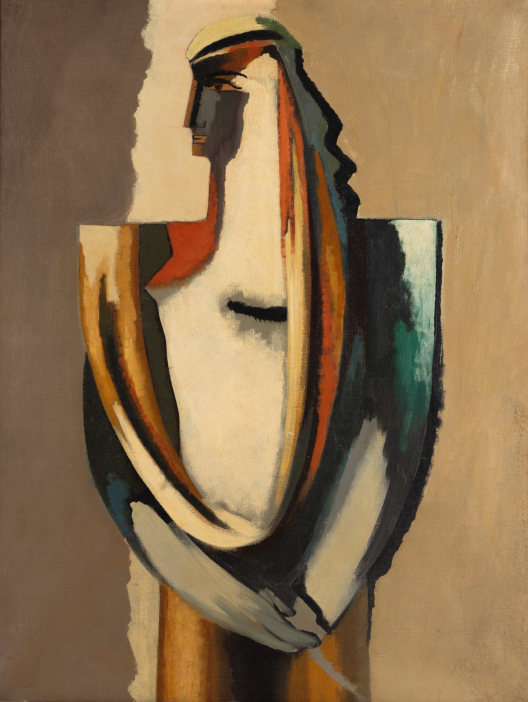

Jean lurçat
L’Arabe.

Oil on canvas, 1928. 1143x876mm; 45x34½ inches. Signed and dated in oil, upper left recto.
Provenance: Sold Sotheby Parke Bernet, New York, October 23, 1975, sale 3796B, lot 291, to current owner, private collection, New York.
Published: Denizeau, L’Œuvre peint de Jean Lurçat: Catalogue raisonné, 1910-1965, page 332, number 1928-1.
Lurçat (1892-1966) was a French artist best known for his revival of tapestry art. He was an important and successful painter for over twenty years and frequented the same artistic circles as Pablo Picasso and Louis Marcoussis before delving into textile arts in the late 193os. He traveled extensively through Europe, North Africa and the Middle East, deriving much inspiration from cultural exposure. Though Lurçat is celebrated for reviving tapestries as an art form, he experimented with many other art forms as well, such as book illustration, engraving and ceramics.
Estimate
$12,000 – $18,000



Jean lurçat
La forteresse gardée.

Oil on canvas, 1934. 654x1003mm; 25¾x39½ inches. Signed and dated in oil, lower right recto. Signed and inscribed “New York” in oil, verso.
Provenance: Sold Christie’s, New York, May 15, 1980, lot 65 to the current owner, private collection, New York.
Published: Denizeau, L’Œuvre peint de Jean Lurçat: Catalogue raisonné, 1910-1965, page 400, number 1934-6 (illustrated).
Lurçat (1892-1966) was a French artist best known for his revival of tapestry art. He was an important and successful painter for over twenty years and frequented the same artistic circles as Pablo Picasso and Louis Marcoussis before delving into textile arts in the late 193os. He traveled extensively through Europe, North Africa and the Middle East, deriving much inspiration from cultural exposure. Though Lurçat is celebrated for reviving tapestries as an art form, he experimented with many other art forms as well, such as book illustration, engraving and ceramics.
Estimate
$7,000 – $10,000



Demetrios galanis
L’Enfant au cheval mécanique.

Oil on canvas, 1914-1919. 1003x803mm; 39½x31⅝ inches. Signed in oil, lower right recto.
Provenance: Collection Seignitz; private collection, New York.
Exhibited: “Salon d’Automne,” Grand Palais, Paris, November 1-December 9, 1919, number 2094 (illustrated); “Exposition D. Galanis,” Galerie La Licorne, Paris, March 3-18, 1922, number 3.
Published: Rene-Jean, “La Peinture au Salon d’Automne,” Comoedia, November 3, 1919, page 1-2 (illustrated); Les Lettres parisiennes, January 1, 1920; Gabory, “Galanis et son ouevre,” Les peintre Français nouveaux, Librairie Gallimard, no. 25, 1926, page 10-11, 17 (illustrated); L’Art d’Aujourd’hui, Éditions Albert Morancé, Summer 1925, number 6, plate 27 (illustrated); Tassos, “A Stroll with Galanis,” Zygos, no. V-66, May 1966, reprinted in Zygos, no. 39, January-February 1980, page 39.
Galanis (1879-1966) was a Greek painter, printmaker and contemporary of artists like Picasso, Braque and Matisse, who had frequently visited Galanis at his home and studio in Montmartre. He studied at the Athens School of Fine Arts before settling in Paris and attending the École des Beaux-Arts. He achieved notable success during his time in Paris and was appointed a professor at the École des Beaux-Arts in 1945.
L’Enfant au cheval mécanique is a portrait of Galanis’s son as a child, on which he based an etching of the same title circa 1919-21. Gabory notes that although Galanis started this exemplary painting, “le tableau de Galanis le plus significatif, sa meilleure expression,” in 1914, it was not completed until 1919 due to the artist enlisting in the French military during World War I (therefore becoming a naturalized French citizen). This painting is evidence of the profound impact that the work of Cézanne and Cubism had on Galanis’s paintings.
Galanis’s son, Jean-Sebastian was born in Paris on April 13, 1910 to Galanis and his wife, Stéphanie-Julie Bouvier from Provence. Stéphanie-Julie and Jean-Sebastian feature prominently among Galanis’s subjects, the most notable of which is the 1920-21 oil on canvas The Painter’s Family, now in a private collection. Jean-Sebastian fought in the Free French Naval Forces during World War II and perished on the freighter Lisieux on November 27, 1940 off the coast of Newfoundland. Galanis mourned his son for the rest of his life, keeping a portrait of him in his studio into the 1960s.
Estimate
$20,000 – $30,000



Léon baskt
Dessin pour “Le Prince Anglais”.

Gouache, pencil and metallic paint on paper, 1921. 298x231mm; 11¾x9⅛ inches.
Provenance: Lucien Goldschmidt, New York; private collection, New York.
Bakst (1866-1924) was a revolutionary theatre and costume designer. He served as the artistic director of the renowned dance company, the Ballets Russes, for which he designed groundbreaking sets and costumes. Bakst rejected the formal and muted sensibilities in traditional ballet, introducing vibrant colors, unique forms and an emphasis on emotion and sensuality. Audiences were swept away by this “new ballet” and Bakst gained international fame, creating designs for numerous productions until his death.
Estimate
$7,000 – $10,000

Aristide maillol
Les Géorgiques.

Portfolio in three volumes with complete text and numerous woodcuts printed in sanguine and black ink, 1950. 325x241 mm; 12¾x9½ inches (sheets, folded), full margins, loose as issued.
Edition of 100 with suites printed in both sanguine and black. Each print stamped with the artist’s ink stamp in the lower margins. The suite of text numbered 701 on the justification page. The suite of woodcuts numbered “LXXVIII/C” in pencil and signed by the printer Philippe Gonin in pencil on the justification pages. Printed by Philippe Gonin, Paris.
Original printed pasteboard folders and slipcases. Very good impressions. Rauch 144.
Estimate
$1,500 – $2,500

Aristide maillol
Dialogues des Courtisanes.

Portfolio with complete text and 35 lithographs, 1948-49. 384x290 mm; 15⅛x11⅜ inches (sheets), full margins, loose as issued.
One of 15 hors commerce copies, with the lithographer’s name Marcel Durassier typed on the justification page, from the edition of 275. Printed by Mourlot, Paris. Published by Henri Creuzevault and Dina Vierny, Paris. Original vellum chemise and wrapper. Very good impressions.
Estimate
$1,500 – $2,500



Henri matisse
Le Repos du Modèle.

Lithograph on Chine volant, 1922. 223x304 mm; 8¾x12 inches, full margins. First state (of 2), before the reduction of the subject at the left edge. Edition of 85 (from an intended edition of 100). Signed in pencil, lower right. Published by Edmond Frapier, Galerie des Peintres-Graveurs, Paris. A very good impression. Duthuit 416.
Estimate
$4,000 – $6,000



Henri matisse
Nu au coussin bleu.

Lithograph, 1924. 615x475 mm; 24¼x18¾ inches, full margins. Signed and numbered 43/50 in pencil, lower margin. A superb, evenly-printed impression of this large, important lithograph with strong contrasts.
Though famous for his paintings and sculptures, Matisse (1869-1954) was also a prolific printmaker, producing over 800 individual prints (typically in editions of 25 to 50) from 1900 to 1954. He moved freely between various printmaking techniques and used printmaking as an extension of his drawing style and process. The imagery he created often was repeated forms of reclining nudes, portraits or dancing bodies drawn with elegant and energetic contour lines.
Matisse found printmaking to be an exciting medium that allowed innovation while also enabling him to produce works in multiples to satisfy the increasing demand for his art. The wide dissemination and demand for Matisse’s printed work undoubtedly contributed immensely to his position as a preeminent artist of the 20th century.
This lithograph is based on Matisse’s same-titled oil painting, also from 1924, formerly in the collection of Mrs. Sidney F. Brody (sold Christie’s, New York, May 4, 2010, lot 22). In this pose, considered iconic for Matisse, the model appears to make look effortless what is a difficult and somewhat exerting position, revisited by Matisse at the end of his career in the more abstract, blue nude cut-outs from the early 1950s. Duthuit 442.
Estimate
$15,000 – $20,000



Henri matisse
Danseuse Endormie au Divan.

Lithograph, 1925-26. 323x502mm; 12¾x19¾ inches, wide margins. Artist's proof, aside from the edition of 130. Signed and inscribed "épreuve C" in pencil, lower left. Published by Galerie d'Art Contemporain, Paris. From Dix danseuses. A very good, richly-inked impression. Duthuit 485.
Estimate
$8,000 – $12,000



Henri matisse
Portrait de Claude D.

Lithograph on annam appliqué, 1946. 371x295 mm; 14⅝x11⅝ inches, full margins. Signed and numbered 46/75 in pencil, lower margin. A very good impression of this large lithograph. Duthuit 585.
Estimate
$10,000 – $15,000



Henri matisse
Jeune femme à la chevelure encadrant le visage.

Soft-ground etching, 1948. 345x288mm; 13⅝x11⅜ inches, full margins. Signed, numbered 5/5 and dedicated, “à Nadia Sednaoui, affectueusement” in pencil, lower margin. A superb impression of this extremely scarce etching.
When Nadia Sednaoui (1925-2015) first encountered Matisse’s (1869-1954) work in an art publication as a teenager living in Cairo during World War II, she vowed one day to see his paintings in Paris. After the war, she and her parents moved to Paris, and Sednaoui finally met the long admired artist through his son-in-law and art critic, Georges Duthuit. Despite their age difference, they became friends almost immediately. Though she never called herself one of the artist’s models, Matisse would draw and paint Sednaoui during her afternoon visits in the early 1950s in the years prior to his death. Duthuit 312.
Estimate
$30,000 – $50,000



Henri matisse (after)
La Blouse Roumaine.

Color lithograph, 1940. 493x387mm; 19½x15¼ inches, full margins. Numbered 51/300 in pencil, lower left. Printed and published by Mourlot, Paris. A very good impression with strong colors.
Estimate
$1,500 – $2,500



Henri matisse (after)
Petit Intérieur Bleu.

Color aquatint, circa 1952. 505x420mm; 20x16⅛ inches, full margins. Signed and numbered 156/200 in pencil, lower margin. Printed by Lacourière, Paris. A very good impression with vibrant colors. Duthuit App. IV.
Estimate
$15,000 – $20,000

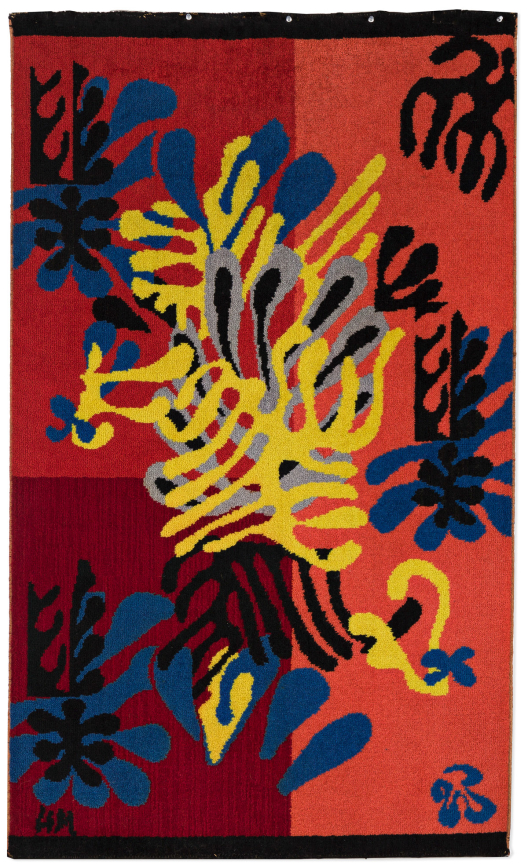

Henri matisse (after)
Mimosa.

Color aquatint, circa 1952. 505x420mm; 20x16⅛ inches, full margins. Signed and numbered 156/200 in pencil, lower margin. Printed by Lacourière, Paris. A very good impression with vibrant colors. Duthuit App. IV.
Estimate
$3,000 – $5,000



Adolphe féder
Still Life with Kettle.

Oil on canvas, circa 1908. 347x272mm; 13¾x10¾ inches. Signed in oil, lower left recto.
Provenance: Private collection, New York.
Féder (1885-1943) grew up in Odessa, Ukraine, where he became deeply involved in the Bund Labor Movement, a secular Jewish socialist party. Because of his involvement with the Bund and rising unrest in Russia, he was forced to flee to Berlin in 1904. He moved on to study at the Academy of Fine Arts in Geneva, and later at the Académie Julien, Paris. Féder flourished in Paris, becoming close friends with artists Henri Matisse, Othon Friesz and Amedeo Modigliani. He worked for French newspapers, Le Monde and La Presse, and illustrated books for Joseph Kessel and Arthur Rimbaud.
When World War II erupted and France came under the Vichy regime in collaboration with Nazi Germany, the Pétain militia arrested Féder and his wife in June 1942. They were imprisoned at Cherche-Midi military prison for four months until Féder was transferred to Drancy internment camp. Despite being interned at Drancy, Féder continued to make art, painting portraits of guards and fellow prisoners. In the winter of 1943 he was deported to Auschwitz, where he was murdered.
Estimate
$1,500 – $2,500



Adolphe féder
Seated Model.

Oil on canvas. 330x216mm; 18½x13 inches. Signed in oil, lower right recto.
Provenance: Private collection, New York.
Féder (1885-1943) grew up in Odessa, Ukraine, where he became deeply involved in the Bund Labor Movement, a secular Jewish socialist party. Because of his involvement with the Bund and rising unrest in Russia, he was forced to flee to Berlin in 1904. He moved on to study at the Academy of Fine Arts in Geneva, and later at the Académie Julien, Paris. Féder flourished in Paris, becoming close friends with artists Henri Matisse, Othon Friesz and Amedeo Modigliani. He worked for French newspapers, Le Monde and La Presse, and illustrated books for Joseph Kessel and Arthur Rimbaud.
When World War II erupted and France came under the Vichy regime in collaboration with Nazi Germany, the Pétain militia arrested Féder and his wife in June 1942. They were imprisoned at Cherche-Midi military prison for four months until Féder was transferred to Drancy internment camp. Despite being interned at Drancy, Féder continued to make art, painting portraits of guards and fellow prisoners. In the winter of 1943 he was deported to Auschwitz, where he was murdered.
Estimate
$2,000 – $3,000



Robert hermann sterl
Drei Steinmetzen am Block.

Oil on board, 1909. 226x292mm; 9x11½ inches. Signed and dated in oil, upper right recto.
Provenance: Private collection, New York.
Sterl (1867-1932) was a prolific German painter. He was born in Dresden and attended the Dresden Academy of Fine Arts, later becoming a founding member of the Dresden Secession. Sterl worked as a war painter during the First World War. Afterwards he moved to Struppen, in Saxony, where he continued painting, often creating socially-conscious work. In 1937, two of his paintings were labeled “degenerate” by the Nazi Party and were removed from the Galerie Neue Meister in Dresden. This painting of three stonemasons is representative of one of Sterl’s most beloved subjects; he painted many scenes of workers, especially quarrymen, sympathetic to their labor since his father was also a stonemason.
Estimate
$5,000 – $8,000



Walter sickert
The Old Fiddler (The Large Plate).

Etching, circa 1922. 305x252 mm; 12¼x10 inches, full margins. Signed in pencil, lower right. A superb, dark impression of this extremely scarce etching with strong contrasts. Bromberg 202.
Estimate
$1,000 – $1,500

William russell flint
Standing Nude, with right arm raised.

Red chalk on cream laid paper, circa 1920. 253x181 mm; 9¾x7 inches. Signed in red chalk, lower right recto.
With—Standing Nude, seen from behind with arms raised, red chalk on paper. 253x181 mm; 9¾x7 inches.
Provenance: Private collection, Chicago.
Estimate
$1,500 – $2,500



Eric kennington
Portrait of Alice Mary Rothenstein.

Color pastels on bluish gray paper, circa 1920. 485x350mm; 19¼x13¾ inches.
Provenance: Private collection, New York.
Kennington (1888-1960) was an English official war artist during both World War I and II. He was enlisted in World War I and fought on the Western Front, but was sent back to England in January of 1915 due to an injury. The bulk of his artwork focused on the lives of soldiers and airmen, serving as a visual memory recorder of the hardships endured. In the interwar years, he created book illustrations and portraits, such as this one of Alice Mary Rothenstein.
Alice Mary Rothenstein (1869-1955) was married to William Rothenstein (1872-1945), another English war artist who Kennington befriended during his time working in France during World War I. They were both appointed to document front line scenes at Montigny Farm and Devise on the Somme, where they came under enemy attack. When Kennington returned to London in March of 1918, he had around 170 charcoal, pastel, and watercolor drawings from his time in France. Alice Mary Rothenstein was an actress, who presumably posed for this drawing when Kennington returned to England after World War I.
Estimate
$2,000 – $3,000



Arthur meadows
Santa Marie della Salute, Venice.

Oil on canvas, 1907. 510x760 mm; 20x30 inches. Signed and dated in oil, lower right recto and signed, titled and dated in oil, verso.
Provenance: Private collection, New York.
Meadows (1843-1907) came from a family of marine artists. He painted harbours and coastal scenes in England, France, Holland and Italy. Meadows exhibited mainly at The Royal Academy, Lodnon, from 1863-72, and The British Institute, London, between 1863 and 1867. Meadows’ paintings can be found in The National Maritime Museum, London.
Estimate
$2,000 – $3,000

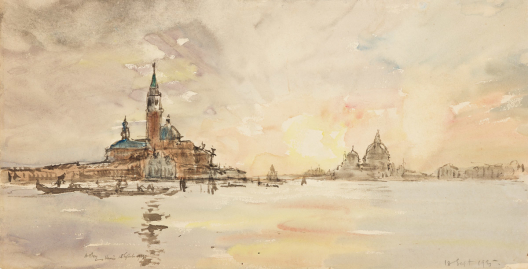

James mcbey

Entrance to the Grand Canal, Venice.
Watercolor and ink on paper, 1925. 203x393 mm; 8x15½ inches. Signed and titled in ink, lower left recto and dated in ink, lower right recto.
Provenance: Private collection, New York.
Estimate
$1,500 – $2,500



Oronato carlandi
Anzio.

Watercolor on paper. 375x559 mm; 14¾x22 inches. Signed and titled in ink, lower right recto.
Provenance: Private collection, New York.
Carlandi (1848-1939) was an Italian painter of mostly landscape scenes in Rome and the English countryside. He studied art at the Accademia di Belle Arti di Roma, later moving to England in 1880 to study English landscape artists before returning to Rome in 1891. This scene of Anzio, a coastal city south of Rome, is representative of Carlandi’s passion for capturing en plein air compositions of his beloved home country.
Estimate
$1,200 – $1,800



Henri lebasque
Marine (Barques).

Watercolor and pencil on paper, circa 1900. 316x393 mm; 12½x15½ inches. Signed in pencil, lower right recto.
Provenance: Galerie Europe, Paris, with the label; private collection, New York.
Exhibited: “Exposition du Toulouse Lautrec a Marquet,” Galerie Marcel Bernheim, Paris, June 22-July 28, 1961, number 78.
Lebasque (1865-1937), known as “the painter of joy and light,” was born in 1865 in Champigné, Maine-et-Loire, France. This watercolor sketch of a maritime scene is representative of his fascination with the dazzling French Riviera, a common theme in his œuvre. Lebasque was friends with impressionists Camille Pissarro (1830-1903) and Auguste Renoir (1841-1919), as well as Henri Matisse (1869-1954), with whom he was a founding member of the Salon D’Automne in Paris.
Estimate
$1,000 – $1,500



Jean puy
La Rochelle.

Oil on canvas, 1925. 543x740 mm; 21½x29⅛ inches. Signed and dated in oil, lower right recto.
Provenance: Private collection, Paris; Marlborough Gallery, London and New York.
Published: Limouzi and Fressonnet-Puy, Jean Puy (1876-1960), page 222, number 30040 (illustrated).
Puy was a French Fauvist artist. He studied architecture at the École nationale des beaux-arts de Lyon and painting with Jean-Paul Laurens at l’Académie Julian between 1897 and 1898. He met Henri Matisse and other like-minded artists when he transferred to the l’Académie Carrière in 1899. Puy exhibited his work in 1901, then in an Impressionist style, at the Salon des Indépendants; later, as a Fauvist, he exhibited at the 1905 Salon d’Automne.
Estimate
$8,000 – $12,000



Maurice de vlaminck
Le vieux port de Marseille.

Woodcut, 1914. 249x336 mm; 9¾x13¼ inches, full margins. Artist’s proof, aside from the edition of 30. Signed in pencil, lower right. A very good impression of this scarce, early woodcut. Walterskirchen 14.
Estimate
$1,500 – $2,500



Maurice de vlaminck
Saint-Michel.

Woodcut, 1914. 248x175 mm; 9¾x6⅞ inches, full margins. Edition of 30. Signed and inscribed “N 2” in ink, lower margin. Printed by Paul Birault, Paris. Published by Editions Henri Kahnweiler, Paris. A very good impression. Walterskirchen 19.
Estimate
$1,500 – $2,500



Maurice de vlaminck
Rue à Louveciennes.

Woodcut, 1914. 167x246mm; 6½x9¾ inches, full margins. Edition of 30. Signed and numbered “3” in pencil, lower margin. A very good impression of this scarce, early woodcut. Walterskirchen 20.
Estimate
$1,500 – $2,500



Maurice de vlaminck
Sur les bords de l’Oise.

Color lithograph, 1923. 464x565 mm; 18¼x22¼ inches, full margins. Artist’s proof, aside from the edition of 50. Signed and inscribed “EA” in pencil, lower margin. Printed by Charlot Frères, Paris. Published by Galerie Simon, Paris. A very good impression with strong colors. Walterskirchen 168.
Estimate
$1,500 – $2,500



Maurice utrillo (after)
L’Église de Limours.

Color aquatint and etching, 1927-28. 496x280 mm; 19½x11 inches, wide margins. Signed by Utrillo and numbered 20/200 in pencil (partially effaced), lower right. Etched by Jacques Villon. Published by Galerie Bernheim-Jeune, Paris. A very good impression, with strong colors. Ginestet/Pouillon 654 (Villon).
Estimate
$3,000 – $5,000

Maurice utrillo
Two lithographs.

La Place du Tertre, Montmartre, 1919. 190x270 mm; 7½x10⅝ inches, full margins. Signed and numbered 3/100 in pencil, lower margin * Montmartre, Place du Têrtre et du Sacre Couer, circa 1920. 285x225 mm; 11¼x8⅞ inches, full margins. Signed and numbered 1/4 in pencil, lower margin. Very good impressions.
Estimate
$2,000 – $3,000



Fritz glarner
Notre Dame, Paris, vue de la Seine.

Oil on board, circa 1925-30. 386x447 mm; 15x17¾ inches. Signed in oil, lower left recto, and inscribed “no. 20” in watercolor verso. With the “Douane Centrale” ink stamp verso.
Provenance: Private collection, Chicago.
Born in Zurich, Glarner (1899-1972) spent his childhood around Europe, including time in Switzerland, France and Italy. Glarner’s artistic talent was recognized at a young age and he began his formal training at the Regio Instituto di Belli Arti in Naples from 1914 to 1920. During these years, Glarner was cloistered from the avant-garde movements prevalent in Europe. It was not until 1923 on a trip to Paris that the young artist first became immersed in abstract art. While studying at the Académie Colarossi, Paris during the early 1920s, Glarner met artists at the avant-garde forefront—Sonia and Robert Delaunay, Hans Art, Fernand Léger and Piet Mondrian. Subsequently, Glarner approached his canvases with a limited palette and simplified composition, and it would not be until the 1930s that his style would become totally abstract, informed by Mondrian’s Neoplasticism.
Glarner moved to the United States briefly from 1930-31, showing in New York and most notably in Katherine Dreier’s landmark 1931 An International Exhibition Illustrating the Most Recent Development in Abstract Art at Albright-Knox Gallery, Buffalo. He returned to Paris and then to Zurich until the break out of the Spanish Civil War in 1936, which spurred him to settle in New York permanently.
Estimate
$2,000 – $3,000



Jules pascin
Scène de la Havana.

Watercolor and pencil on paper, circa 1917. 190x250mm; 7½x10 inches. Signed in pencil, lower right recto.
Provenance: Perls Galleries, New York, with a copy of the original label with the stock number 5869; private collection, Baltimore, Maryland.
Estimate
$1,500 – $2,500



Jules pascin
Femme assise.

Conté crayon on paper. 355x267mm; 14x10½ inches. Signed in crayon, upper right recto.
Provenance: Private collection, Florida.
Estimate
$1,500 – $2,500



Jules pascin
Nu allongé.

Watercolor and brown ink on paper. 285x195 mm; 11¼x7¾ inches. Signed in pencil, lower right, recto.
Provenance: The artist, Paris, with his ink stamp (Lugt 2014b, lower right recto); thence to the estate, with the ink stamp (Lugt 2014c, verso) with the number “13” in pencil; private collection, New York.
Estimate
$1,500 – $2,500



Jules pascin
Dans le Parc.

Watercolor on cream wove paper, circa 1913. 150x230 mm; 6x9 inches. Signed in pencil, lower right recto, and inscribed “no. 11” in pencil, verso.
Provenance: Purchased from the International Exhibition of Modern Art (The Armory Show), New York, March 1, 1913 by John Quinn, New York; sold in his sale, “The Renowned Collection of Modern and Ultra-Modern Art formed by the Late John Quinn,” Bernet and Parke, New York, February 9-12, 1927, lot 32 (as Figures and landscape); purchased at the former sale by Kraushaar Galleries, New York; Hyman Cohen, New York; acquired from the former’s estate by the current owner, private collection, New York.
Exhibited: “International Exhibition of Modern Art (The Armory Show)”, New York, February 17- March 15, 1913, number 481.
Published: Brummer and Weyhe, John Quinn: Collection of Paintings, Watercolors, Drawings & Sculptures, Huntington, New York, 1926, page 12; Munson-Williams-Proctor Institute, 1913 Armory Show 50th Anniversary Exhibition, Utica, 1963, page 199; Hemin, Krogh, Perls and Rambert, Pascin: Catalogue raisonné, peintures, aquarelles, pastels, dessins, Paris, 1984, vol. IV, page 59, number 177 (illustrated, as Personnages au bord de l’eau).
Estimate
$1,500 – $2,500

Boris solotareff
Sud de la France.

Oil on canvas, double-sided, circa 1920. 390x552 mm; 15½x21¾ inches.
Provenance: Borghi & Co., New York; private collection, New York.
Solotareff (1889-1966) was born in the Bessarabia region of the Russian Empire, a multicultural region with large Jewish, Romanian, and German populations. Solotareff studied in Odessa, Ukraine before moving to Munich and enrolling at the Akademie der Bildenden Künste in 1907. His Munich paintings were influenced by the German impressionist style. In 1914 after moving to Lausanne, his style took on Fauvist attributes with sweeping and vivacious colors, though the artist retained the solemnity of formal Russian painting. His style further evolved when he travelled to Paris and turned to a formalist approach, as art critic Carlyle Burrows recalled “showing admirable sensitiveness in the manner of such artists as Leonardo and Raphael.” Along with several other émigrés he settled in New York in 1937. He debuted in his newly adopted country in December 1938 at Vendome Galleries, New York to glowing reviews. He continued to paint and exhibit in New York for the rest of his life.
Estimate
$2,500 – $3,500



Boris solotareff
Nu Avec les Mains Levées.

Oil on canvas, circa 1920. 645x538 mm; 25½x21¼ inches. Signed and inscribed “Paris” in oil, upper right verso.
Provenance: Private collection, New York.
Solotareff (1889-1966) was born in the Bessarabia region of the Russian Empire, a multicultural region with large Jewish, Romanian, and German populations. Solotareff studied in Odessa, Ukraine before moving to Munich and enrolling at the Akademie der Bildenden Künste in 1907. His Munich paintings were influenced by the German impressionist style. In 1914 after moving to Lausanne, his style took on Fauvist attributes with sweeping and vivacious colors, though the artist retained the solemnity of formal Russian painting. His style further evolved when he travelled to Paris and turned to a formalist approach, as art critic Carlyle Burrows recalled “showing admirable sensitiveness in the manner of such artists as Leonardo and Raphael.” Along with several other émigrés he settled in New York in 1937. He debuted in his newly adopted country in December 1938 at Vendome Galleries, New York to glowing reviews. He continued to paint and exhibit in New York for the rest of his life.
Estimate
$2,000 – $3,000



Nicolas gloutchenko
Nu Allongé.

Oil on canvas, circa 1925. 267x407 mm; 10½x16 inches. Signed in oil, lower left recto, and signed and inscribed “Paris” in oil, verso.
Provenance: the artist Norman Carton, New York; thence by descent, private collection, New York; private collection, New York.
Born Nicholai Petrovitch Glushchenko in a Ukrainian peasant village, Gloutchenko (1901-1977) studied in Germany as a young artist at the Academy of Art in Berlin before training in Paris during the mid-1920s. In Paris, his adopted Post-Impressionist style won praise in salons and abroad; he starred in exhibitions of Soviet artists in Berlin, Brussels, Milan, Paris and Rome.
Estimate
$8,000 – $12,000



Mark tobey
Atty van den Berg.

Gouache on tan wove paper, 1935. 448x298 mm; 17⅝x11¾ inches. Signed and dated in watercolor, lower right recto.
Achim Moeller, Managing Principal of the Mark Tobey Project LLC, has confirmed the authenticity. The work is registered in the Mark Tobey archive with the number MT [359-01-28-22].
Provenance: Private collection, New Jersey.
Van den Berg (1913-2003) was a Dutch ballerina who danced with the Kurt Jooss Ballet company. In 1933, Jooss fled Germany and toured throughout Europe with the company, eventually settling in Devonshire, England to open a dance school at Dartington Hall in 1934. Jooss and the company were based at Dartington until 1940, contemporaneous to Tobey’s residency at Dartington Hall from 1931-38. Tobey painted a mural for the dance school in 1933 for which the present drawing may have been a preliminary study.
Estimate
$1,500 – $2,500



Georges rouault
La Sibylle de Cumes.

Color lithograph, circa 1928. 532x383 mm; 21x15⅛ inches, full margins. Numbered 232/250 in pencil, lower margin. A superb impression of this scarce lithograph, with strong colors. Wofsy 86.
Estimate
$1,500 – $2,500

Georges rouault
Madame Louison.

Color aquatint, 1935. 310x215 mm; 12¼x8½ inches, full margins. Edition of 280. Printed by Lacourière, Paris. Published by Vollard, Paris. From Cirque de l’Étoile Filante.
With—Christ et les Exégètes, color aquatint, 1936. 308x218 mm; 12⅛x8⅝ inches, full margins. Edition of 270. Printed by Lacourière, Paris. Published by Vollard, Paris. From Passion. Both very good impressions with strong colors. Chapon/Rouault 246 and 271; Wofsy 325 and 351.
Estimate
$1,200 – $1,800



Georges rouault
Dors mon amour.

Color aquatint, 1934. 311x193 mm; 12¼x8¼ inches, full margins. Edition of 280. Printed by Lacouriere, Paris. Published by Vollard, Paris. From Cirque de l’Étoile Filante. A superb impression with strong colors. Chapon/Rouault 256; Wofsy 335.
Estimate
$1,500 – $2,500



Georges rouault
Les Ballerines.

Color aquatint, 1934. 312x205 mm; 12¼x8 inches, full margins. Edition of 280. Printed by Lacouriére, Paris. Published by Vollard, Paris. From Cirque de l’Étoile Filante. A brilliant, richly-inked impression with vibrant colors. Chapon/Rouault 254; Wofsy 333.
Estimate
$1,500 – $2,500

Georges rouault (after)
Pierrot.

Color aquatint on cream wove paper, circa 1950. 540x390 mm; 21¼x15¾ inches, full margins. Signed, inscribed “gravé par Lacourière” and numbered 52/150 in ink, lower margin. Etched and printed by Lacourière, Paris. A superb impression of this large aquatint with vibrant colors.
With—GEORGES ROUAULT. Dame du Haut-Quartier croit prendre pour le Ciel place réservée, aquatint, 1922. 575x413 mm; 23x15½ inches, full margins. Edition of 425. Printed by Jacquemin, Paris. Published by Vollard, Paris. From Miserere. Chapon/Rouault 111; Wofsy 123.
Estimate
$1,500 – $2,500



Wilhelm lehmbruck
Auferstehung II.

Drypoint, 1913. 295x195 mm; 11¾x7¾ inches, wide margins. Edition of approximately only 20. Signed by the artist’s widow, Anita Lehmbruck, in pencil, lower right. A very good impression. Petermann 72.
Estimate
$1,200 – $1,800

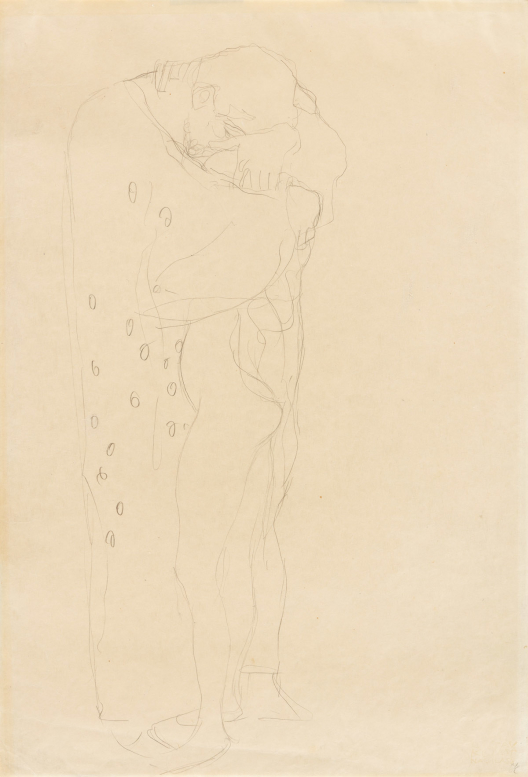

Gustav klimt
Umarmendes Paar.

Pencil on paper, circa 1907-08. 542x371 mm; 21⅜x14⅝ inches. With the artist’s ink estate stamp, bottom right recto.
Marian Bisanz-Prakken, the Albertina, Vienna, will include this work in the supplement to Alice Strobl’s catalogue raisonné of Gustav Klimt’s drawings.
Provenance: Private collection, New York.
Klimt (1862-1918), a leader of the Vienna Secession movement, rejected the academic style that was prevalent in Austria and most of Europe at the turn of the century. His artwork often incorporated undulating contour lines and stylized forms as well as heavy ornamentation and symbolism. This individual expression was lauded by Vienna’s cultural circles in the last decade of the 19th century and the early 1900s and served as a significant influence on Klimt’s younger contemporaries. This drawing relates to Klimt’s most recognized work, The Kiss and another painting, Fulfillment, as he was developing compositions for similar themes at the time.
Estimate
$30,000 – $50,000

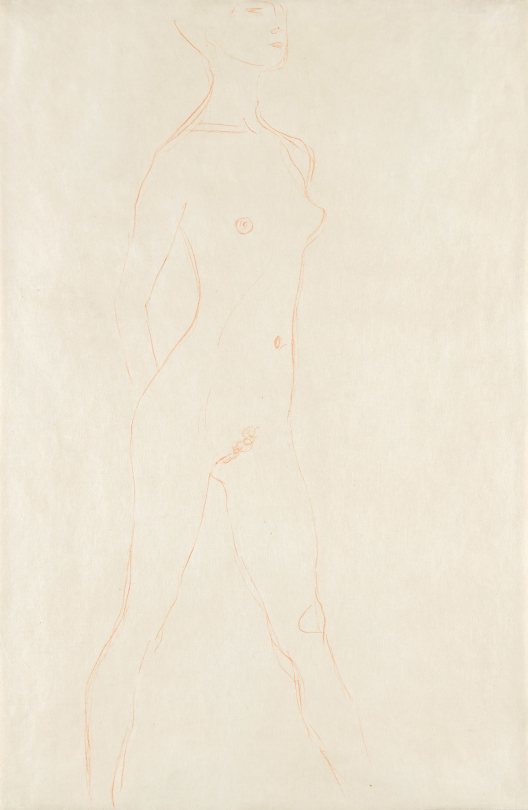

Gustav klimt
Stehender weiblicher Akt, Hände hinter dem Rücken verschränkt.

Reddish orange crayon on cream wove paper, circa 1906. 560x370 mm; 22x14¾ inches. With the artist’s estate ink stamp (Lugt 1575, verso, faded).
Provenance: Serge Sabarsky Gallery, New York; Nielsen Gallery, Boston; private collection, Massachusetts, 1977; private collection, Chicago.
Published: Werner, Gustav Klimt, One Hundred Drawings, New York, 1972, number 42 (illustrated); Strobl, Gustav Klimt: Die Zeichnungen, 1904-1912, Salzburg, 1982, volume II, page 113, number 1542 (illustrated).
In her 1982 catalogue, Strobl calls this work and others of the same subject—striding female nudes—from around the same time period, “Stylized, yet full of life from head to toe.” She notes that while no specific painting by Klimt (1862-1918) has been identified for which this and the other similar drawings are known to be studies, they may relate to the Stoclet Frieze, a series of three mosaics created by Klimt for a 1905-11 commission for the Palais Stoclet in Brussels. The panels depict a swirling Tree of Life, a standing female figure and an embracing couple.
Estimate
$30,000 – $50,000



George grosz
Sitzender weiblicher Akt.

Crayon and watercolor on paper, circa 1914-15. 285x222 mm; 11¼x9 inches. Signed and inscribed “No. 29” in pencil, lower right recto. With the artist’s estate ink stamp annotated in pencil and ink, verso.
Provenance: Artist’s estate; private collection, Chicago.
Estimate
$3,000 – $5,000

Erich wegner
Kleiner Umzeig (Piccolo Transloco).

Gouache, watercolor and black ink on paper, doubled-sided, 1925. 420x343mm; 16½ x 13½in. Signed in ink, lower right recto, and signed twice, dated and titled in pencil, lower center verso.
Provenance: Sold Christies, New York, 1997, sale 8039, lot 661 (as Piccolo Transloco); private collection, New York.
According to Galerie St. Etienne, New York, who have exhibited his work, “Wegner was born in Gnoien, Mecklenburg, and moved to Rostock with his family when he was a youth. There he worked as a scene painter for the theater, until he was recruited into the military in 1918. When he returned from his time in the service, he attended the School of Applied Arts in Hannover and opened his own studio there in 1924. He exhibited works at the Art Association in Hannover in 1927, and, in 1929, he was included in the Neue Sachlichkeit exhibit in Amsterdam. His work was shown infrequently between 1933 and 1945, but at the end of the war Wegner became an instructor at the Vollkshochschule in Hannover. His work appeared in numerous exhibitions throughout Europe over the next few decades. A retrospective exhibition of his work was held at the Art Association in Hannover in 1970.”
Estimate
$5,000 – $8,000

Max pechstein
Group of 4 illustrated letters of Palau scenes.

Each pen and ink on four sheets of paper, 1917. 276x210 mm; 10⅞x8¼ inches (two sheets folded). Each sheet signed and dated in ink. With an original mailing envelope.
Provenance: Horst Karl Lilienfeld, Leipzig; private collection, New York.
After returning from the Western Front of World War I, Pechstein (1881-1955) began work on his “Palau” paintings, inspired by his travels to the South Seas and the former German colony of Palau. These letters with extensive drawings of Palau scenes, were sent to the art historian and gallerist Horst Karl Lilienfeld (1885-1966), who would in 1932 mount Pechstein’s first solo exhibition in the United States, at the Van Diemen-Lilienfeld Galleries, New York.
Estimate
$5,000 – $8,000



Max pechstein
Fischerboote bei Sonnenuntergang.

Watercolor, 1951. 504x660 mm; 19⅞x26 inches. Signed and dated in pencil, lower left recto.
Provenance: Sheldon Ross Gallery, Birmingham, Michigan with the label on the frame back; private collection, Michigan.
Estimate
$15,000 – $20,000



Karl schmidt-rottluff
Stilleben mit Vasen.

Watercolor, gouache and India ink on paper, circa 1960. 403x537 mm; 16x21¼ inches. Signed in ink, lower left recto.
Provenance: Acquired directly from the artist, Berlin, by Martin J. Hillebrand, U.S. Ambassador to the Federal Republic of Germany from 1972 to 1976, in 1974, with photographs of Schmidt-Rottluff meeting with Hillebrand to receive an honorary award and a copy of letter detailing the photographs dated June 19; 1974.
Estimate
$12,000 – $18,000



Moritz melzer
Madonna in der Wolken.

Color monotype on Japan paper, circa 1930. 575x437 mm; 22½x17⅛ inches. Signed in crayon, lower right. A very good impression with strong colors.
Melzer (1877-1966), born in Bohemia, was a member of the Berlin Secession which was founded in 1891 and counted Edvard Munch, Max Beckman, Kathe Kollwitz and Erich Heckel among the membership. Melzer rejected the status quo of government endorsed art rooted in academic tradition. During his career, Melzer helped to found two offshoots of the original Berlin Secession movement, the New Secession and the November Group. Due to his expressionistic style and radicalized views, Melzer’s art was labeled Entartete Kunst, or “degenerate art” by the Nazi Party and was banned from museums in the late 1930s.
Estimate
$2,000 – $3,000

Oskar kokoschka
Apulia.

Portfolio with complete text and 20 lithographs on Japon nacré, 1964. 515x665 mm; 26¼x20¼ inches (sheets), full margins, loose as issued. Each lithograph signed and numbered 13/50 in pencil, lower margin. Printed by J.E. Wolfensberger, Graphicschen Anstalt, Zurich. Published by Marlborough Fine Art, Ltd., London. Original embossed paper folders and linen clamshell portfolio. Very good impressions.
Apulia was created from Kokoschka’s drawings he made while visiting the Italian region in 1963. The artist considered Apulia to be the gateway to Antiquity, reminiscent of Homer’s Odyssey. Wingler/Welz 268-287.
Estimate
$8,000 – $12,000

Renée sintenis
Ausschlagendes Fohlen.

Bronze, 1923. 110x130 mm; 4½x5¼ inches (excluding marble base). Incised with the artist's initials on the outside of the rear right hoof and numbered "19" on the horse's lower underside.
Provenance: Private collection, Chicago.
Published: Buhlmann, Renée Sintenis: Werkmonographie der Skulpturen, Darmstadt, 1987, number 132 (another cast illustrated); Georg Kolbe Museum, Renée Sintenis: Das plastische Werk, Berlin, 2013, number 58 (another cast illustrated).
Estimate
$7,000 – $10,000



Gerhard marcks
Stehender weiblicher Akt.

Pencil on paper. 514x335mm; 20¼x13¼ inches. Signed in pencil, lower right recto.
Provenance: Otto Gerson Gallery, New York; Marlborough-Gerson Gallery, New York, with both labels on the frame back.
Estimate
$1,000 – $1,500



Käthe kollwitz
Brustbild einer Arbeiterfrau mit blauem Tuch.

Color lithograph on cream wove paper, 1903. 350x245 mm; 13¾x9¾ inches, full margins. Third state (of 3). Edition of approximately 100. Signed in pencil, lower right. Published by Der Gesellschaft für Vervielfältigende Kunst, Vienna. A superb, well-inked impression with strong colors. Klipstein 68; Knesebeck 75.
Estimate
$4,000 – $6,000

Käthe kollwitz
Die Klage.

Bronze, 1939-41. 266x248x102 mm; 10½x9¾x4 inches. Inscribed with the artist’s signature and with the foundry mark Cire perdue A.A. Hébrard, Paris, and stamped “H. NOACK BERLIN” on the left edge.
Published: Seeler, Käthe Kollwitz - Die Plastik, 2019, number 38 (another cast illustrated).
Die Klage, or The Lament, was created by Kollwitz (1867-1945) in reaction to Nazi dictatorship, which had ostracized many of her colleagues and family members, including sculptor Ernst Barlach (1870-1938). The sculpture served as a tribute to Barlach and a self-portrait of Kollwitz. Both Barlach and Kollwitz were silenced as artists when their works were confiscated in 1936 by the Nazis, this is symbolized by the hand covering the mouth. The other hand, covering one eye, represents how one could momentarily turn away from the suffering at the hands of the regime, but it was ever present and could not be ignored.
The plaster cast of Die Klage, conceived by Kollwitz from 1939-41, arrived at the Noack Foundry, Berlin, before 1942 when Kollwitz had two zinc casts made. According the Seeler, it is unclear if these casts have survived, as a 1944 letter from Kollwitz indicates that a cast was damaged or destroyed, though Noack created post-war bronzes into the 1980s.
Since Kollwitz’s death, owing to the popularity of the image, there have been numerous castings of Die Klage made by both European and American foundries. Since the dimensions and the survival of the original cast are unclear, it is difficult to ascertain from what source cast many of these editions originate. The Boston art dealer Hyman Swetzoff obtained a plaster cast for Die Klage in 1956 and had a version made at the Roman Bronze Works, New York in 1961-62. Posthumous casts were also likely made from a bronze owned by Hans Kollwitz. Heilborn 89; Guratzsch 59; Seeler 38.
Estimate
$10,000 – $15,000



Käthe kollwitz
Selbstbildnis im Profil nach rechts.

Lithograph on smooth, cream wove paper, circa 1938. 475x290 mm; 18¾x11⅜ inches, full margins. Third state (of 3). Edition of 220. A very good impression.
This is Kollwitz’s (1867-1945) last printed self-portrait, made by the artist on the eve of World War II and following a life that had been ravaged by war. Her son Peter was killed in action as a soldier in World War I. She made only several proofs of this lithograph during her lifetime, before setting it aside during the war; the edition of 220 was printed posthumously in 1947 by her estate. In July 1936, Kollwitz and her husband were visited by the Gestapo, who threatened her with arrest and deportation to a Nazi concentration camp; they resolved to commit suicide if such a prospect became inevitable. She outlived her husband who died from an illness in 1940. She was evacuated from Berlin in 1943. Later that year, her house was bombed and many drawings, prints and documents were lost. Kollwitz died just 16 days before the end of World War II. She had spent decades, since the death of her son, creating haunting works of art that showed the true horrors and cost of war. Nevertheless, in one of her last journal entries before her death, she wrote, “One day, a new ideal will arise, and there will be an end to all wars. I die convinced of this. It will need much hard work, but it will be achieved . . . The important thing, until that happens, is to hold one’s banner high and to struggle.” Klipstein 265; Knesebeck 273.
Estimate
$1,500 – $2,500

Käthe kollwitz
Selbstbildnis.

Bronze, 1926-36 (cast later). 470 mm; 18½ inches (height, including marble base). Incised with the artist’s signature and the foundry mark, H. Noack Berlin, lower verso edge.
Provenance: Private collection, Chicago.
Published: Seeler, Käthe Kollwitz: die Plastik Werkverzeichnis, Munich, 2016, page 103, number 26 (another cast illustrated).
Dr. Annette Seeler, Berlin, editor of the catalogue raisonné of Kollwitz’s sculptures, has confirmed from photographs that this bronze is an authorized posthumous cast.
Estimate
$15,000 – $20,000



Käthe kollwitz
Tod packt eine Frau.

Lithograph, 1934. 507x365 mm; 20x14⅜ inches, full margins. Signed and numbered 59/100 in pencil, lower margin. From Tod. A very good impression. Klipstein 259; Knesebeck 267.
Estimate
$2,500 – $3,000



Käthe kollwitz
Die Witwe II.

Woodcut, 1922. 300x528 mm; 12x21 inches, wide margins. Seventh state (of 7). Signed and numbered 74/100 in pencil, lower margin. Printed by Fritz Voigt, Berlin. Published by Emil Richter, Dresden. From Krieg. A superb, dark impression with strong contrasts. Klipstein 181; Knesebeck 178.
Estimate
$2,500 – $3,500

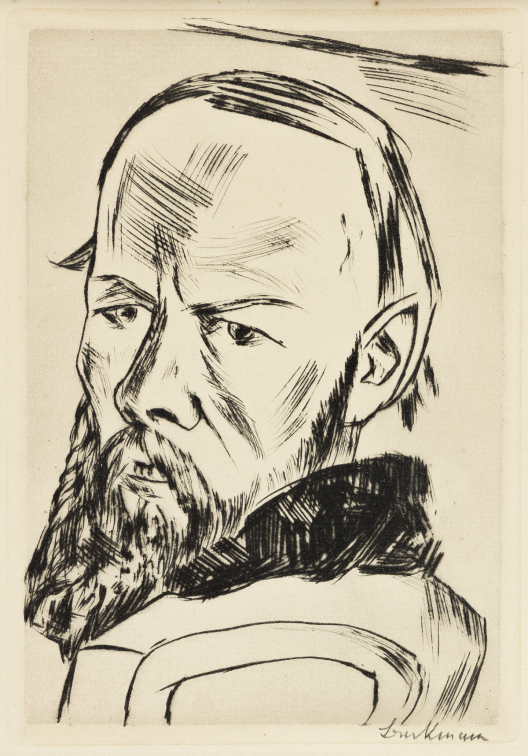

Max beckmann
Dostoyevsky II.

Drypoint, 1921. 170x120 mm; 6⅝x4⅝ inches, full margins. Edition of 215. Signed in pencil, lower right. Printed by Franz Hanfstaengl, Munich. Published by Verlag der Marées Gesellschaft, Munich. A very good impression with richly-inked burr. Hofmaier 187.
Estimate
$1,500 – $2,500



Max beckmann
Selbstbildnis von vorn, im Hintergrund Hausgiebel.

Drypoint on cream wove paper, 1918. 305x256 mm; 12x10⅛ inches, full margins. Second state (of 2). Edition of 100. Signed in pencil, lower right. Published by Verlag R. Piper & Co., Munich. A superb, richly-inked impression of this large, important self-portrait. Hofmaier 125.
Estimate
$7,000 – $10,000



Conrad felixmüller
Arbeiterpaar.

Etching printed in dark reddish brown on cream wove paper, 1920. 285x275 mm; 11¼x11 inches, full margins. Edition of 125. Signed in pencil, lower right. Published by Euphorion Verlag, Berlin. From Die Schaffenden, with the blind stamp lower left. A superb, richly-inked impression. Söhn 220.
Estimate
$2,000 – $3,000



Lyonel feininger
Clouds over Connecticut Hills.

Color crayons on cream wove paper, 1939. 141x229 mm; 5½x9 inches. Signed in ink and dated in crayon, lower right recto.
Provenance: Andreas Feininger, son of the artist; thence to the Estate of Andreas Feininger, New York.
Achim Moeller, Managing Principal of The Lyonel Feininger Project, LLC., New York and Berlin has confirmed the authenticity of this work, which is registered under number 1736-01-05-22.
Estimate
$7,000 – $10,000



Lyonel feininger
Nevada.

Color crayons on cream wove paper, 1936. 141x213 mm; 5½x8⅜ inches. Signed, inscribed and dated in pencil, lower left recto.
Provenance: Andreas Feininger, son of the artist; thence to the Estate of Andreas Feininger, New York.
Achim Moeller, Managing Principal of The Lyonel Feininger Project, LLC., New York and Berlin has confirmed the authenticity of this work, which is registered under number 1735-01-05-22.
Estimate
$8,000 – $12,000

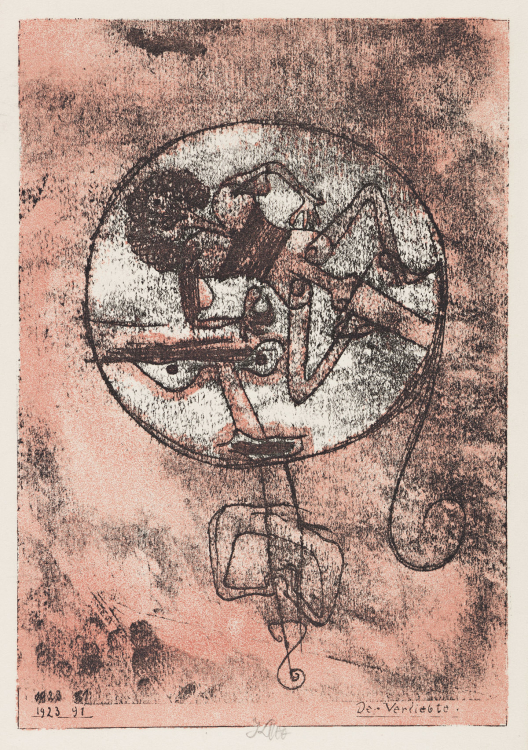

Paul klee
Der Verliebte.

Color lithograph, 1923. 275x192 mm; 10⅞x7½ inches, full margins. Third state (of 3). Edition of 100. Signed in pencil, lower center. Printed and published by Staatliches Bauhaus, Weimar. From Meistermappe des Staatlichen Bauhauses. A superb impression of this scarce lithograph with strong colors.
Provenance: Alfred H. Barr Jr., founding director of the Museum of Modern Art, New York; Renee M. Arb, the art critic and founder of University of Massachusetts Boston’s art department; thence by descent to the current owner, private collection New York.
The present impression of Der Verliebte, or The Lover was a telling gift from Alfred H. Barr, Jr. to the art critic and founder of University of Massachusetts Boston’s art department, Renee M. Arb, with whom he had a close relationship during the 1940s and 1950s. At the time of this gift, Arb had helped launch the career of painter Willem de Kooning, capturing the essence of his artistic trajectory and inducing Barr to begin acquiring the artist’s work for the MoMA. During her career, at ARTnews, Dr. Arb was credited with being the first to acknowledge Willem de Kooning’s work in 1948 in what his wife Elaine de Kooning recalled as a “prophetic” review of the artist’s first solo exhibition in New York. Kornfeld 94.
Estimate
$20,000 – $30,000



Fernand léger
Deux Hommes (Soldats à Verdun).

Pen and ink on paper, circa 1915-16. 280x227 mm; 11x9 inches. Initialed in ink, lower right recto.
Provenance: Sold Christie’s, New York, November 12, 1996, sale 7933, lot 85; private collection, New York.
From 1914 to 1917, Léger (1881-1955) fought on the front-lines during World War I at Argonne and Verdun. Afterwards he reflected on his experience: “I was stunned by the sight of the breech of a 75 millimeter in the sunlight. It was the magic of light on the white metal . . . The crudeness, variety, humor, and downright perfection of certain men around me, their precise sense of utilitarian reality and its application in the midst of the life-and-death drama we were in . . . made me want to paint in slang with all its color and mobility.” The war marked a significant turning-point in Léger’s work; from abstract and cubist works, he transitioned to what became known as his “mechanical period.” Industrial and machine-like objects came to the forefront of his artwork and he noted, “I wanted brightness and intensity, so I used the machine, as others use the nude or the still life.” The current drawing and others like it by Léger in the mid-1910s, shows his shift from Cubism to what the art critic Louis Vauxcelles coined as “Tubism” particularly in his figures and objects such as wagons, machinery and trenches which were common on the front lines in World War I.
Estimate
$5,000 – $8,000



Fernand léger
Fêtes de la faim.

Gouache and watercolor on white wove paper, 1948. 330x245 mm; 12⅞x9¾ inches. Initialed and dated in gouache, lower right recto. Signed and annotated by the publisher Louis Grosclaude, Lausanne, in pencil and with the black ink stamp, verso.
A gouache design for Les Illuminations, 1949 (see Saphire 29). Saphire notes, “Many gouaches on themes found in Les Illuminations were done during and after the work on the book.”
Provenance: Galerie Romanet Rive-Gauche, Paris with the labels on the frame back; private collection, New York.
Estimate
$20,000 – $30,000



Fernand léger (after)
Femme et cheval.

Color screenprint on silk. 690x675 mm; 27AF1/8>x26⅝ inches, full margins. Numbered 183/290 in white ink, lower right. A very good impression.
Estimate
$1,500 – $2,500



Moïse kisling
Jeune femme.

Color aquatint and etching on Chine collé on Japon nacré, circa 1920. 430x342 mm; 17x13½ inches, wide margins. Signed and numbered 24/100 in pencil, lower margin. A very good impression of this scarce print, with strong colors.
Estimate
$1,500 – $2,500



Tsuguharu foujita
Enfant avec des arcs dans les cheveux.

Color etching and roulette on Chine collé on Japan paper, circa 1929. 380x287 mm; 15x11½ inches, full margins. One of 5 numbered hors commerce impressions, aside from the edition of 100. Signed, inscribed “HC” and numbered 4/5 in pencil, lower margin. Published by Éditions Artistiques Apollo, Paris. From Enfants. A very good impression of this extremely scarce print.
Estimate
$4,000 – $6,000



Tsuguharu foujita
Japonaise, de profil.

Pen and ink on paper, circa 1935-40. 253x206 mm; 9¾x8 inches. Signed and annotated in ink, lower left recto.
Provenance: Acquired directly from the artist by private collection, Chicago.
This work will be included in the forthcoming catalogue raisonné of the work of Foujita, now in preparation by Sylvie Buisson, Paris.
Estimate
$5,000 – $8,000



Tsuguharu foujita
La Vierge à l’Enfant avec des anges.

Color lithograph, 1964. 535x390 mm; 21¼x15½ inches, full margins. Signed and numbered 56/150 in pencil, lower margin. A very good impression.
Estimate
$1,500 – $2,500



Raoul dufy
Fluctuat Nec Mergitur (La Seine devant Paris).

Lithograph with hand coloring in watercolor, circa 1935. 289x365 mm; 11⅜x14⅜ inches, full margins. Signed in pencil, lower right. A very good impression of this scarce, early lithograph.
Estimate
$2,000 – $3,000



Raoul dufy
Nice.

Watercolor and ink on paper, circa 1930. 222x280 mm; 8¾x11 inches. Signed in pencil, lower right recto.
Provenance: Private collection, New York.
Estimate
$10,000 – $15,000

Raoul dufy (after)
La Fée Électricité.

Complete set of 10 color lithographs, 1953. 1015x630 mm; 39⅞x24⅞ (sheets), full margins. Numbered 139/350 and signed by the printer Pierre Berès, Paris, in pencil, on the verso of the first lithograph of the series. Printed and published by Mourlot, Paris. Very good impressions of these large lithographs with strong colors.
Estimate
$4,000 – $6,000



Raoul dufy (after)
Hôtel, Piscine, Côte d’Azur.

Color lithograph, circa 1950. 570x753 mm; 22½x29½ inches, full margins. Signed and numbered 25/100 in pencil, lower margin. A very good impression with strong colors.
Estimate
$2,500 – $3,500



Mino delle site
Giuramento dell’atleta.

Color pencils on paper, 1937. 294x407 mm; 11⅝x16 inches. Signed and numbered “XV” lower right recto. With a copy of certificate of authentication from the Archivo Mino Delle Site, Rome with the registration number P.N. 1937-P91.
Delle Site (1914-1996) was an Italian painter from Lecce, a city in Italy’s southern Apulia region. He moved to Rome at age sixteen to study at the Accademia di Belle Arti, where he joined the nascent Aeropittura (Aeropainting) movement, an expression of Italian Futurism focusing on aerial landscapes and airplanes as subject matter.
Estimate
$1,500 – $2,500



Antoni clavé
Plaza de Toros, Sevilla.

Gouache on black wove paper. 421x610 mm; 16½x24 inches. Signed in gouache, lower right recto.
This work is accompanied by its certificate of authenticity issued by the Antoni Clavé Archives.
Provenance: Private collection, New York.
Clavé (1913-2005) was a Catalan master painter, printmaker, sculptor, stage designer and costume designer. Born in Barcelona, he received his formal art training at the School of Fine Arts in Barcelona, later relocating to Paris as a refugee during the Spanish Civil War. Clavé became deeply involved in the avant-garde art scene in Paris where he befriended Pablo Picasso, among other vanguard artists at the time.
Estimate
$5,000 – $8,000



Charles dufresne
Baigneuse sur la Plage.

Oil and ink on cream laid paper, circa 1940. 216x335 mm; 8½x13¼ inches. Signed in ink, lower left recto.
Provenance: Private collection, New York.
Estimate
$1,000 – $1,500



André dunoyer de segonzac
Les Tomates (Nature morte).

Watercolor and ink on paper mounted on card stock. 724x914 mm; 28½x36 inches. Signed in ink, lower right recto.
Provenance: David B. Findlay Galleries, New York, with the label on the frame back; private collection, New York.
Estimate
$5,000 – $8,000



Jean dufy
Bois du Boulogne.

Color lithograph, circa 1950. 480x630 mm; 18¾x24¾ inches, full margins. Signed and numbered 100/225 in pencil, lower margin. A very good impression with strong colors.
Estimate
$1,500 – $2,500



Marcel vertès
Femme assise sur un balcon, vue sur la Seine.

Oil on canvas, circa 1950. 500x650 mm; 19¾x25¾ inches. Signed in oil, upper left recto.
Provenance: Private collection, Chicago.
Vertès (1895-1961) was a French costume designer and illustrator of Hungarian-Jewish origins. He won two Academy Awards (Best Art Direction and Best Costume Design) for his work on the 1952 film Moulin Rouge. Vertès is also responsible for the murals in the Café Carlyle in the Carlyle Hotel, New York, and for those in the Peacock Alley in the Waldorf Astoria Hotel, New York.
Estimate
$1,500 – $2,500



Moura chabor
Scène de Parc Parisien.

Oil on canvas, circa 1950. 660x915 mm; 26x36 inches. Signed in oil, lower left recto.
Provenance: Acquired directly from the artist, private collection, New York.
Chabor (1905-1995) was born and raised in Paris. She studied under the prolific sculptor Antoine Bourdelle (1861-1929) and worked closely with artist Suzanne Valadon (1865-1938). Beginning her career as a glove designer, Chabor later transitioned to painting, creating dazzling scenes of Paris in the mid-20th century. She escaped Nazi persecution during World War II by finding refuge with the Sisters of St. Vincent in Paris. Later in life, Chabor lived in between Paris and New York.
Estimate
$1,500 – $2,500



Marcel janco
A Man Killing a Raging Bull near a Walled Town (Mural Study).

Watercolor, gouache and ink on paper, circa 1945-50. 255x705 mm; 10¼x28 inches. Signed in ink, lower left recto.
Provenance: Private collection, Chicago.
Janco (1895-1984) was a Romanian-born Israeli artist, architect and art theorist. He was the co-inventor of Dadaism and a leading exponent of Constructivism in Eastern Europe. In the 1910s, he co-edited the Romanian art magazine Simbolul, with Ion Vinea and Tristan Tzara. Janco was a practitioner of Art Nouveau, Futurism and Expressionism before contributing his painting and stage design to Tzara’s literary Dadaism. He parted with Dada in 1919 when he and painter, Hans Arp, founded a Constructivist circle, Das Neue Leben. He fled Hungary in January 1941, narrowly escaping the Bucharest Pogrom, and ultimately landed in Tel Aviv, then part of British Palestine. The horrific brutality he witnessed during the Romanian Iron Guard and Nazi takeover of Bucharest informed his work around World War II and shortly thereafter, in particular the gruesome Straulesti Abattoir murders of Romanian Jews, among who was the brother of Constructivist promoter and author Jacques G. Costin, Janco’s brother-in-law. However, later in his career, after settling in Israeli, Janco began painting landscapes in optimistic tones and many bucolic watercolors. Along with his significant contributions to early 20th century avant-garde art movements, he is considered one of the fathers of Israeli modernist art.
Estimate
$1,500 – $2,500



Yves tanguy
Sans Titre (Le Mythe de la Roche Percée).

Etching, 1947. 190x145 mm; 7½x5¾ inches, full margins. Edition of 100. Signed in pencil, lower right. Printed by Atelier 17, New York. Published by Editions Hémisphères, Paris. From Le Mythe de la Roche Percée. A superb, richly-inked impression of this very scarce etching with strong contrasts and crisp, inky plate edges. Wittrock 14 C.
Estimate
$3,000 – $5,000



Friedel dzubas
Untitled.

Oil on canvas, circa 1950. 585x230 mm; 23x9⅛ inches. Signed “Friedelbald” in oil, lower right recto.
Acquired from the artist’s son by the current owner, private collection, New York.
This is an early work by Dzubas (1915-1994), who was born in Germany and fled his native country in 1939 to move to New York. He had no formal artistic training and started his art career in the United States. He shared a studio with Helen Frankenthaler (1928-2011) from 1952-53, and during this time he also started to exhibit his work, including at the famous Ninth Street Show in 1951. At this early time in his career he frequently signed his work “Friedelbald” as this was before he changed his name to Friedel.
Often considered part of the Color Field movement, his work differed from others in the group as he juxtaposed and crossed forms over gesso leaving them saturated—many artists in the movement diluted their colors. He exhibited his work at significant galleries during his lifetime, including Tibor De Nagy, Leo Castelli Gallery and André Emmerich. Numerous prominent museums have exhibited his work during the last several decades and continue to hold his paintings in their permanent collections, such as the Metropolitan Museum of Art and the Museum of Modern Art, New York.
Estimate
$5,000 – $8,000



Joan miró (after)
Mur de la Lune.

Color lithograph, 1958. 235x743 mm; 9¼x29¼ inches, full margins. Signed and numbered 289/300 in pencil, lower margin. Published by Maeght, Paris. A very good impression with strong colors. Maeght 1711.
Estimate
$3,000 – $5,000



Joan miró (after)
Sur Quatre Murs.

Color lithograph, 1951. 260x792 mm; 10¼x31¼ inches, full margins. Edition of 400. Signed and dated in pencil, lower right. Published by Maeght, Paris. A very good impression of this large lithograph, with strong colors.
This lithograph is based on Miró's mural for Harkness Commons at the Harvard University Graduate School, Cambridge, Massachusetts. Maeght 1708.
Estimate
$7,000 – $10,000



Joan miró (after)
Le Chien bleu.

Color aquatint and etching, circa 1960. 617x480 mm; 24<AF3/8>x19 inches, full margins. An hors commerce impression, aside from the edition of 300. Signed and inscribed "H.C." in pencil, lower margin. Printed by Crommelynck, Paris. Published by Maeght, Paris. A superb impression with strong colors. Maeght 1714.
Estimate
$7,000 – $10,000

Joan miró
Bagatelles végétales.

Complete set of 6 color etchings with aquatint on Moulin Richard de Bas Auvergne handmade paper, 1956. 234x370 mm; 9¼x14½ inches (sheets), full margins, loose with centerfolds as issued (lacking complete text). Edition of 33 printed on this paper, from a total edition of 311. Printed by Atelier Lacourière, Paris. Published by Jean Aubier, Paris. Superb, richly-inked impressions with strong colors. Dupin 107-112; Cramer 33.
Estimate
$15,000 – $20,000



Joan miró
Le Lézard aux Plumes d’Or.

Color lithograph on Japon nacré, 1967. 340x490 mm; 13½x29⅜ inches, full margins. Signed and numbered 2/50 in pencil, lower margin. Printed by Mourlot, Paris. Published by Louis Broder, Paris. From the same-titled series. A very good impression of this scarce print. Mourlot 517.
Estimate
$3,000 – $5,000



Joan miró
Fissures.

Color etching and aquatint, 1969. 500x600 mm; 19⅝x23⅝ inches, full margins. Signed and numbered 36/75 in pencil, lower margin. Printed and published by Maeght, Paris. From the same-titled suite. A very good impression. Dupin 477.
Estimate
$2,000 – $3,000



Joan miró
Obra inèdita recent.

Color lithograph, 1968. 305x438 mm; 12x17¼ inches (sheet), full margins. Initialed and numbered 73/100 in pencil, lower margin. Published by Sala Gaspar, Barcelona. From the same-titled suite. A very good impression. Cramer 95.
Estimate
$1,500 – $2,500



Joan miró
Ubu Roi.

Color lithograph, 1966. 410x632 mm; 16¼x25 inches, full margins. Signed and numbered 6/75 in pencil, lower margin. Printed by Mourlot, Paris. Published by Tériade, Paris. From the same-titled portfolio. A very good impression with vibrant colors. Mourlot 474.
Estimate
$5,000 – $8,000



Joan miró
Michel Tapié.

Color lithograph, 1970. 305x248 mm; 12x9¾ inches (sheet), full margins. Signed and numbered 18/60 in pencil, upper recto. Printed by Maeght, Paris. Published by Fratelli Fabbri, Milan. A very good impression with strong colors. Mourlot 687.
Estimate
$2,500 – $3,500



Joan miró
Galathée.

Color etching, aquatint and embossing, 1976. 1155x740 mm; 45½x9⅛ inches, full margins. Signed and numbered 34/50 in pencil, lower margin. Printed by Morsang, Paris. Published by Maeght, Paris, with the watermark. A superb impression of this large print with strong colors. Dupin 931.
Estimate
$25,000 – $35,000

Portfolio
Paroles Peintes V.

Portfolio with complete text and 9 prints, including color etchings and aquatint, 1975. 380x281 mm; 15x11⅛ inches (sheets), full margins, loose as issued.
One of 132 numbered copies. Numbered “83” on the justification page. Printed by LeBlanc and Morsang, Paris. Published by Lazar-Vernet, Paris. Original beige linen portfolio.
Includes prints by MIRÓ (Dupin 827), CHILLIDA, BRYEN, UBAC, BONA, MATTA, LAPATRE, TAPIES and LAM (Tonneau-Ryckelynck 7511). Very good impressions with strong colors.
Estimate
$3,000 – $5,000



Joan miró
Le Marteau sans Maître.

Color aquatint and etching on Japon nacré, 1976. 285x230 mm; 11¼x9 inches, full margins. The deluxe edition of 50 on Japon nacré, aside from the edition of 125. Signed and numbered I/L in pencil, lower margin. Printed by Morsang, Saint Michel sur Orge. Published by Le Vent d’Arles, Paris. A superb impression with fresh colors. Dupin 957.
Estimate
$4,000 – $6,000



Joan miró
Grans Rupestres III.

Color etching, 1979. 920x680 mm; 36¼x26¾ inches, full margins. Signed and numbered 15/30 in pencil, lower margin. Printed by Joan Barbará, Barcelona. Published by Maeght, Barcelona. A superb, richly-inked impression of this scarce print. Dupin 1055.
Estimate
$4,000 – $6,000

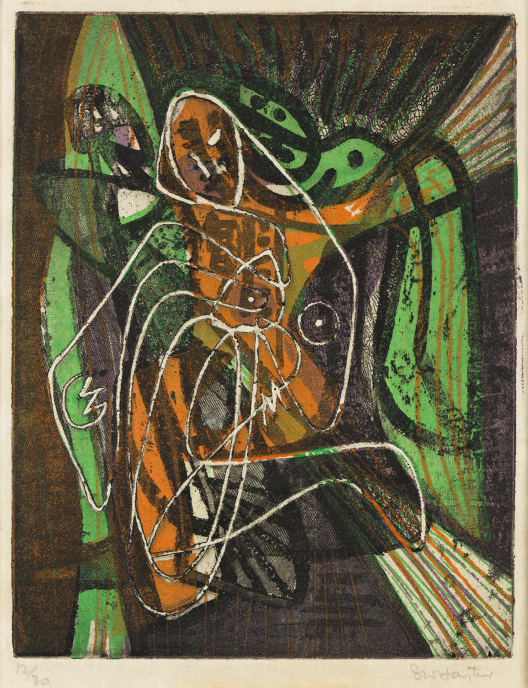

Stanley w. hayter
Palimpsest.

Color sugar-lift, soft-ground etching and screenprint, 1946. 225x175 mm; 9x7 inches, full margins. Second state (of 3). Edition of 30. Signed and numbered 12/30 in pencil, lower margin. A very good impression of this scarce, early print. Black/Moorhead 170.
Estimate
$1,000 – $1,500



Stanley w. hayter
Night Moth.

Color etching and aquatint, 1946. 150x113 mm; 5¾x4½ inches, full margins. Third state (of 3). Signed and numbered 234/300 in pencil, lower margin. Published by Laurel Gallery, New York. From Laurels Number One. A very good impression with strong colors. Black/Moorhead 171.
Estimate
$1,000 – $1,500



Stanley w. hayter
Personnage virtuelle.

Engraving, soft-ground etching and scorper, 1947. 298x228 mm; 11¾x9 inches, full margins. Signed, dated and numbered 67/70 in pencil, lower margin. Printed by the artist at Atelier 17, New York. Published by Brunidor Editions, New York. From Brunidor Portfolio Number One. A superb, dark and richly-inked impression of this scarce engraving. Black/Moorhead 182.
Estimate
$1,200 – $1,800



Stanley w. hayter
Jeux d’eau.

Color engraving and soft-ground etching, 1953. 397x328 mm; 15¾x13 inches, wide margins. Signed, titled, dated and numbered 122/200 in pencil, lower margin. Printed at Atelier 17, Paris. Published by L’Œuvre Gravée, Zurich. A very good impression.
Black/Moorhead indicate that the color combinations used for this print vary between the lower and higher numbers in the edition (as well as the various proofs), therefore the actual edition size based on these variations is likely smaller than the overall 200 published impressions. Black/Moorhead 208.
Estimate
$1,500 – $2,500



Stanley w. hayter
Warriors.

Color engraving, soft-ground etching and scorper, 1953. 478x335 mm; 18¾x13¼ inches, full margins. Signed, dated, titled and numbered 151/200 in pencil, lower margin. Printed by the artist and Atelier 17, New York. Published by George Braziller, New York. A very good impression with strong colors. Black/Moorhead 211.
Estimate
$1,000 – $1,500



Raymond veysset
Composition abstraite.

Color linoleum cut, circa 1950. 335x253 mm; 13⅛x10 inches, full margins. Signed in ink, lower left, and numbered 5/25 in pencil, lower right. A very good impression of this scarce print with strong colors.
Veysset (1913-1967) studied at the École nationale supérieure des Beaux-Arts de Paris and began as a sculptor in the academic style before turning to Expressionism and ultimately abstraction by the late 1940s. In 1949, he participated in the Salon de la jeune sculpture at the Musée Rodin, Paris. During the mid-20th century, he exhibited in the popular Salon des Réalités Nouvelles at the Musée d’Art Moderne de la Ville de Paris, along with Jean Arp and Sonia Delaunay. Veysset became one of the main proponents of mid-century “Archi-Sculpture” and a leading French abstract sculptor. In 1953, he was selected to contribute to the Mémorial des Martyrs de la Déportation, Paris, in collaboration with the architect Georges-Henri Pingusson, a memorial to the 200,000 people who were deported from Vichy France to the Nazi concentration camps during World War II. However, Veysset pulled out of the project (inaugurated by Charles de Gaulle in 1962) in 1957 due to his contention with its significant modification.
Estimate
$1,000 – $1,500



Jean xceron
Ironstones.

Watercolor and ink on paper, 1960. 254x203 mm; 10x8 inches. Signed and dated in ink, lower right recto.
Provenance: Camillos Kouros Gallery, New York, with the label on the frame back; private collection, New York.
Xceron (1890-1967) emigrated from Greece to the United States when he was fourteen years old. He studied drawing at the Corcoran School of Art in Washington D.C. where he perfected his skills as a draftsman. However, after encounters with European modernism Xceron became fascinated with flat color, expressive distortion, and cubist renderings. He moved to New York in 1920, exhibiting in the New York Independents’ exhibitions in 1921 and 1922, and spent many years in Paris in the late 20’s and early 30’s. His work underwent many stylistic changes throughout his life, though he is best-known for his dynamic compositions of geometric forms and vibrant colors. Xceron was also an active art critic, writing articles for the Boston Evening Transcript and the Paris edition of the Chicago Tribune.
Estimate
$1,000 – $1,500

Max ernst
Histoire naturelle.

Portfolio with complete text and 34 collotypes after frottage, 1926. 430x265 mm; 16⅞x10¼ inches, full margins, loose as issued. Edition of 250. Signed and numbered 89 in ink on the justification page. Published by Galerie Jeanne Bucher, Paris. Original pasteboard folder. Very good impressions.
According to the Museum of Modern Art, New York, Ernst (1891-1976) created these images by placing paper atop various materials—wood floorboards, lengths of twine, leaves, wire mesh, crumpled paper, crusts of bread—and rubbing the surface with a pencil or crayon. Inspired by the resulting textures, he added details to transform them into fantastical landscapes, objects, and creatures. Ernst called his process frottage (French for “rubbing”) and claimed it as a form of Surrealist automatism, whereby an artist attempts to let the unconscious guide his hand in the creation of an image.
Estimate
$1,500 – $2,500



Max ernst
Hibou.

Color lithograph, 1955. 492x362 mm; 19½x14¼ inches, full margins. Signed and numbered 160/220 in pencil, lower margin. Printed by Desjobert, Paris. Published by Guilde de la Gravure, Geneva and Paris. A superb impression of this scarce lithograph with vibrant colors. Spies/Leppien 64.
Estimate
$3,000 – $5,000

Max ernst
Elfo 3º.

Yellow and green molded glass gather, 1966. 160 mm; 6½ inches (diameter, irregular edges). Artist’s incised signature, titled, date and numbered 20/300, verso. Published by Fucina degli Angei, Venice.
Estimate
$2,500 – $3,500

Salvador dalí
La Divine Comédie by Dante Alighieri.

Portfolio in 6 volumes with complete text and 100 color woodcuts, 1959-63. 340x270 mm; 13⅜x10⅝ inches (sheets), full margins, loose as issued.
One of 3900 numbered copies, from a total edition of 4765. Numbered “3459” on the justification page. Published by Jean Estrade, Paris.
Original decorated paste board folders and slipcases. Michler/Löpsinger 1039-1138; Field pages 189-200.
Estimate
$4,000 – $6,000

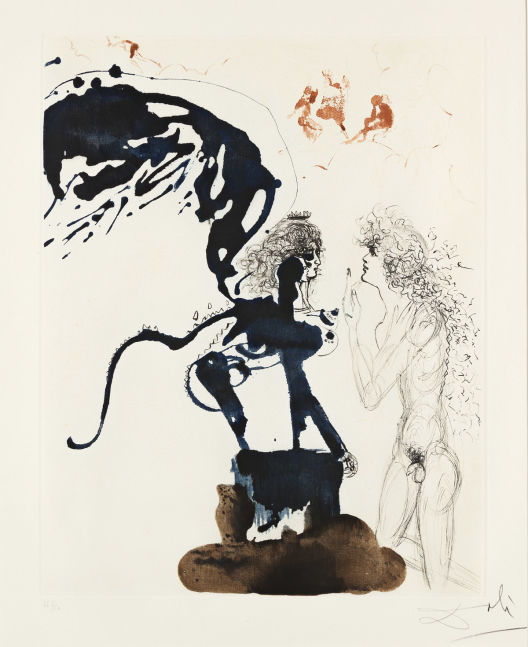

Salvador dalí
Oedipe et le Sphinx.

Color etching, engraving and aquatint, 1960-64. 495x390 mm; 19½x15½ inches, full margins. Signed and numbered 66/150 in pencil, lower right. Published by Argillet, Paris. From Mythologie. A very good impression. Michler/Löpsinger 120; Field 63-3 J.
Estimate
$1,500 – $2,500



Salvador dalí
Saturn.

Color etching and aquatint, 1960-64. 605x490 mm; 23⅞x19¼ inches, full margins. Signed and numbered 61/150 in pencil, lower margin. Published by Pierre Argillet, Paris. From Mythologie. A very good impression. Michler/Löpsinger 126; Field 63-3 N.
Estimate
$1,500 – $2,500



Salvador dalí
The Reality of a Dream.

Pen and dark brown ink on cream wove paper, 1960. 349x458 mm; 13¾x18 inches. Signed and dated in ink, lower right recto, and counter signed in blue ink, verso.
With an authentication by Albert Field, New York, dated May 8, 1998; and a photograph authentication signed by Salvador Dali.
Dalí (1904-1989), known for his significant contributions to the Surrealist movement, frequently employed motifs such as soft figures, ants and desolate landscapes to visualize the unconscious mind. The current work exemplifies Dalí’s grotesque yet meticulous artistic style, which developed during the political tumult and Spanish Civil War of the 1930s and 1940s and which he maintained over the course of his career.
This ink drawing recalls his 1940 oil painting Daddy Longlegs of the Evening—Hope!, now in the Salvador Dalí Museum, St. Petersburg, Florida, which includes a similar horse and winged Nike/Victory of Samothrace motifs.
Estimate
$30,000 – $50,000



Salvador dalí
Don Quichotte (Horseman).

Etching printed in dark reddish brown, 1964-75. 390x295 mm; 15½x11¾ inches, full margins. Artist’s proof, aside from the edition of 200. Signed and inscribed “EA” in pencil, lower margin. Printed by Emiliano Sorini, New York. Published by Levine and Levine, New York. A very good impression.
According to Field, this is the second plate produced of this subject, based on an earlier etching of the same subject from 1964. Field notes that, “An edition of unknown size was printed by Sorini, of which Dalí (1904-1989) signed 200 numbered prints.” Michler/Löpsinger 99; Field 64-4 and page 237.
Estimate
$1,500 – $2,500



Salvador dalí
Nu à l’Escargot.

Color drypoint on Japon nacré, 1967. 320x242 mm; 12¾x9½ inches, full margins. Signed, dated and numbered 13/50 in pencil, lower margin. With the embossed artist’s signature, lower right. Published by Éditions Argillet, Paris. From Poèmes Secrets by Guillaume Apollinaire. A superb, richly-inked impression. Michler/Löpsinger 195; Field 67-10 G.
Estimate
$2,000 – $3,000



Salvador dalí
L’Unicorne laser désintégre les cornes de rhinoceros cosmique.

Color engraving and lithograph, 1974. 755x560 mm; 29¾x22 inches, full margins. Signed and numbered 96/195 in pencil, lower margin. Published by Jean Lavigne, Paris. From La Conquête du Cosmos. A very good impression of this large work. Michler/Löpsinger 646; Field 74-12 H.
Estimate
$1,500 – $2,500



Salvador dalí
Dalínian Prophecy.

Drypoint with color pochoir, 1975-76. 406x590 mm; 16x23¼ inches, full margins. Signed and numbered 122/250 in pencil, lower margin. Printed by Atelier Rigal, Paris. Published by Merrill Chase, Chicago. From Imaginations and Objects of the Future. A very good impression. Michler/Löpsinger 832; Field 75-13.
Estimate
$2,000 – $3,000



Salvador dalí
The Lance of Chivalry.

Color lithograph, 1978. 590x435 mm; 23x17 inches, full margins. The Graphis Verlag edition of 125. Signed and numbered “G 42/125” in pencil, lower margin. Published by Graphis Verlag, Zurich. A very good impression. Michler/Löpsinger 1555; Field 78-10 A.
Estimate
$2,500 – $3,500



Salvador dalí
Don Quichotte.

Color drypoint on Japon nacré, 1971. 520x398 mm; 20½x15¾ inches, full margins. Signed and numbered IV/XXV in pencil, lower margin. Printed by Ateliers Rigal, Fontenay-aux-Roses. Published by De Fracony, Paris. A very good impression. Michler/Löpsinger 451; Field 71-7 A.
Estimate
$2,500 – $3,500

Salvador dalí
Woman with a Head of Roses.

Bronze and plastic illuminated with light bulbs and electrical plug, 1981. 828x520x336 mm; 32⅝x20½x13¼ inches (including base). Signed back of shoulder, and numbered 19/99 below proper left foot. Cast by Bonvicini Foundry, Verona. Published by Galerie Art 204, Paris. Descharnes 684.
Provenance: The publisher, William Gelender, Paris; thence by descent to current owner, private collection, New York.
This sculpture was inspired by Dalí’s same-titled oil of 1935. Descharnes notes that this sculpture was produced in three sizes: the small size with an edition of 350, the medium with an edition of 99, and the large (in two patinas) with an edition 12.
Estimate
$3,000 – $5,000



René magritte (after)
Le Fils de l’Homme.

Color lithograph, 1973. 777x595 mm; 30 5/8 x23½ inches, full margins. Signed, titled, annotated and numbered 110/150 by Georgette Magritte, the artist's wife, in pencil, lower right. Printed by Mourlot, Paris, with the blind stamp lower right. A very good impression of this large lithograph with strong colors.
Based on Magritte's (1898-1967) same-titled oil painting from 1964 now in a private collection. Le Fils de l'Homme (or The Son of Man) was painted by Magritte as a self-portrait. Among his most famous paintings, the subject was used in this collaborative lithograph between the artist's estate, under the direction of the artist's widow Georgette Magritte, and the renowned Parisian lithographer Fernand Mourlot.
The green apple which alludes to the painting's title, a Biblical reference to Adam, and figures so prominently in the image, floating in front of the man's face, was a repeated motif in Magritte's work. It was also used in his 1966 oil painting Le Jeu De Morre, owned by musician Paul McCartney, which purportedly inspired the Beatles to name their record company "Apple Corps," and then in turn prompted Steve Jobs to designate his company "Apple Computer."
Estimate
$5,000 – $8,000



René magritte
Le Prêtre Marié.

Color etching, 1969. 94x140 mm; 3¾x5½ inches, full margins. An hors commerce impression, aside from the edition of 150. With the artist’s signature ink stamp, lower right, and inscribed “H.C.” in pencil, lower left. Printed and published by Georges Visat, Paris. From Le Lien de Paille. A very good impression with strong colors. Kaplan/Baum 13.
Estimate
$2,000 – $3,000



René magritte
Les Moyens d’Existence.

Color etching, 1969. 142x110 mm; 5¾x4½ inches, full margins. With the artist’s signature ink stamp and numbered 80/150 in pencil, lower margin. Printed and published by Georges Visat, Paris. From Le Lien de Paille. A very good impression with strong colors. Kaplan/Baum 20.
Estimate
$3,000 – $5,000

René magritte (after)
Two color lithographs.

Corde Sensible. 430x563 mm; 17x22¼ inches, full margins. Numbered 185/200 in pencil, lower left * Trois Pommes, circa 1968. 450x550 mm; 17¾x21¾ inches, full margins. Artist's proof, aside from the edition of 150. Inscribed "Épreuve d'artiste" in pencil, lower right. Both signed by the artist's wife, Georgette Magritte, in pencil, lower left. Both very good impressions with strong colors.
Estimate
$2,000 – $3,000



René magritte
Le Chant de la Violette.

Color lithograph, 1979. 736x521 mm; 29x20½ inches, full margins. Signed by the artist's widow, Georgette Magritte, and numbered 193/300 in pencil, lower left. With the artist's signature ink stamp, lower right. A very good impression with strong colors.
Based on Magritte's (1898-1967) same-titled oil painting from 1950-51.
Estimate
$1,500 – $2,500

Jean dubuffet
Mur et voyageurs * Mur et avis.

Two lithographs, 1945. Both 380x285 mm; 15x11½ inches (sheets), full margins. Both an edition of 150. Printed by Mourlot, Paris. Published by Les Éditions du Livre, Paris. From Les Murs. Very good impressions of these scarce, early lithographs. Webel 63 and 66.
Estimate
$2,000 – $3,000



Jean dubuffet
Paysage.

Lithograph, 1944. 275x215 mm; 11x8½ inches, full margins. The deluxe edition of only 10 impressions hand-signed by the artist. Signed and numbered 10/10 in pencil, lower right. Printed and published by Mourlot, Paris. From Matière et Mémoire, ou les Lithographes à l’École. A superb, richly-inked impression of this extremely scarce, early lithograph. Webel 29.
Estimate
$5,000 – $8,000



Marc chagall
L’Auge II.

Lithograph, 1924. 305x240 mm; 12x9½ inches, full margins. Signed and numbered 41/100 in pencil, lower margin. Published by Jeanne Bucher, Paris. A very good impression of this scarce, early lithograph. Mourlot 25.
Estimate
$2,000 – $3,000



Marc chagall
Selbstbildnis mit lachendem Gesicht.

Etching and drypoint, 1924-25. 275x215 mm; 10¾x8½ inches, full margins. Third state (of 3). Signed and numbered 92/100 in pencil, lower margin. Printed by Louis Fort, Paris. A very good impression of this scarce, early etching.
Chagall (1887-1985) was born in present-day Belarus, then part of the Russian Empire, to a devoutly Jewish family. He learned to draw in primary school and from a local artist before continuing his studies in St. Petersburg. In 1910, having found a patron to support him, Chagall moved to Paris and settled within the bohemian avant-garde community of painters and poets in Montparnasse. Under the influence of the Expressionist and Cubist artists, in addition to the Fauves and Impressionists he viewed in the Paris museums, Chagall was encouraged to explore his nontraditional style.
During the 1910s, Chagall’s palette grew more colorful and saturated and he became known for his figurative elements in arbitrary, dreamlike compositions inspired by Russian or Yiddish folklore and culture. Chagall held his first solo exhibition in Berlin in 1914 and continued to paint through World War I. After migrating between Russia and Berlin, Chagall and his family again settled in Paris, where he learned engraving. Ambroise Vollard commissioned him to create a series of etchings in 1923 and after the initial project, Chagall returned to printmaking throughout his long and prolific career. Kornfeld 42.
Estimate
$6,000 – $9,000



Marc chagall
Joseph berger.

Etching with hand-coloring in watercolor, 1931-39. 298x235 mm; 11¾x9¼ inches, full margins. Initialed and numbered 49/100 in pencil, lower margin. Printed by Haasen, Paris. The project initiated by Vollard and published by Tériade, Paris. From Bible. A very good impression. Vollard 215.
Estimate
$3,000 – $5,000

Portfolio
Paroles Peintes I.

Portfolio with complete text and 14 prints, including color etching, drypoint, aquatint and lithograph, 1962. 377x278 mm; 14⅞x11 inches (sheets), full margins, loose as issued.
One of 150 numbered copies, from a total edition of 200. Printed number “41” on the justification page. Printed by Lacourière et Robbe, Paris. Published by O. Lazar-Vernet, Paris.
Original beige linen portfolio and slipcase. Includes prints by CHAGALL (Kornfeld 121); MAGNELLI; ZADKINE; GILIOLI, UBAC, BISSIÈRE; JACOBSEN; FIORINI; ERNST (Spies/Leppien 85); BONA; BRAQUE (Vallier 183); DUFOUR; LEPATRE and VIEILLARD.
Estimate
$3,000 – $5,000



Marc chagall
Tête de Chapitre.

Color lithograph, 1964. 500x423 mm; 19¾x16¾ inches, full margins. Signed and numbered 13/50 in pencil, lower margin. Printed by Mourlot, Paris. Published by A.C. Mazo, Paris. From Douze Maquettes de Vitraux pour Jérusalem. A very good impression with fresh colors. Mourlot 407.
Estimate
$2,500 – $3,500



Marc chagall
Jerusalem Windows: The Tribe of Issachar.

Color lithograph, 1964. 625x460 mm; 24¾x18¼ inches, full margins. Signed and numbered XI/LXXV in pencil, lower margin. Lithographed by Charles Sorlier, Paris. Published by Mourlot, Paris. From Twelve Maquettes of Stained Glass Windows for Jerusalem. A very good impression with strong colors. Mourlot CS 17.
Estimate
$6,000 – $9,000

Marc chagall
Lithographs I-IV.

Set of four bound volumes (of 6) with 25 original lithographs, many printed in colors, numerous illustrations and complete text (English), 1960-1974. 320x242 mm; 12⅝x9⅝ inches (sheets), bound as issued. Lithographs printed by Mourlot, Paris. Published by André Sauret, Monte-Carlo and Paris. Original printed and mylar dust jackets. Very good impressions with strong colors. Mourlot 281-292, 392-402, 578 and 730.
Estimate
$2,000 – $3,000



Marc chagall
A la femme, qu’est-il rest?

Color lithograph, 1967. 460x385 mm; 18 ¼x15¼ inches, full margins. Artist’s proof, aside from the edition of 75. Printed by Mourlot, Paris. Published by A.C. Mazo, Paris. From Sur la Terre des Dieux. A very good impression with strong colors.
Provenance: Galerie R. G. Michel, Paris. Mourlot 536.
Estimate
$2,500 – $3,500



Marc chagall (after)
Romeo and Juliet.

Color lithograph, 1964. 635x990 mm; 25x39 inches, full margins. Edition of 5000. Signed in black crayon, lower left. Printed by Mourlot, Paris. Published by the French Tourist Bureau, Paris. A very good impression with strong colors. Sorlier 96.
Estimate
$5,000 – $8,000



Marc chagall (after)
Carmen.

Color lithograph, 1966. 1005x650 mm; 39x25<AF3/8> inches (sheet), full margins. Edition of 3000. Printed by Mourlot, Paris. Published by Editions of the Metropolitan Opera, New York. A very good impression with strong colors. Sorlier 39.
Estimate
$1,500 – $2,500



Marc chagall (after)
The Magic Flute.

Color lithograph, 1967. 1010x660 mm; 39¾x25¾ inches (sheet), full margins. Edition of 3000. Printed by Mourlot, Paris. Published by Editions of the Metropolitan Opera, New York. A superb impression with vibrant colors. Sorlier 38.
Estimate
$1,500 – $2,500



Marc chagall
Auto-Portrait, Fond ocre.

Color lithograph printed in black and ochre, 1970. 310x210 mm; 12¼x8½ inches, full margins. Signed and numbered 24/50 in pencil, lower margin. A very good impression of this scarce lithograph. Mourlot 619.
Estimate
$3,000 – $5,000

Marc chagall
La Féerie et Le Royaume.

Portfolio with complete text and 10 color lithographs, 1972. 300x220 mm; 11¾x8¾ inches (sheets), full margins, loose as issued.
One of 180 numbered copies, from a total edition of 205. Signed by the artist and author in pencil and numbered 178 on the justification page. Printed and published by Mourlot, Paris. Original beige linen portfolio. Very good impressions with fresh colors. Mourlot 668-677.
Estimate
$8,000 – $12,000



Emmanuel mané-katz
Klezmer Band.

Oil on canvas. 730x600 mm; 28¾x23¾ inches. Signed in oil, upper left recto.
Provenance: Private collection, New York.
Mané-Katz (1894-1962) was a Litvak painter born in Kremenchuk, Ukraine. He moved to Paris in 1913 where he befriended fellow artists including Chaïm Soutine and Pablo Picasso, and studied at the École des Beaux-Arts. He first traveled to Jerusalem in 1928, and while he moved often, he considered Israel his sacred home and died in Tel Aviv.
Jewish shtetl life was a common theme in his work. Mané-Katz often portrayed scenes of musicians, such as this Klezmer band scene, which depicts a typical performance in Eastern European villages before World War II and the Holocaust. Throughout his oeuvre Mané-Katz captured the richness and vibrance of Eastern European Jewish culture.
Estimate
$10,000 – $15,000



Alberto giacometti
Les deux tabourets.

Etching, 1954. 263x207 mm; 10¼x8¼ inches, full margins. Signed and numbered 47/50 in pencil, lower margin (Lust calls for an edition of 30, though signed and numbered impressions that have been offered at auction have been an edition of 50). Published by Maeght, Paris. A very good, dark and well-inked impression of this scarce, early etching, with strong contrasts. Lust 58.
Estimate
$3,000 – $5,000



Alberto giacometti
Chaise et suspension.

Lithograph, 1965. 650x500 mm; 25⅝x19⅝ inches (sheet), full margins. Signed and numbered 38/75 in pencil, lower margin. Published by Maeght, Paris. A very good impression. Lust 359.
Estimate
$3,000 – $5,000



Massimo campigli
Donna al Balcone.

Color lithograph, 1956. 595x390 mm; 23⅜x15⅜ inches, full margins. Signed and numbered 102/175 in pencil, lower margin. Printed by Desjobert, Paris. Published by L’Œuvre Gravée, Paris, with the blind stamp lower left. Meloni/Tavola 161.
Estimate
$1,000 – $1,500



Massimo campigli
Passeggiata Romana.

Color lithograph, 1955. 445x580 mm; 17½x22¾ inches, full margins. Artist’s proof, aside from the edition of 175. Signed, dated and inscribed “Epreuve d’artiste” in pencil, lower margin. Printed by Desjobert, Paris. Published by L’Œuvre Gravée, Paris. A very good impression with strong colors. Meloni/Tavola 157.
Estimate
$1,500 – $2,500



Massimo campigli
Donne Fiori.

Color lithograph, 1957. 575x392 mm; 22¾x15½ inches, full margins. Signed, dated and numbered 10/175 in pencil, lower margin. Published by L’Œuvre Gravée, Paris, with the blind stamp lower left. A very good impression. Meloni/Tavola 164.
Estimate
$1,000 – $1,500



Fausto pirandello
Gruppo di Figure Femminile.

Color pastels on tan wove paper, 1954. 240x178 mm; 9½x7 inches. Signed in pencil, lower left recto.
Provenance: World House Galleries, New York, with the label on the frame back; private collection, New York.
Pirandello (1899-1975) was an Italian painter belonging to the modern movement of the Scuola Romana (Roman School). He was the son of Nobel laureate Luigi Pirandello. After a short experience in Paris, where he met the central artistic personalities of the time between 1920 and 1930, Pirandello entered the movement of Scuola Romana, distinguishing himself for originality and solitary exploration. His painting tends towards a quotidian realism manifested at times in the more unpleasant and pitiless aspects of life, expressed through a dense and thorny pictorial matter.
Estimate
$1,500 – $2,500



Giovanni bartolomucci
Skyline (New York).

Oil on canvas, 1960. 765x890 mm; 30¼x35¼ inches. Signed and dated in oil, lower left recto; titled and annotated in ink on the stretcher verso.
Provenance: Private collection, New York.
Bartolomucci (1923-1996) was an Italian painter from Abruzzo in southern Italy. After studying art in and around his hometown of Barisciano, he moved to Rome, by way of Rimini, settling there around 1950 and during the mid-1950s became one of the founders of Astralism. In 1960, Bartolomucci moved to New York where he remained for two years and worked from a studio at Carnegie Hall. He painted an imagined scene of the first moon landing during his time in New York, preceding the actual event by nearly ten years, which was exhibited in Washington, D.C., reproduced in American newspapers and acquired by the John F. Kennedy presidential collection. Bartolomucci also became deeply influenced by Abstract Expressionism during his sojourn in New York; the style stuck with him throughout the rest of his career (he returned to Rome in 1963 and worked there until his death in 1996) albeit combined with a figural and representational edge.
Estimate
$2,000 – $3,000



Le corbusier
Petite Confidences.

Portfolio with complete text and 10 lithographs, 1957. 570x460 mm; 22 ½x18 inches (sheets), full margins, loose as issued.
One of 125 numbered copies. Signed and numbered 67 in pencil, on the title page verso. Printed and published by Mourlot, Paris. Original red linen portfolio. Very good impressions. Weber 44-47.
Estimate
$3,000 – $5,000

Le corbusier
1920: Premiers tableaux.

Lithograph, 1957-60. 425x520 mm; 16¾x20½ inches, full margins. An artist’s proof, aside from the published edition of 125 with inverted inks. Signed and inscribed “epreuve d’artiste” in pencil, lower margin. Printed and published by Mourlot, Paris. From Petite ‘Confidences’. A very good impression.
Swiss art patron Heidi Weber, originally encouraged Le Corbusier (1887-1965) to explore printmaking. The artist started to work with the printer Fernand Mourlot in the spring of 1960. During his work on Petite ‘Confidences’, Le Corbusier invented a new printmaking technique which he called Rhodoid. He etched lines on top of thick acetate film covered in ink to prepare it to be printed. Weber 47.
Estimate
$2,000 – $3,000



Giorgio morandi
Natura morta con cinque oggetti.

Etching on cream wove paper, 1956. 140x195 mm; 5½x7⅞ inches, full margins. Third state (of 4). Signed and numbered 56/150 in pencil, lower margin. A superb, richly-inked impression of this scarce etching.
The primary focus of Morandi’s (1890-1964) œuvre is simple, muted still lives. He taught himself the basics of printmaking in the early 1910s after admiring the work of Old Masters such as Rembrandt van Rijn (1606-1669) and Francisco José de Goya (1746-1828). His etchings reflect his unique practice of hatching and cross-hatching to build form and volume, avoiding descriptive outlines. This, paired with the areas of bianco assoluto, or “absolute white,” that he left in his etchings, created atmospheric, contemporaneous still lives. He taught etching at the Accademia di Belle Arti, Bologna from 1930-56, and in his lifetime, he completed some 1350 oil paintings and 133 etchings. Vitali 116.
Estimate
$40,000 – $60,000

Jacob epstein
Nude Study “A” (Betty Peters).

Bronze, 1943-45. 740 mm; 29 inches (length).
Provenance: Stephen Maegin, Pennsylvania; private collection, Chicago.
Published: Silber, The Sculpture of Epstein, Oxford, 1986, page 193, number 341 (another cast illustrated).
This bronze nude is a study by Epstein (1880-1959) of one of his favorite models from the 1930s and 1940s, Betty Peters, who managed a hostel for sailors in London’s East End. She is represented by Epstein in numerous bronze and plaster sculptures as well as drawings and watercolors.
Estimate
$6,000 – $9,000



Henri laurens
Femme couché.

Color lithograph, circa 1950. 260x500mm; 10¼x19¾ inches, full margins. Signed and numbered 5/75 in pencil, lower margin. A very good impression. Völker 29.
Estimate
$1,000 – $1,500



Marino marini
Cavallo in armonia.

Color aquatint and etching, 1978. 493x670 mm; 19½x26½ inches, full margins. Signed and numbered 67/125 in pencil, lower margin. Printed and published by Grafica dei Greci, Rome. A superb, richly-inked impression with vibrant colors. Guastalla 219.
Estimate
$1,500 – $2,500



Marino marini
Chevaux et Cavaliers IV.

Color lithograph, 1972. 385x495 mm; 15¼x19½ inches, full margins. Signed and numbered 38/50 in pencil, lower right. Printed by Mourlot, Paris. Published by XXe Siècle, Paris. A very good impression with strong colors. Guastalla 107.
Estimate
$1,500 – $2,500



Gino severini
Composition.

Color lithograph, 1955. 490x320 mm; 19¼x12⅝ inches, full margins. Signed and numbered 174/220 in pencil, lower margin. Published by La Guilde de Gravure, Paris, with the blind stamp lower left. A superb impression with vibrant colors.
In 1910, at the invitation of Filippo Tommaso Marinetti and Umberto Boccioni, Severini (1883-1966) signed the Manifesto tecnico della pittura futurista, cementing his role in the Italian Futurist movement. Living in Paris, he became an important link between France and Italy for the Futurists, and organized the first Futurist exhibition outside of Italy at Galerie Bernheim-Jeune, Paris in 1912. Aiming to depict the dynamism of modern life, many artists in the movement depicted burgeoning technology such as cars or machines. Severini, on the other hand, leaned towards depicting the human figure in movement (often in dance). After World War I, Severini moved on from Futurism, embracing Synthetic Cubism, and later, a Neoclassical style. Meloni 28.
Estimate
$3,000 – $5,000



Gino severini
Nature Morte.

Color lithograph, 1958. 392x565 mm; 15½x22⅜ inches, full margins. Signed and numbered 119/140 in pencil, lower margin. Printed by Michael Cassé, Paris. Published by L’Œuvre Gravée, Paris and Zurich. A very good impression with strong colors. Meloni 33.
Estimate
$2,500 – $3,500



Gino severini
Les Musiciens.

Color lithograph, 1955. 563x395 mm; 22¼x15¾ inches, full margins. Signed and numbered 59/175 in pencil, lower margin. Printed by Michel Cassé, Paris. Published by L’Œuvre Gravée, Paris. A very good impression with strong colors. Meloni 30.
Estimate
$2,000 – $3,000



Gino severini
Commedia dell’Arte.

Color lithograph, 1958. 655x507 mm; 25¾x20 inches, full margins. Signed and numbered 92/175 in pencil, lower margin. Published by L’Œuvre Gravée, Paris, with the blind stamp lower left. A very good impression with strong colors. Meloni 34.
Estimate
$1,500 – $2,500



Claude venard
Pont Vénitien.

Oil on canvas, circa 1960. 750x750 mm; 29½x29½ inches. Signed in ink, lower left recto.
Provenance: Private collection, New York.
Venard (1913-1999) Venard was a French post-Cubist and still life painter. Known for working in a distinctive angular style, he accentuated the chromatic qualities of his palette through thickly applied impasto paint. He enrolled at the École des Beaux-Arts, but abandoned his studies after only two days–instead, his arts education would come from his work as an assistant to a master paintings restorer at the Musée du Louvre, Paris.
In 1936, Venard participated in a group exhibition for a new art movement that derided the avant-garde in favor of a return to strict and traditional principles of craftsmanship: the Forces Nouvelles, a group which included the painters Pierre Tal-Coat and André Marchand. Eventually Venard would develope his own post-Cubist style utilizing a wide color palette applied roughly with a palette knife, creating a visceral strain of the geometric aesthetic.
Throughout the 1950s, Venard’s paintings became more abstracted, as in this current scene of Venice. The artist’s works are included in the collections of the Tate Gallery, London; the Metropolitan Museum of Art, New York; and the Tokyo Museum.
Estimate
$3,000 – $5,000



Jacques villon
Le Dément.

Pen and black ink and red crayon with pink wash on thin wove paper, 1952. 315x230 mm; 12½x9¼ inches. Signed and dated in ink, lower left recto, and titled in pencil, lower right recto.
Provenance: Lucien Goldschmidt, Inc., New York, with the label; Robert L. B. Tobin, San Antonio; private collection, Chicago.
Published: Jacques Villon, Sixty Drawings and Watercolors, 1894-1954, Catalogue Number 50, New York, Lucien Goldschmidt, Inc., catalogue number 58.
The current drawing likely relates to another drawing, L’homme en colère, 1952, now in the collection of the Museum of Fine Arts, Boston, as well as an etching made by Fiorini after Villon (Ginestet/Pouillon App. 20).
Estimate
$1,500 – $2,500



Jean cocteau
Satyr.

Color pastels on light gray wove paper. 662x510 mm; 26x20⅛ inches. Signed in pastel, lower right recto.
Provenance: Private collection, Massachusetts.
Estimate
$3,000 – $5,000

Georges charpentier
Gemini.

Polished bronze on marble base, circa 1975. 272 mm; 10½ inches (height, excluding base). Incised with the artist’s signature and numbered 6/8 on the verso.
Provenance: Galerie Felix Vercel, Inc., New York and Paris, with the original packing crate and label; private collection, New Jersey; private collection, Chicago.
Estimate
$1,500 – $2,500



Henry moore
Two Reclining Figures with River Background.

Color lithograph, 1963. 305x629 mm; 12x24¾ inches, full margins. Signed, dated and numbered 50/50 in pencil, lower margin. Printed by Curwen Prints Ltd., London. Published by Gérald Cramer, Geneva. A very good impression of this large, early lithograph. Cramer 52.
Estimate
$1,200 – $1,800



Henry moore
Reclining Figure—Pisello Baccello.

Aquatint, etching, drypoint and engraving, 1979-80. 340x536 mm; 13½x21¼ inches, full margins. Signed, dated and numbered 19/20 in pencil, lower margin. Printed by 2 RC Editrice, Rome, with the blind stamp lower left. Published by the Raymond Spencer Company, Ltd., for The Henry Moore Foundation, Much Hadam. A superb, richly-inked impression of this large, scarce print. Cramer 561.
Estimate
$2,500 – $3,500



Henry moore
Reclining Mother and Child with Grey Background.

Color lithograph, 1982. 546x753 mm; 21½x29⅝ inches, full margins. Signed and numbered 21/50 in pencil, lower margin. Printed by Curwin Prints, Ltd., London. Published by the Raymond Spencer Company, Ltd., for The Henry Moore Foundation, Much Hadam. A very good impression of this large lithograph. Cramer 655.
Estimate
$2,500 – $3,500



Jean-claude minneboo
Nu surréaliste.

Pencil on paper. 251x162 mm; 10x6½ inches. Signed in pencil upper left, recto.
Provenance: Private collection, New York.
Born in Calais, France in 1943, Minneboo creates expressive images unbound by art conventions and trends, exploring his personal emotions and memories.
Estimate
$1,000 – $1,500



Man ray
Le Beau Temps.

Color lithograph, 1973. 675x645 mm; 26⅝x25⅜ inches, full margins. Artist’s proof, aside from the edition of 110. Initialed and inscribed “EA” in pencil, lower margin. A very good impression of this large lithograph with strong colors. Anselmino 1.
Estimate
$4,000 – $6,000

Man ray
Cadeau.

Cast metal multiple, 1974. 165 mm; 6½ inches, height. Signed, titled and numbered 4667/5000 in white ink on the handle. Initialed and numbered 4667/5000 on the printed plastic justification card. Cast by the Mirano Foundry, Venice. Produced by Giorgio Barutti, Venice. Published by Luciano Anselmino, Turin. With the original justification text, casing and box.






















